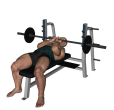 Barbell Press - Close Grip
Barbell Press - Close Grip
Benefits: This exercise works both heads of the triceps with a heavier weight than can typically be done with dumbbells. Note that the wider apart that you position your hands, the more the exercise works the chest and less the triceps.
Purpose: This exercise is used to target the triceps muscle to develop size, definition, strength, endurance and power.
Beginner Triceps Chest Shoulders Strength Barbell Flat Bench Push Compound Gym
General Info: The triceps is a straight muscle with three heads. The long head straightens the elbow, adducts the shoulder (brings it from a side position to the body) and extends the shoulder (brings the arm from a front position down to the body). The lateral head (outer head) straightens the elbow. The medial head also straightens the elbow.
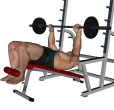 Barbell Press - Decline
Barbell Press - Decline
Benefits: This exercise works the chest muscles with a focus on your lower pecs.
Purpose: This exercise is used to target the lower pecs muscle to develop size, definition, strength, endurance and power.
Beginner Chest Triceps Shoulders Strength Barbell Decline Bench Push Compound Gym
General Info: The chest is composed of the Pectoralis Major and the Pectoralis Minor. The Pec Major attaches to the upper arm and pulls the upper arm across the chest. The Pec Minor lies mostly underneath the Pec Major and draws the shoulder blade down and forward.
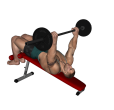 Barbell Press - Decline Guillotine
Barbell Press - Decline Guillotine
Benefits: This exercise works the chest muscles with a focus on your lower pecs.
Purpose: This exercise is used to target the lower pecs muscle to develop size, definition, strength, endurance and power.
Beginner Chest Triceps Shoulders Strength Barbell Decline Bench Push Compound Gym
General Info: The chest is composed of the Pectoralis Major and the Pectoralis Minor. The Pec Major attaches to the upper arm and pulls the upper arm across the chest. The Pec Minor lies mostly underneath the Pec Major and draws the shoulder blade down and forward.
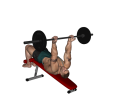 Barbell Press - Decline Reverse
Barbell Press - Decline Reverse
Benefits: This exercise works the chest muscles with a focus on your lower pecs.
Purpose: This exercise is used to target the lower pecs muscle to develop size, definition, strength, endurance and power.
Beginner Chest Triceps Shoulders Strength Barbell Decline Bench Push Compound Gym
General Info: The chest is composed of the Pectoralis Major and the Pectoralis Minor. The Pec Major attaches to the upper arm and pulls the upper arm across the chest. The Pec Minor lies mostly underneath the Pec Major and draws the shoulder blade down and forward.
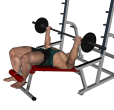 Barbell Press - Decline Reverse Wide Grip
Barbell Press - Decline Reverse Wide Grip
Benefits: This exercise works the chest muscles with a focus on your lower pecs.
Purpose: This exercise is used to target the lower pecs muscle to develop size, definition, strength, endurance and power.
Beginner Chest Triceps Shoulders Strength Barbell Decline Bench Push Compound Gym
General Info: The chest is composed of the Pectoralis Major and the Pectoralis Minor. The Pec Major attaches to the upper arm and pulls the upper arm across the chest. The Pec Minor lies mostly underneath the Pec Major and draws the shoulder blade down and forward.
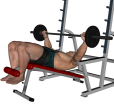 Barbell Press - Decline Wide Grip
Barbell Press - Decline Wide Grip
Benefits: This exercise works the chest muscles with a focus on your lower pecs.
Purpose: This exercise is used to target the lower pecs muscle to develop size, definition, strength, endurance and power.
Beginner Chest Triceps Shoulders Strength Barbell Decline Bench Push Compound Gym
General Info: The chest is composed of the Pectoralis Major and the Pectoralis Minor. The Pec Major attaches to the upper arm and pulls the upper arm across the chest. The Pec Minor lies mostly underneath the Pec Major and draws the shoulder blade down and forward.
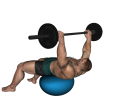 Barbell Press - Fitness Ball
Barbell Press - Fitness Ball
Benefits: A barbell allows someone to lift heavier weights and thus build more strength quicker.
Purpose: This exercise increases strength and strength speed, and produces greater functional strength for pressing movements.
Beginner Chest Triceps Anterior Delts Strength Barbell Fitness Ball Push Compound Gym
General Info: The chest is composed of the Pectoralis Major and the Pectoralis Minor. The Pec Major attaches to the upper arm and pulls the upper arm across the chest. The Pec Minor lies mostly underneath the Pec Major and draws the shoulder blade down and forward.
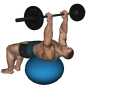 Barbell Press - Fitness Ball Guillotine
Barbell Press - Fitness Ball Guillotine
Benefits: A barbell allows someone to lift heavier weights and thus build more strength quicker.
Purpose: This exercise increases strength and strength speed, and produces greater functional strength for pressing movements.
Beginner Chest Triceps Anterior Delts Strength Barbell Fitness Ball Push Compound Gym
General Info: The chest is composed of the Pectoralis Major and the Pectoralis Minor. The Pec Major attaches to the upper arm and pulls the upper arm across the chest. The Pec Minor lies mostly underneath the Pec Major and draws the shoulder blade down and forward.
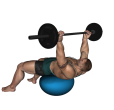 Barbell Press - Fitness Ball Reverse
Barbell Press - Fitness Ball Reverse
Benefits: A barbell allows someone to lift heavier weights and thus build more strength quicker.
Purpose: This exercise increases strength and strength speed, and produces greater functional strength for pressing movements.
Beginner Chest Triceps Anterior Delts Strength Barbell Fitness Ball Push Compound Gym
General Info: The chest is composed of the Pectoralis Major and the Pectoralis Minor. The Pec Major attaches to the upper arm and pulls the upper arm across the chest. The Pec Minor lies mostly underneath the Pec Major and draws the shoulder blade down and forward.
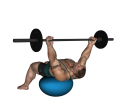 Barbell Press - Fitness Ball Reverse Wide
Barbell Press - Fitness Ball Reverse Wide
Benefits: A barbell allows someone to lift heavier weights and thus build more strength quicker.
Purpose: This exercise increases strength and strength speed, and produces greater functional strength for pressing movements.
Beginner Chest Triceps Anterior Delts Strength Barbell Fitness Ball Push Compound Gym
General Info: The chest is composed of the Pectoralis Major and the Pectoralis Minor. The Pec Major attaches to the upper arm and pulls the upper arm across the chest. The Pec Minor lies mostly underneath the Pec Major and draws the shoulder blade down and forward.
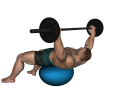 Barbell Press - Fitness Ball Wide Grip
Barbell Press - Fitness Ball Wide Grip
Benefits: A barbell allows someone to lift heavier weights and thus build more strength quicker.
Purpose: This exercise increases strength and strength speed, and produces greater functional strength for pressing movements.
Beginner Chest Triceps Anterior Delts Strength Barbell Fitness Ball Push Compound Gym
General Info: The chest is composed of the Pectoralis Major and the Pectoralis Minor. The Pec Major attaches to the upper arm and pulls the upper arm across the chest. The Pec Minor lies mostly underneath the Pec Major and draws the shoulder blade down and forward.
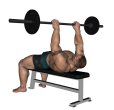 Barbell Press - Flat Bench
Barbell Press - Flat Bench
Benefits: This is the basic chest exercise.
Purpose: Benefits A barbell allows someone to lift heavier weights and thus build more strength quicker.
Beginner Chest Triceps Anterior Delts Strength Barbell Flat Bench Push Compound Gym
General Info: The chest is composed of the Pectoralis Major and the Pectoralis Minor. The Pec Major attaches to the upper arm and pulls the upper arm across the chest. The Pec Minor lies mostly underneath the Pec Major and draws the shoulder blade down and forward.
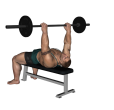 Barbell Press - Flat Bench and Flye
Barbell Press - Flat Bench and Flye
Benefits: A barbell allows someone to lift heavier weights and thus build more strength quicker.
Purpose: This exercise increases strength and strength speed, and produces greater functional strength for pressing movements.
Intermediate Chest Triceps Anterior Delts Strength Barbell Flat Bench Push Compound Gym
General Info: The chest is composed of the Pectoralis Major and the Pectoralis Minor. The Pec Major attaches to the upper arm and pulls the upper arm across the chest. The Pec Minor lies mostly underneath the Pec Major and draws the shoulder blade down and forward.
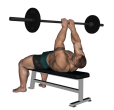 Barbell Press - Flat Bench Close Grip
Barbell Press - Flat Bench Close Grip
Benefits: This exercise works both heads of the triceps with a heavier weight than can typically be done with dumbbells. The closer you position your hands the more the exercise works the triceps.
Purpose: This exercise is used to target the triceps muscle to develop size, definition, strength, endurance and power.
Beginner Triceps Chest Shoulders Strength Barbell Flat Bench Push Compound Gym
General Info: The triceps is a straight muscle with three heads. The long head straightens the elbow, adducts the shoulder (brings it from a side position to the body) and extends the shoulder (brings the arm from a front position down to the body). The lateral head (outer head) straightens the elbow. The medial head also straightens the elbow.
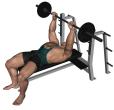 Barbell Press - Flat Bench Guillotine
Barbell Press - Flat Bench Guillotine
Benefits: A barbell allows someone to lift heavier weights and thus build more strength quicker.
Purpose: This exercise increases strength and strength speed, and produces greater functional strength for pressing movements.
Beginner Chest Triceps Anterior Delts Strength Barbell Flat Bench Push Compound Gym
General Info: The chest is composed of the Pectoralis Major and the Pectoralis Minor. The Pec Major attaches to the upper arm and pulls the upper arm across the chest. The Pec Minor lies mostly underneath the Pec Major and draws the shoulder blade down and forward.
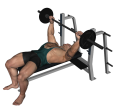 Barbell Press - Flat Bench Guillotine Wide Grip
Barbell Press - Flat Bench Guillotine Wide Grip
Benefits: A barbell allows someone to lift heavier weights and thus build more strength quicker.
Purpose: This exercise increases strength and strength speed, and produces greater functional strength for pressing movements.
Beginner Chest Triceps Anterior Delts Strength Barbell Flat Bench Push Compound Gym
General Info: The chest is composed of the Pectoralis Major and the Pectoralis Minor. The Pec Major attaches to the upper arm and pulls the upper arm across the chest. The Pec Minor lies mostly underneath the Pec Major and draws the shoulder blade down and forward.
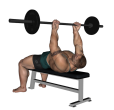 Barbell Press - Flat Bench Reverse
Barbell Press - Flat Bench Reverse
Benefits: A barbell allows someone to lift heavier weights and thus build more strength quicker. The reverse grip makes the exercise more difficult.
Purpose: This exercise increases strength and strength speed, and produces greater functional strength for pressing movements.
Beginner Chest Triceps Anterior Delts Strength Barbell Flat Bench Push Compound Gym
General Info: The chest is composed of the Pectoralis Major and the Pectoralis Minor. The Pec Major attaches to the upper arm and pulls the upper arm across the chest. The Pec Minor lies mostly underneath the Pec Major and draws the shoulder blade down and forward.
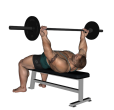 Barbell Press - Flat Bench Reverse Wide
Barbell Press - Flat Bench Reverse Wide
Benefits: A barbell allows someone to lift heavier weights and thus build more strength quicker. The reverse grip makes the exercise more difficult.
Purpose: This exercise increases strength and strength speed, and produces greater functional strength for pressing movements.
Beginner Chest Triceps Anterior Delts Strength Barbell Flat Bench Push Compound Gym
General Info: The chest is composed of the Pectoralis Major and the Pectoralis Minor. The Pec Major attaches to the upper arm and pulls the upper arm across the chest. The Pec Minor lies mostly underneath the Pec Major and draws the shoulder blade down and forward.
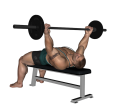 Barbell Press - Flat Bench Reverse Wide Feet Up
Barbell Press - Flat Bench Reverse Wide Feet Up
Benefits: A barbell allows someone to lift heavier weights and thus build more strength quicker.
Purpose: This exercise increases strength and strength speed, and produces greater functional strength for pressing movements.
Beginner Chest Triceps Anterior Delts Strength Barbell Flat Bench Push Compound Gym
General Info: The chest is composed of the Pectoralis Major and the Pectoralis Minor. The Pec Major attaches to the upper arm and pulls the upper arm across the chest. The Pec Minor lies mostly underneath the Pec Major and draws the shoulder blade down and forward.
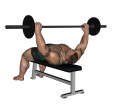 Barbell Press - Flat Bench Wide Grip
Barbell Press - Flat Bench Wide Grip
Benefits: A barbell allows someone to lift heavier weights and thus build more strength quicker.
Purpose: This exercise increases strength and strength speed, and produces greater functional strength for pressing movements.
Beginner Chest Triceps Anterior Delts Strength Barbell Flat Bench Push Compound Gym
General Info: The chest is composed of the Pectoralis Major and the Pectoralis Minor. The Pec Major attaches to the upper arm and pulls the upper arm across the chest. The Pec Minor lies mostly underneath the Pec Major and draws the shoulder blade down and forward.
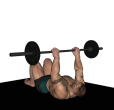 Barbell Press - Floor
Barbell Press - Floor
Benefits: A barbell allows someone to lift heavier weights and thus build more strength quicker.
Purpose: This exercise increases strength and strength speed, and produces greater functional strength for pressing movements.
Beginner Chest Triceps Anterior Delts Strength Barbell Push Compound Gym
General Info: The chest is composed of the Pectoralis Major and the Pectoralis Minor. The Pec Major attaches to the upper arm and pulls the upper arm across the chest. The Pec Minor lies mostly underneath the Pec Major and draws the shoulder blade down and forward.
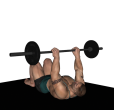 Barbell Press - Floor and Flye
Barbell Press - Floor and Flye
Benefits: A barbell allows someone to lift heavier weights and thus build more strength quicker. While this is primarily a chest movement, it also works the anterior deltoids.
Purpose: This exercise increases strength and strength speed, and produces greater functional strength for pressing movements.
Intermediate Chest Triceps Anterior Delts Strength Barbell Push Compound Gym
General Info: The chest is composed of the Pectoralis Major and the Pectoralis Minor. The Pec Major attaches to the upper arm and pulls the upper arm across the chest. The Pec Minor lies mostly underneath the Pec Major and draws the shoulder blade down and forward.
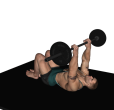 Barbell Press - Floor Guillotine
Barbell Press - Floor Guillotine
Benefits: A barbell allows someone to lift heavier weights and thus build more strength quicker.
Purpose: This exercise increases strength and strength speed, and produces greater functional strength for pressing movements.
Beginner Chest Triceps Anterior Delts Strength Barbell Push Compound Gym
General Info: The chest is composed of the Pectoralis Major and the Pectoralis Minor. The Pec Major attaches to the upper arm and pulls the upper arm across the chest. The Pec Minor lies mostly underneath the Pec Major and draws the shoulder blade down and forward.
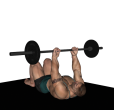 Barbell Press - Floor Reverse
Barbell Press - Floor Reverse
Benefits: A barbell allows someone to lift heavier weights and thus build more strength quicker. The reverse grip makes the exercise more difficult.
Purpose: This exercise increases strength and strength speed, and produces greater functional strength for pressing movements.
Beginner Chest Triceps Anterior Delts Strength Barbell Push Compound Gym
General Info: The chest is composed of the Pectoralis Major and the Pectoralis Minor. The Pec Major attaches to the upper arm and pulls the upper arm across the chest. The Pec Minor lies mostly underneath the Pec Major and draws the shoulder blade down and forward.
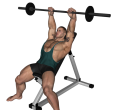 Barbell Press - Incline
Barbell Press - Incline
Benefits: This exercise works the chest muscles with a focus on your upper pecs. You can usually set the incline bench to different angles from the horizontal. The more of an angle you use, the more you are working the upper pecs.
Purpose: This exercise is used to target the upper pecs muscle to develop size, definition, strength, endurance and power.
Beginner Chest Triceps Shoulders Strength Barbell Incline Bench Push Compound Gym
General Info: The chest is composed of the Pectoralis Major and the Pectoralis Minor. The Pec Major attaches to the upper arm and pulls the upper arm across the chest. The Pec Minor lies mostly underneath the Pec Major and draws the shoulder blade down and forward.
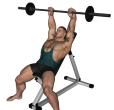 Barbell Press - Incline and Flye
Barbell Press - Incline and Flye
Benefits: A barbell allows someone to lift heavier weights and thus build more strength quicker. While this is primarily a chest movement, it also works the anterior deltoids.
Purpose: This exercise increases strength and strength speed, and produces greater functional strength for pressing movements.
Intermediate Chest Triceps Anterior Delts Strength Barbell Incline Bench Push Compound Gym
General Info: The chest is composed of the Pectoralis Major and the Pectoralis Minor. The Pec Major attaches to the upper arm and pulls the upper arm across the chest. The Pec Minor lies mostly underneath the Pec Major and draws the shoulder blade down and forward.
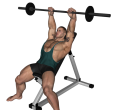 Barbell Press - Incline Guillotine
Barbell Press - Incline Guillotine
Benefits: A barbell allows someone to lift heavier weights and thus build more strength quicker.
Purpose: This exercise increases strength and strength speed, and produces greater functional strength for pressing movements.
Beginner Chest Triceps Anterior Delts Strength Barbell Incline Bench Push Compound Gym
General Info: The chest is composed of the Pectoralis Major and the Pectoralis Minor. The Pec Major attaches to the upper arm and pulls the upper arm across the chest. The Pec Minor lies mostly underneath the Pec Major and draws the shoulder blade down and forward.
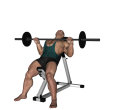 Barbell Press - Incline Medium Grip
Barbell Press - Incline Medium Grip
Benefits: This exercise works the chest muscles with a focus on your upper pecs.
Purpose: This exercise is used to target the upper pecs muscle to develop size, definition, strength, endurance and power.
Beginner Chest Triceps Shoulders Strength Barbell Incline Bench Push Compound Gym
General Info: The chest is composed of the Pectoralis Major and the Pectoralis Minor. The Pec Major attaches to the upper arm and pulls the upper arm across the chest. The Pec Minor lies mostly underneath the Pec Major and draws the shoulder blade down and forward.
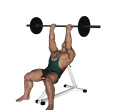 Barbell Press - Incline Reverse
Barbell Press - Incline Reverse
Benefits: A barbell allows someone to lift heavier weights and thus build more strength quicker.
Purpose: This exercise increases strength and strength speed, and produces greater functional strength for pressing movements.
Beginner Chest Triceps Anterior Delts Strength Barbell Incline Bench Push Compound Gym
General Info: The chest is composed of the Pectoralis Major and the Pectoralis Minor. The Pec Major attaches to the upper arm and pulls the upper arm across the chest. The Pec Minor lies mostly underneath the Pec Major and draws the shoulder blade down and forward.
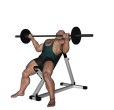 Barbell Press - Incline Reverse Wide
Barbell Press - Incline Reverse Wide
Benefits: A barbell allows someone to lift heavier weights and thus build more strength quicker.
Purpose: This exercise increases strength and strength speed, and produces greater functional strength for pressing movements.
Beginner Chest Triceps Anterior Delts Strength Barbell Incline Bench Push Compound Gym
General Info: The chest is composed of the Pectoralis Major and the Pectoralis Minor. The Pec Major attaches to the upper arm and pulls the upper arm across the chest. The Pec Minor lies mostly underneath the Pec Major and draws the shoulder blade down and forward.
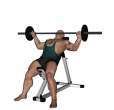 Barbell Press - Incline Wide Grip
Barbell Press - Incline Wide Grip
Benefits: This exercise works the chest muscles with a focus on your upper pecs.
Purpose: This exercise is used to target the upper pecs muscle to develop size, definition, strength, endurance and power.
Beginner Chest Triceps Shoulders Strength Barbell Incline Bench Push Compound Gym
General Info: The chest is composed of the Pectoralis Major and the Pectoralis Minor. The Pec Major attaches to the upper arm and pulls the upper arm across the chest. The Pec Minor lies mostly underneath the Pec Major and draws the shoulder blade down and forward.
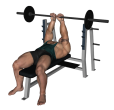 Barbell Press - JM
Barbell Press - JM
Benefits: A barbell allows someone to lift heavier weights and thus build more strength quicker.
Purpose: This exercise increases strength and strength speed, and produces greater functional strength for pressing movements.
Intermediate Chest Triceps Anterior Delts Strength Barbell Flat Bench Push Compound Gym
General Info: The chest is composed of the Pectoralis Major and the Pectoralis Minor. The Pec Major attaches to the upper arm and pulls the upper arm across the chest. The Pec Minor lies mostly underneath the Pec Major and draws the shoulder blade down and forward.
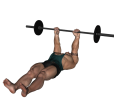 Barbell Press - Lying Floor
Barbell Press - Lying Floor
Benefits: A barbell allows someone to lift heavier weights and thus build more strength quicker.
Purpose: This exercise increases strength and strength speed, and produces greater functional strength for pressing movements.
Beginner Chest Triceps Anterior Delts Strength Barbell Push Compound Gym
General Info: The chest is composed of the Pectoralis Major and the Pectoralis Minor. The Pec Major attaches to the upper arm and pulls the upper arm across the chest. The Pec Minor lies mostly underneath the Pec Major and draws the shoulder blade down and forward.
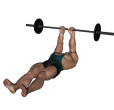 Barbell Press - Lying Floor Close Grip
Barbell Press - Lying Floor Close Grip
Benefits: The exercise eliminates isolates the triceps.
Purpose: This exercise works primarily the triceps.
Intermediate Chest Triceps Anterior Delts Strength Barbell Push Compound Gym
General Info: The triceps is a straight muscle with three heads. The long head straightens the elbow, adducts the shoulder (brings it from a side position to the body) and extends the shoulder (brings the arm from a front position down to the body). The lateral head (outer head) straightens the elbow. The medial head also straightens the elbow.
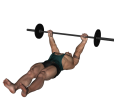 Barbell Press - Lying Floor Wide Grip
Barbell Press - Lying Floor Wide Grip
Benefits: A barbell allows someone to lift heavier weights and thus build more strength quicker.
Purpose: This exercise increases strength and strength speed, and produces greater functional strength for pressing movements.
Beginner Chest Triceps Anterior Delts Strength Barbell Push Compound Gym
General Info: The chest is composed of the Pectoralis Major and the Pectoralis Minor. The Pec Major attaches to the upper arm and pulls the upper arm across the chest. The Pec Minor lies mostly underneath the Pec Major and draws the shoulder blade down and forward.
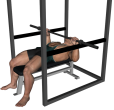 Barbell Press - Pin
Barbell Press - Pin
Benefits: A barbell allows someone to lift heavier weights and thus build more strength quicker. This exercise can be used for focusing on a desired point in the range of motion.
Purpose: This exercise increases strength and strength speed, and produces greater functional strength for pressing movements.
Intermediate Chest Triceps Anterior Delts Strength Power Rack Barbell Push Compound Gym
General Info: The chest is composed of the Pectoralis Major and the Pectoralis Minor. The Pec Major attaches to the upper arm and pulls the upper arm across the chest. The Pec Minor lies mostly underneath the Pec Major and draws the shoulder blade down and forward.
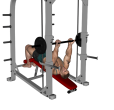 Barbell Press - Smith Decline Reverse Guillotine
Barbell Press - Smith Decline Reverse Guillotine
Benefits: A barbell allows someone to lift heavier weights and thus build more strength quicker. The reverse grip makes the exercise more difficult.
Purpose: This exercise increases strength and strength speed, and produces greater functional strength for pressing movements in the lower pecs.
Intermediate Chest Triceps Anterior Delts Strength Smith Machine Decline Bench Push Compound Gym
General Info: The chest is composed of the Pectoralis Major and the Pectoralis Minor. The Pec Major attaches to the upper arm and pulls the upper arm across the chest. The Pec Minor lies mostly underneath the Pec Major and draws the shoulder blade down and forward.
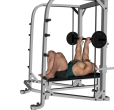 Barbell Press - Smith Feet Up Reverse Guillotine
Barbell Press - Smith Feet Up Reverse Guillotine
Benefits: A barbell allows someone to lift heavier weights and thus build more strength quicker. The reverse grip makes the exercise more difficult.
Purpose: This exercise increases strength and strength speed, and produces greater functional strength for pressing movements.
Intermediate Chest Triceps Anterior Delts Strength Smith Machine Flat Bench Push Compound Gym
General Info: The chest is composed of the Pectoralis Major and the Pectoralis Minor. The Pec Major attaches to the upper arm and pulls the upper arm across the chest. The Pec Minor lies mostly underneath the Pec Major and draws the shoulder blade down and forward.
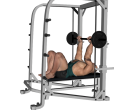 Barbell Press - Smith Flat Feet Up Guillotine
Barbell Press - Smith Flat Feet Up Guillotine
Benefits: A barbell allows someone to lift heavier weights and thus build more strength quicker.
Purpose: This exercise increases strength and strength speed, and produces greater functional strength for pressing movements.
Intermediate Chest Triceps Anterior Delts Strength Smith Machine Flat Bench Push Compound Gym
General Info: The chest is composed of the Pectoralis Major and the Pectoralis Minor. The Pec Major attaches to the upper arm and pulls the upper arm across the chest. The Pec Minor lies mostly underneath the Pec Major and draws the shoulder blade down and forward.
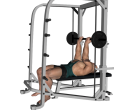 Barbell Press - Smith Flat Reverse Guillotine
Barbell Press - Smith Flat Reverse Guillotine
Benefits: A barbell allows someone to lift heavier weights and thus build more strength quicker. The reverse grip makes the exercise more difficult.
Purpose: This exercise increases strength and strength speed, and produces greater functional strength for pressing movements.
Intermediate Chest Triceps Anterior Delts Strength Smith Machine Flat Bench Push Compound Gym
General Info: The chest is composed of the Pectoralis Major and the Pectoralis Minor. The Pec Major attaches to the upper arm and pulls the upper arm across the chest. The Pec Minor lies mostly underneath the Pec Major and draws the shoulder blade down and forward.
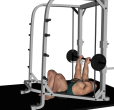 Barbell Press - Smith Floor Guillotine Reverse
Barbell Press - Smith Floor Guillotine Reverse
Benefits: A barbell allows someone to lift heavier weights and thus build more strength quicker. The reverse grip makes the exercise more difficult.
Purpose: This exercise increases strength and strength speed, and produces greater functional strength for pressing movements.
Intermediate Chest Triceps Anterior Delts Strength Smith Machine Push Compound Gym
General Info: The chest is composed of the Pectoralis Major and the Pectoralis Minor. The Pec Major attaches to the upper arm and pulls the upper arm across the chest. The Pec Minor lies mostly underneath the Pec Major and draws the shoulder blade down and forward.
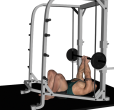 Barbell Press - Smith Floor Reverse Close Grip
Barbell Press - Smith Floor Reverse Close Grip
Benefits: The exercise eliminates isolates the triceps. The reverse grip makes the exercise more difficult.
Purpose: This exercise works primarily the triceps.
Intermediate Chest Triceps Anterior Delts Strength Smith Machine Push Compound Gym
General Info: The triceps is a straight muscle with three heads. The long head straightens the elbow, adducts the shoulder (brings it from a side position to the body) and extends the shoulder (brings the arm from a front position down to the body). The lateral head (outer head) straightens the elbow. The medial head also straightens the elbow.
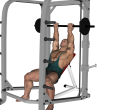 Barbell Press - Smith Incline Reverse Guillotine
Barbell Press - Smith Incline Reverse Guillotine
Benefits: A barbell allows someone to lift heavier weights and thus build more strength quicker. The reverse grip makes the exercise more difficult.
Purpose: This exercise increases strength and strength speed, and produces greater functional strength for pressing movements.
Intermediate Chest Triceps Anterior Delts Strength Smith Machine Incline Bench Push Compound Gym
General Info: The chest is composed of the Pectoralis Major and the Pectoralis Minor. The Pec Major attaches to the upper arm and pulls the upper arm across the chest. The Pec Minor lies mostly underneath the Pec Major and draws the shoulder blade down and forward.
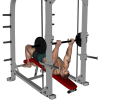 Barbell Press - Smith Machine Decline Guillotine
Barbell Press - Smith Machine Decline Guillotine
Benefits: A barbell allows someone to lift heavier weights and thus build more strength quicker.
Purpose: This exercise increases strength and strength speed, and produces greater functional strength for pressing movements.
Intermediate Chest Triceps Anterior Delts Strength Smith Machine Decline Bench Push Compound Gym
General Info: The chest is composed of the Pectoralis Major and the Pectoralis Minor. The Pec Major attaches to the upper arm and pulls the upper arm across the chest. The Pec Minor lies mostly underneath the Pec Major and draws the shoulder blade down and forward.
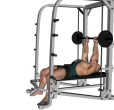 Barbell Press - Smith Machine Flat Guillotine
Barbell Press - Smith Machine Flat Guillotine
Benefits: A barbell allows someone to lift heavier weights and thus build more strength quicker.
Purpose: This exercise increases strength and strength speed, and produces greater functional strength for pressing movements.
Intermediate Chest Triceps Anterior Delts Strength Smith Machine Flat Bench Push Compound Gym
General Info: The chest is composed of the Pectoralis Major and the Pectoralis Minor. The Pec Major attaches to the upper arm and pulls the upper arm across the chest. The Pec Minor lies mostly underneath the Pec Major and draws the shoulder blade down and forward.
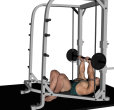 Barbell Press - Smith Machine Floor
Barbell Press - Smith Machine Floor
Benefits: A barbell allows someone to lift heavier weights and thus build more strength quicker.
Purpose: This exercise increases strength and strength speed, and produces greater functional strength for pressing movements.
Intermediate Chest Triceps Anterior Delts Strength Smith Machine Push Compound Gym
General Info: The chest is composed of the Pectoralis Major and the Pectoralis Minor. The Pec Major attaches to the upper arm and pulls the upper arm across the chest. The Pec Minor lies mostly underneath the Pec Major and draws the shoulder blade down and forward.
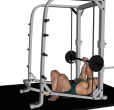 Barbell Press - Smith Machine Floor Close Grip
Barbell Press - Smith Machine Floor Close Grip
Benefits: The exercise eliminates isolates the triceps.
Purpose: This exercise works primarily the triceps.
Intermediate Chest Triceps Anterior Delts Strength Smith Machine Push Compound Gym
General Info: The triceps is a straight muscle with three heads. The long head straightens the elbow, adducts the shoulder (brings it from a side position to the body) and extends the shoulder (brings the arm from a front position down to the body). The lateral head (outer head) straightens the elbow. The medial head also straightens the elbow.
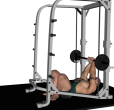 Barbell Press - Smith Machine Floor Guillotine
Barbell Press - Smith Machine Floor Guillotine
Benefits: A barbell allows someone to lift heavier weights and thus build more strength quicker.
Purpose: This exercise increases strength and strength speed, and produces greater functional strength for pressing movements.
Intermediate Chest Triceps Anterior Delts Strength Smith Machine Push Compound Gym
General Info: The chest is composed of the Pectoralis Major and the Pectoralis Minor. The Pec Major attaches to the upper arm and pulls the upper arm across the chest. The Pec Minor lies mostly underneath the Pec Major and draws the shoulder blade down and forward.
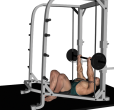 Barbell Press - Smith Machine Floor Reverse
Barbell Press - Smith Machine Floor Reverse
Benefits: A barbell allows someone to lift heavier weights and thus build more strength quicker. The reverse grip makes the exercise more difficult.
Purpose: This exercise increases strength and strength speed, and produces greater functional strength for pressing movements.
Intermediate Chest Triceps Anterior Delts Strength Smith Machine Push Compound Gym
General Info: The chest is composed of the Pectoralis Major and the Pectoralis Minor. The Pec Major attaches to the upper arm and pulls the upper arm across the chest. The Pec Minor lies mostly underneath the Pec Major and draws the shoulder blade down and forward.
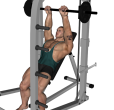 Barbell Press - Smith Machine Incline Guillotine
Barbell Press - Smith Machine Incline Guillotine
Benefits: A barbell allows someone to lift heavier weights and thus build more strength quicker.
Purpose: This exercise increases strength and strength speed, and produces greater functional strength for pressing movements.
Intermediate Chest Triceps Anterior Delts Strength Smith Machine Incline Bench Push Compound Gym
General Info: The chest is composed of the Pectoralis Major and the Pectoralis Minor. The Pec Major attaches to the upper arm and pulls the upper arm across the chest. The Pec Minor lies mostly underneath the Pec Major and draws the shoulder blade down and forward.
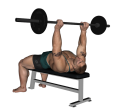 Barbell Press - To Neck
Barbell Press - To Neck
Benefits: A barbell allows someone to lift heavier weights and thus build more strength quicker.
Purpose: This exercise increases strength and strength speed, and produces greater functional strength for pressing movements.
Beginner Chest Triceps Anterior Delts Strength Barbell Flat Bench Push Compound Gym
General Info: The chest is composed of the Pectoralis Major and the Pectoralis Minor. The Pec Major attaches to the upper arm and pulls the upper arm across the chest. The Pec Minor lies mostly underneath the Pec Major and draws the shoulder blade down and forward.
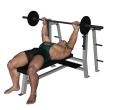 Barbell Press - Wide Grip
Barbell Press - Wide Grip
Benefits: A barbell allows someone to lift heavier weights and thus build more strength quicker.
Purpose: This exercise increases strength and strength speed, and produces greater functional strength for pressing movements.
Beginner Chest Triceps Anterior Delts Strength Barbell Flat Bench Push Compound Gym
General Info: The chest is composed of the Pectoralis Major and the Pectoralis Minor. The Pec Major attaches to the upper arm and pulls the upper arm across the chest. The Pec Minor lies mostly underneath the Pec Major and draws the shoulder blade down and forward.
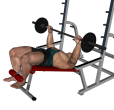 Barbell Press - Wide Grip Decline
Barbell Press - Wide Grip Decline
Benefits: This exercise works the chest muscles with a focus on your lower pecs.
Purpose: This exercise is used to target the lower pecs muscle to develop size, definition, strength, endurance and power.
Beginner Chest Triceps Shoulders Strength Barbell Decline Bench Push Compound Gym
General Info: The chest is composed of the Pectoralis Major and the Pectoralis Minor. The Pec Major attaches to the upper arm and pulls the upper arm across the chest. The Pec Minor lies mostly underneath the Pec Major and draws the shoulder blade down and forward.
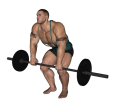 Barbell Row - Basic
Barbell Row - Basic
Benefits: This exercise is a strong, effective free weight back exercise for building muscle mass and size of the lats.
Purpose: This is a good exercise for increasing strength and size in the upper back.
Intermediate Traps Lats Triceps Posterior Delts Strength Barbell Pull Compound Gym
General Info: There are a number of muscles in the back, although the two major muscles are the lats and traps. The lats pulls the arm back and down towards the spine. The traps pull the shoulder blades back and towards the spine.
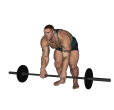 Barbell Row - Bent Over
Barbell Row - Bent Over
Benefits: This exercise is a strong, effective free weight back exercise for building muscle mass and size of the lats.
Purpose: This is a good exercise for increasing strength and size in the upper back.
Intermediate Traps Lats Triceps Posterior Delts Strength Barbell Pull Compound Gym
General Info: There are a number of muscles in the back, although the two major muscles are the lats and traps. The lats pulls the arm back and down towards the spine. The traps pull the shoulder blades back and towards the spine.
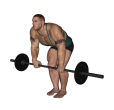 Barbell Row - Bent Over Narrow Stance
Barbell Row - Bent Over Narrow Stance
Benefits: This exercise is a strong, effective free weight back exercise for building muscle mass and size of the lats.
Purpose: This is a good exercise for increasing strength and size in the upper back.
Intermediate Traps Lats Triceps Posterior Delts Strength Barbell Pull Compound Gym
General Info: There are a number of muscles in the back, although the two major muscles are the lats and traps. The lats pulls the arm back and down towards the spine. The traps pull the shoulder blades back and towards the spine.
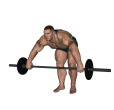 Barbell Row - Bent Over Wide Grip
Barbell Row - Bent Over Wide Grip
Benefits: This exercise is a strong, effective free weight back exercise for building muscle mass and size of the lats.
Purpose: This is a good exercise for increasing strength and size in the upper back.
Intermediate Traps Lats Triceps Posterior Delts Strength Barbell Pull Compound Gym
General Info: There are a number of muscles in the back, although the two major muscles are the lats and traps. The lats pulls the arm back and down towards the spine. The traps pull the shoulder blades back and towards the spine.
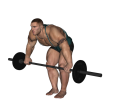 Barbell Row - Bent Over Wide Grip Close Stance
Barbell Row - Bent Over Wide Grip Close Stance
Benefits: This exercise is a strong, effective free weight back exercise for building muscle mass and size of the lats.
Purpose: This is a good exercise for increasing strength and size in the upper back.
Intermediate Traps Lats Triceps Posterior Delts Strength Barbell Pull Compound Gym
General Info: There are a number of muscles in the back, although the two major muscles are the lats and traps. The lats pulls the arm back and down towards the spine. The traps pull the shoulder blades back and towards the spine.
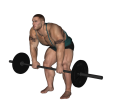 Barbell Row - Bent Over Wide Stance
Barbell Row - Bent Over Wide Stance
Benefits: This exercise is a strong, effective free weight back exercise for building muscle mass and size of the lats.
Purpose: This is a good exercise for increasing strength and size in the upper back.
Intermediate Traps Lats Triceps Posterior Delts Strength Barbell Pull Compound Gym
General Info: There are a number of muscles in the back, although the two major muscles are the lats and traps. The lats pulls the arm back and down towards the spine. The traps pull the shoulder blades back and towards the spine.
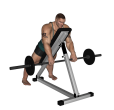 Barbell Row - Incline
Barbell Row - Incline
Benefits: This exercise is a strong, effective free weight back exercise for building muscle mass and size of the lats.
Purpose: This is a good exercise for increasing strength and size in the upper back.
Intermediate Traps Lats Triceps Posterior Delts Strength Barbell Incline Bench Pull Compound Gym
General Info: There are a number of muscles in the back, although the two major muscles are the lats and traps. The lats pulls the arm back and down towards the spine. The traps pull the shoulder blades back and towards the spine.
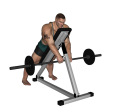 Barbell Row - Incline Close Grip
Barbell Row - Incline Close Grip
Benefits: This exercise is a strong, effective free weight back exercise for building muscle mass and size of the lats.
Purpose: This is a good exercise for increasing strength and size in the upper back.
Intermediate Traps Lats Triceps Posterior Delts Strength Barbell Incline Bench Pull Compound Gym
General Info: There are a number of muscles in the back, although the two major muscles are the lats and traps. The lats pulls the arm back and down towards the spine. The traps pull the shoulder blades back and towards the spine.
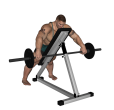 Barbell Row - Incline Wide Grip
Barbell Row - Incline Wide Grip
Benefits: This exercise is a strong, effective free weight back exercise for building muscle mass and size of the lats.
Purpose: This is a good exercise for increasing strength and size in the upper back.
Intermediate Traps Lats Triceps Posterior Delts Strength Barbell Incline Bench Pull Compound Gym
General Info: There are a number of muscles in the back, although the two major muscles are the lats and traps. The lats pulls the arm back and down towards the spine. The traps pull the shoulder blades back and towards the spine.
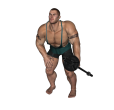 Barbell Row - Single Arm
Barbell Row - Single Arm
Benefits: This exercise is a strong, effective free weight back exercise for building muscle mass and size of the lats.
Purpose: This is a good exercise for increasing strength and size in the upper back.
Intermediate Traps Lats Triceps Posterior Delts Strength Barbell Pull Compound Gym
General Info: There are a number of muscles in the back, although the two major muscles are the lats and traps. The lats pulls the arm back and down towards the spine. The traps pull the shoulder blades back and towards the spine.
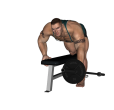 Barbell Row - Single Arm Bench
Barbell Row - Single Arm Bench
Benefits: This exercise is a strong, effective free weight back exercise for building muscle mass and size of the lats.
Purpose: This is a good exercise for increasing strength and size in the upper back.
Intermediate Traps Lats Triceps Posterior Delts Strength Barbell Flat Bench Pull Compound Gym
General Info: There are a number of muscles in the back, although the two major muscles are the lats and traps. The lats pulls the arm back and down towards the spine. The traps pull the shoulder blades back and towards the spine.
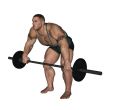 Barbell Row - Wide Grip
Barbell Row - Wide Grip
Benefits: This exercise is a strong, effective free weight back exercise for building muscle mass and size of the lats.
Purpose: This is a good exercise for increasing strength and size in the upper back.
Intermediate Traps Lats Triceps Posterior Delts Strength Barbell Pull Compound Gym
General Info: There are a number of muscles in the back, although the two major muscles are the lats and traps. The lats pulls the arm back and down towards the spine. The traps pull the shoulder blades back and towards the spine.
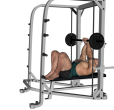 Bench Press - Close Grip Smith Machine Feet Up
Bench Press - Close Grip Smith Machine Feet Up
Benefits: This exercise works both heads of the triceps with a heavier weight than can typically be done with dumbbells.
Purpose: This exercise is used to target the triceps muscle to develop size, definition, strength, endurance and power.
Beginner Triceps Chest Shoulders Strength Smith Machine Flat Bench Push Compound Gym
General Info: The triceps is a straight muscle with three heads. The long head straightens the elbow, adducts the shoulder (brings it from a side position to the body) and extends the shoulder (brings the arm from a front position down to the body). The lateral head (outer head) straightens the elbow. The medial head also straightens the elbow.
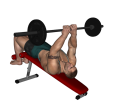 Bench Press - Decline Skull Crusher
Bench Press - Decline Skull Crusher
Benefits: This exercise works both heads of the triceps with a heavier weight than can typically be done with dumbbells.
Purpose: This exercise is used to target the triceps muscle to develop size, definition, strength, endurance and power.
Beginner Triceps Chest Shoulders Strength Barbell Decline Bench Push Compound Gym
General Info: The triceps is a straight muscle with three heads. The long head straightens the elbow, adducts the shoulder (brings it from a side position to the body) and extends the shoulder (brings the arm from a front position down to the body). The lateral head (outer head) straightens the elbow. The medial head also straightens the elbow.
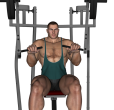 Bench Press - Machine
Bench Press - Machine
Benefits: A barbell allows someone to lift heavier weights and thus build more strength quicker.
Purpose: This exercise increases strength and strength speed, and produces greater functional strength for pressing movements.
Beginner Chest Triceps Anterior Delts Strength Chest Press Machine Push Compound Gym
General Info: The chest is composed of the Pectoralis Major and the Pectoralis Minor. The Pec Major attaches to the upper arm and pulls the upper arm across the chest. The Pec Minor lies mostly underneath the Pec Major and draws the shoulder blade down and forward.
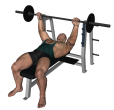 Bench Press - Medium Grip Barbell
Bench Press - Medium Grip Barbell
Benefits: A barbell allows someone to lift heavier weights and thus build more strength quicker.
Purpose: This exercise increases strength and strength speed, and produces greater functional strength for pressing movements.
Beginner Chest Triceps Anterior Delts Strength Barbell Flat Bench Push Compound Gym
General Info: The chest is composed of the Pectoralis Major and the Pectoralis Minor. The Pec Major attaches to the upper arm and pulls the upper arm across the chest. The Pec Minor lies mostly underneath the Pec Major and draws the shoulder blade down and forward.
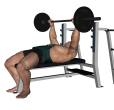 Bench Press - Powerlifting
Bench Press - Powerlifting
Benefits: A barbell allows someone to lift heavier weights and thus build more strength quicker.
Purpose: This exercise increases strength and strength speed, and produces greater functional strength for pressing movements.
Chest Triceps Anterior Delts Strength Barbell Flat Bench Push Compound Gym
General Info: The chest is composed of the Pectoralis Major and the Pectoralis Minor. The Pec Major attaches to the upper arm and pulls the upper arm across the chest. The Pec Minor lies mostly underneath the Pec Major and draws the shoulder blade down and forward.
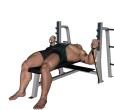 Bench Press - Reverse Band
Bench Press - Reverse Band
Benefits: A barbell allows someone to lift heavier weights and thus build more strength quicker.
Purpose: This exercise increases strength and strength speed, and produces greater functional strength for pressing movements.
Beginner Chest Triceps Anterior Delts Strength Power Rack Band Flat Bench Push Compound Gym
General Info: The chest is composed of the Pectoralis Major and the Pectoralis Minor. The Pec Major attaches to the upper arm and pulls the upper arm across the chest. The Pec Minor lies mostly underneath the Pec Major and draws the shoulder blade down and forward.
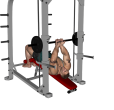 Bench Press - Smith Decline Reverse Close
Bench Press - Smith Decline Reverse Close
Benefits: This exercise works both heads of the triceps with a heavier weight than can typically be done with dumbbells. It also works the lower spec. The reverse grip makes the exercise more difficult.
Purpose: This exercise is used to target the triceps muscle to develop size, definition, strength, endurance and power.
Beginner Triceps Chest Shoulders Strength Smith Machine Decline Bench Push Compound Gym
General Info: The triceps is a straight muscle with three heads. The long head straightens the elbow, adducts the shoulder (brings it from a side position to the body) and extends the shoulder (brings the arm from a front position down to the body). The lateral head (outer head) straightens the elbow. The medial head also straightens the elbow.
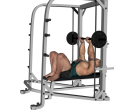 Bench Press - Smith Feet On Bench
Bench Press - Smith Feet On Bench
Benefits: A machine allows someone to lift heavier weights and thus build more strength quicker.
Purpose: This exercise increases strength and strength speed, and produces greater functional strength for pressing movements.
Beginner Chest Triceps Anterior Delts Strength Smith Machine Flat Bench Push Compound Gym
General Info: The chest is composed of the Pectoralis Major and the Pectoralis Minor. The Pec Major attaches to the upper arm and pulls the upper arm across the chest. The Pec Minor lies mostly underneath the Pec Major and draws the shoulder blade down and forward.
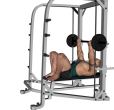 Bench Press - Smith Feet On Bench Reverse
Bench Press - Smith Feet On Bench Reverse
Benefits: A machine allows someone to lift heavier weights and thus build more strength quicker. The reverse grip makes the exercise more difficult.
Purpose: This exercise increases strength and strength speed, and produces greater functional strength for pressing movements.
Beginner Chest Triceps Anterior Delts Strength Smith Machine Flat Bench Push Compound Gym
General Info: The chest is composed of the Pectoralis Major and the Pectoralis Minor. The Pec Major attaches to the upper arm and pulls the upper arm across the chest. The Pec Minor lies mostly underneath the Pec Major and draws the shoulder blade down and forward.
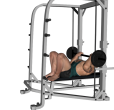 Bench Press - Smith Feet On Bench Reverse Wide
Bench Press - Smith Feet On Bench Reverse Wide
Benefits: A machine allows someone to lift heavier weights and thus build more strength quicker. The reverse grip makes the exercise more difficult.
Purpose: This exercise increases strength and strength speed, and produces greater functional strength for pressing movements.
Beginner Chest Triceps Anterior Delts Strength Smith Machine Flat Bench Push Compound Gym
General Info: The chest is composed of the Pectoralis Major and the Pectoralis Minor. The Pec Major attaches to the upper arm and pulls the upper arm across the chest. The Pec Minor lies mostly underneath the Pec Major and draws the shoulder blade down and forward.
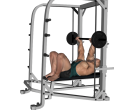 Bench Press - Smith Feet On Bench Wide
Bench Press - Smith Feet On Bench Wide
Benefits: A machine allows someone to lift heavier weights and thus build more strength quicker.
Purpose: This exercise increases strength and strength speed, and produces greater functional strength for pressing movements.
Beginner Chest Triceps Anterior Delts Strength Smith Machine Flat Bench Push Compound Gym
General Info: The chest is composed of the Pectoralis Major and the Pectoralis Minor. The Pec Major attaches to the upper arm and pulls the upper arm across the chest. The Pec Minor lies mostly underneath the Pec Major and draws the shoulder blade down and forward.
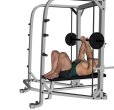 Bench Press - Smith Feet Up Close Grip Reverse
Bench Press - Smith Feet Up Close Grip Reverse
Benefits: This exercise works both heads of the triceps with a heavier weight than can typically be done with dumbbells.
Purpose: This exercise is used to target the triceps muscle to develop size, definition, strength, endurance and power.
Beginner Triceps Chest Shoulders Strength Smith Machine Flat Bench Push Compound Gym
General Info: The triceps is a straight muscle with three heads. The long head straightens the elbow, adducts the shoulder (brings it from a side position to the body) and extends the shoulder (brings the arm from a front position down to the body). The lateral head (outer head) straightens the elbow. The medial head also straightens the elbow.
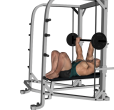 Bench Press - Smith Feet Up Flat Reverse Wide
Bench Press - Smith Feet Up Flat Reverse Wide
Benefits: A machine allows someone to lift heavier weights and thus build more strength quicker.
Purpose: This exercise increases strength and strength speed, and produces greater functional strength for pressing movements.
Beginner Chest Triceps Anterior Delts Strength Smith Machine Flat Bench Push Compound Gym
General Info: The chest is composed of the Pectoralis Major and the Pectoralis Minor. The Pec Major attaches to the upper arm and pulls the upper arm across the chest. The Pec Minor lies mostly underneath the Pec Major and draws the shoulder blade down and forward.
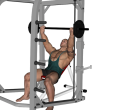 Bench Press - Smith Incline Reverse Wide
Bench Press - Smith Incline Reverse Wide
Benefits: A machine allows someone to lift heavier weights and thus build more strength quicker. The reverse grip makes the exercise more difficult.
Purpose: This exercise increases strength and strength speed, and produces greater functional strength for pressing movements.
Beginner Chest Triceps Anterior Delts Strength Smith Machine Incline Bench Push Compound Gym
General Info: The chest is composed of the Pectoralis Major and the Pectoralis Minor. The Pec Major attaches to the upper arm and pulls the upper arm across the chest. The Pec Minor lies mostly underneath the Pec Major and draws the shoulder blade down and forward.
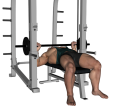 Bench Press - Smith Machine
Bench Press - Smith Machine
Benefits: A machine allows someone to lift heavier weights and thus build more strength quicker.
Purpose: This exercise increases strength and strength speed, and produces greater functional strength for pressing movements.
Beginner Chest Triceps Anterior Delts Strength Smith Machine Flat Bench Push Compound Gym
General Info: The chest is composed of the Pectoralis Major and the Pectoralis Minor. The Pec Major attaches to the upper arm and pulls the upper arm across the chest. The Pec Minor lies mostly underneath the Pec Major and draws the shoulder blade down and forward.
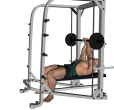 Bench Press - Smith Machine Close Grip
Bench Press - Smith Machine Close Grip
Benefits: This exercise works both heads of the triceps with a heavier weight than can typically be done with dumbbells.
Purpose: This exercise is used to target the triceps muscle to develop size, definition, strength, endurance and power.
Beginner Triceps Chest Shoulders Strength Smith Machine Flat Bench Push Compound Gym
General Info: The triceps is a straight muscle with three heads. The long head straightens the elbow, adducts the shoulder (brings it from a side position to the body) and extends the shoulder (brings the arm from a front position down to the body). The lateral head (outer head) straightens the elbow. The medial head also straightens the elbow.
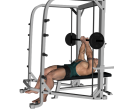 Bench Press - Smith Machine Close Grip Reverse
Bench Press - Smith Machine Close Grip Reverse
Benefits: This exercise works both heads of the triceps with a heavier weight than can typically be done with dumbbells. The reverse grip makes this exercise more difficult.
Purpose: This exercise is used to target the triceps muscle to develop size, definition, strength, endurance and power.
Beginner Triceps Chest Shoulders Strength Smith Machine Push Compound Gym
General Info: The triceps is a straight muscle with three heads. The long head straightens the elbow, adducts the shoulder (brings it from a side position to the body) and extends the shoulder (brings the arm from a front position down to the body). The lateral head (outer head) straightens the elbow. The medial head also straightens the elbow.
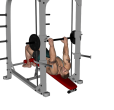 Bench Press - Smith Machine Decline
Bench Press - Smith Machine Decline
Benefits: This exercise works the chest muscles with a focus on your lower pecs.
Purpose: This exercise is used to target the lower pecs muscle to develop size, definition, strength, endurance and power.
Beginner Chest Triceps Shoulders Strength Smith Machine Decline Bench Push Compound Gym
General Info: The chest is composed of the Pectoralis Major and the Pectoralis Minor. The Pec Major attaches to the upper arm and pulls the upper arm across the chest. The Pec Minor lies mostly underneath the Pec Major and draws the shoulder blade down and forward.
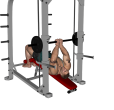 Bench Press - Smith Machine Decline Close
Bench Press - Smith Machine Decline Close
Benefits: The exercise eliminates isolates the triceps.
Purpose: This exercise works primarily the triceps.
Beginner Chest Triceps Shoulders Strength Smith Machine Decline Bench Push Compound Gym
General Info: The triceps is a straight muscle with three heads. The long head straightens the elbow, adducts the shoulder (brings it from a side position to the body) and extends the shoulder (brings the arm from a front position down to the body). The lateral head (outer head) straightens the elbow. The medial head also straightens the elbow.
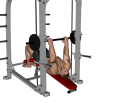 Bench Press - Smith Machine Decline Reverse
Bench Press - Smith Machine Decline Reverse
Benefits: This exercise works the chest muscles with a focus on your lower pecs.
Purpose: This exercise is used to target the lower pecs muscle to develop size, definition, strength, endurance and power.
Beginner Chest Triceps Shoulders Strength Smith Machine Decline Bench Push Compound Gym
General Info: The chest is composed of the Pectoralis Major and the Pectoralis Minor. The Pec Major attaches to the upper arm and pulls the upper arm across the chest. The Pec Minor lies mostly underneath the Pec Major and draws the shoulder blade down and forward.
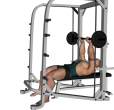 Bench Press - Smith Machine Flat
Bench Press - Smith Machine Flat
Benefits: A machine allows someone to lift heavier weights and thus build more strength quicker.
Purpose: This exercise increases strength and strength speed, and produces greater functional strength for pressing movements.
Beginner Chest Triceps Anterior Delts Strength Smith Machine Flat Bench Push Compound Gym
General Info: The chest is composed of the Pectoralis Major and the Pectoralis Minor. The Pec Major attaches to the upper arm and pulls the upper arm across the chest. The Pec Minor lies mostly underneath the Pec Major and draws the shoulder blade down and forward.
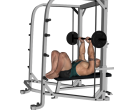 Bench Press - Smith Machine Flat Feet Up
Bench Press - Smith Machine Flat Feet Up
Benefits: Placing your feet on the end of the bench reduces the tendency to arch the back.
Purpose: Benefits A machine allows someone to lift heavier weights and thus build more strength quicker.
Beginner Chest Triceps Anterior Delts Strength Smith Machine Flat Bench Push Compound Gym
General Info: The chest is composed of the Pectoralis Major and the Pectoralis Minor. The Pec Major attaches to the upper arm and pulls the upper arm across the chest. The Pec Minor lies mostly underneath the Pec Major and draws the shoulder blade down and forward.
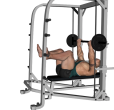 Bench Press - Smith Machine Flat Feet Up Reverse
Bench Press - Smith Machine Flat Feet Up Reverse
Benefits: A machine allows someone to lift heavier weights and thus build more strength quicker. The reverse grip makes this exercise more difficult.
Purpose: This exercise increases strength and strength speed, and produces greater functional strength for pressing movements.
Beginner Chest Triceps Anterior Delts Strength Smith Machine Flat Bench Push Compound Gym
General Info: The chest is composed of the Pectoralis Major and the Pectoralis Minor. The Pec Major attaches to the upper arm and pulls the upper arm across the chest. The Pec Minor lies mostly underneath the Pec Major and draws the shoulder blade down and forward.
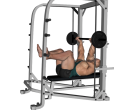 Bench Press - Smith Machine Flat Feet Up Wide
Bench Press - Smith Machine Flat Feet Up Wide
Benefits: A machine allows someone to lift heavier weights and thus build more strength quicker.
Purpose: This exercise increases strength and strength speed, and produces greater functional strength for pressing movements.
Beginner Chest Triceps Anterior Delts Strength Smith Machine Flat Bench Push Compound Gym
General Info: The chest is composed of the Pectoralis Major and the Pectoralis Minor. The Pec Major attaches to the upper arm and pulls the upper arm across the chest. The Pec Minor lies mostly underneath the Pec Major and draws the shoulder blade down and forward.
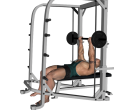 Bench Press - Smith Machine Flat Reverse
Bench Press - Smith Machine Flat Reverse
Benefits: A machine allows someone to lift heavier weights and thus build more strength quicker. The reverse grip makes this exercise more difficult.
Purpose: This exercise increases strength and strength speed, and produces greater functional strength for pressing movements.
Beginner Chest Triceps Anterior Delts Strength Smith Machine Flat Bench Push Compound Gym
General Info: The chest is composed of the Pectoralis Major and the Pectoralis Minor. The Pec Major attaches to the upper arm and pulls the upper arm across the chest. The Pec Minor lies mostly underneath the Pec Major and draws the shoulder blade down and forward.
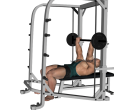 Bench Press - Smith Machine Flat Reverse Wide
Bench Press - Smith Machine Flat Reverse Wide
Benefits: A machine allows someone to lift heavier weights and thus build more strength quicker. The reverse grip makes this exercise more difficult.
Purpose: This exercise increases strength and strength speed, and produces greater functional strength for pressing movements.
Beginner Chest Triceps Anterior Delts Strength Smith Machine Flat Bench Push Compound Gym
General Info: The chest is composed of the Pectoralis Major and the Pectoralis Minor. The Pec Major attaches to the upper arm and pulls the upper arm across the chest. The Pec Minor lies mostly underneath the Pec Major and draws the shoulder blade down and forward.
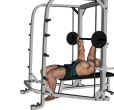 Bench Press - Smith Machine Flat Wide Grip
Bench Press - Smith Machine Flat Wide Grip
Benefits: A machine allows someone to lift heavier weights and thus build more strength quicker.
Purpose: This exercise increases strength and strength speed, and produces greater functional strength for pressing movements.
Beginner Chest Triceps Anterior Delts Strength Smith Machine Flat Bench Push Compound Gym
General Info: The chest is composed of the Pectoralis Major and the Pectoralis Minor. The Pec Major attaches to the upper arm and pulls the upper arm across the chest. The Pec Minor lies mostly underneath the Pec Major and draws the shoulder blade down and forward.
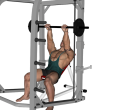 Bench Press - Smith Machine Incline
Bench Press - Smith Machine Incline
Benefits: This exercise works the chest muscles with a focus on your upper pecs.
Purpose: This exercise is used to target the upper pecs muscle to develop size, definition, strength, endurance and power.
Beginner Chest Triceps Shoulders Strength Smith Machine Incline Bench Push Compound Gym
General Info: The chest is composed of the Pectoralis Major and the Pectoralis Minor. The Pec Major attaches to the upper arm and pulls the upper arm across the chest. The Pec Minor lies mostly underneath the Pec Major and draws the shoulder blade down and forward.
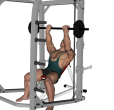 Bench Press - Smith Machine Incline Reverse
Bench Press - Smith Machine Incline Reverse
Benefits: A machine allows someone to lift heavier weights and thus build more strength quicker.
Purpose: This exercise increases strength and strength speed, and produces greater functional strength for pressing movements.
Beginner Chest Triceps Anterior Delts Strength Smith Machine Incline Bench Push Compound Gym
General Info: The chest is composed of the Pectoralis Major and the Pectoralis Minor. The Pec Major attaches to the upper arm and pulls the upper arm across the chest. The Pec Minor lies mostly underneath the Pec Major and draws the shoulder blade down and forward.
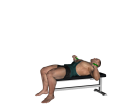 Bench Press - With Bands
Bench Press - With Bands
Benefits: Bands can be used to increase strength speed.
Purpose: This exercise increases strength and strength speed.
Beginner Chest Triceps Strength Band Flat Bench Push Compound Gym
General Info: The chest is composed of the Pectoralis Major and the Pectoralis Minor. The Pec Major attaches to the upper arm and pulls the upper arm across the chest. The Pec Minor lies mostly underneath the Pec Major and draws the shoulder blade down and forward.
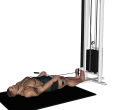 Cable Curl - Lying
Cable Curl - Lying
Benefits: This exercise also works the triceps, due to the constant tension on the cable in both position and negative reps.
Purpose: This exercise strengthens the biceps.
Intermediate Biceps Triceps Forearms Strength High Low Cable Machine Pull Gym
General Info: The biceps muscle is a straight muscle with 2 heads. The long head crosses both the elbow and shoulder joints and bends the elbow and raises the arm forward at the shoulder. The short head of the biceps crosses the elbow joint and, in conjunction with the brachioradialis, supinates the hand..
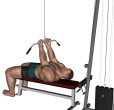 Cable Curl - Lying Close Grip On High Pulley
Cable Curl - Lying Close Grip On High Pulley
Benefits: This exercise also works the triceps, due to the constant tension on the cable in both position and negative reps.
Purpose: This exercise strengthens the biceps.
Beginner Biceps Triceps Forearms Strength High Low Cable Machine Flat Bench Pull Gym
General Info: The biceps muscle is a straight muscle with 2 heads. The long head crosses both the elbow and shoulder joints and bends the elbow and raises the arm forward at the shoulder. The short head of the biceps crosses the elbow joint and, in conjunction with the brachioradialis, supinates the hand..
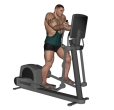 Cardio - Elliptical Trainer
Cardio - Elliptical Trainer
Benefits: Using this machine reduces excessive pressure to the joints, hence decreasing the risk of impact injuries.
Purpose: This exercise improves cardio fitness.
Beginner Quads Hamstrings Glutes Chest Back Triceps Biceps Cardio Elliptical Trainer Gym
General Info: Research has shown that people who spend long periods of time jogging, on treadmills, or stationary bikes, at a relative constant rate of speed, actually lose heart size and fitness. In addition, the body stores more fat to ensure that it can meet the demands of this marathon. But those who do short bursts (1-5 minutes) of intensive exercising and then cool down for another 2-5 minutes have better heart fitness and the muscles of their heart are stronger. Short bursts of intensive exercising have another benefit. The body actually burns more fat and continues to do it for 2-4 hours after the exercise has been completed. This means that your metabolic rate is higher and you will lose fat and be slimmer.
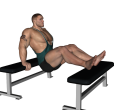 Dip - Bench
Dip - Bench
Benefits: .
Purpose: Benefits Strengthening the triceps balances the biceps muscle.
Beginner Triceps Shoulders Strength Flat Bench Push Compound Gym
General Info: The triceps is a straight muscle with three heads, long head (which extends and adducts the shoulder joint), lateral head (outer triceps) and medial head (inner head along with the long head).
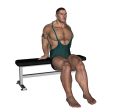 Dip - Bench Bent Knee
Dip - Bench Bent Knee
Benefits: .
Purpose: Benefits Strengthening the triceps balances the biceps muscle.
Beginner Triceps Shoulders Strength Flat Bench Push Compound Gym
General Info: The triceps is a straight muscle with three heads, long head (which extends and adducts the shoulder joint), lateral head (outer triceps) and medial head (inner head along with the long head).
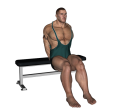 Dip - Bench Bent Knee Close Grip
Dip - Bench Bent Knee Close Grip
Benefits: .
Purpose: Benefits Strengthening the triceps balances the biceps muscle.
Beginner Triceps Shoulders Strength Flat Bench Push Compound Gym
General Info: The triceps is a straight muscle with three heads, long head (which extends and adducts the shoulder joint), lateral head (outer triceps) and medial head (inner head along with the long head).
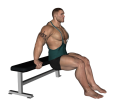 Dip - Bench Bent Knee Wide Grip
Dip - Bench Bent Knee Wide Grip
Benefits: .
Purpose: Benefits Strengthening the triceps balances the biceps muscle.
Beginner Triceps Shoulders Strength Flat Bench Push Compound Gym
General Info: The triceps is a straight muscle with three heads, long head (which extends and adducts the shoulder joint), lateral head (outer triceps) and medial head (inner head along with the long head).
 Dip - Chair
Dip - Chair
Benefits: .
Purpose: Benefits Strengthening the triceps balances the biceps muscle.
Beginner Triceps Shoulders Strength Chair Push Compound Home
General Info: The triceps is a straight muscle with three heads, long head (which extends and adducts the shoulder joint), lateral head (outer triceps) and medial head (inner head along with the long head).
 Dip - Chair Bent Knee
Dip - Chair Bent Knee
Benefits: .
Purpose: Benefits Strengthening the triceps balances the biceps muscle.
Beginner Triceps Shoulders Strength Chair Push Compound Home
General Info: The triceps is a straight muscle with three heads, long head (which extends and adducts the shoulder joint), lateral head (outer triceps) and medial head (inner head along with the long head).
 Dip - Chair Bent Knee Close Grip
Dip - Chair Bent Knee Close Grip
Benefits: .
Purpose: Benefits Strengthening the triceps balances the biceps muscle.
Beginner Triceps Shoulders Strength Chair Push Compound Home
General Info: The triceps is a straight muscle with three heads, long head (which extends and adducts the shoulder joint), lateral head (outer triceps) and medial head (inner head along with the long head).
 Dip - Chair Bent Knee Wide Grip
Dip - Chair Bent Knee Wide Grip
Benefits: .
Purpose: Benefits Strengthening the triceps balances the biceps muscle.
Beginner Triceps Shoulders Strength Chair Push Compound Home
General Info: The triceps is a straight muscle with three heads, long head (which extends and adducts the shoulder joint), lateral head (outer triceps) and medial head (inner head along with the long head).
 Dip - Chair Leg Raised Floor
Dip - Chair Leg Raised Floor
Benefits: .
Purpose: Benefits Strengthening the triceps balances the biceps muscle.
Beginner Triceps Shoulders Strength Chair Push Compound Home
General Info: The triceps is a straight muscle with three heads, long head (which extends and adducts the shoulder joint), lateral head (outer triceps) and medial head (inner head along with the long head).
 Dip - Chair Leg Raised Floor Close Grip
Dip - Chair Leg Raised Floor Close Grip
Benefits: .
Purpose: Benefits Strengthening the triceps balances the biceps muscle.
Beginner Triceps Shoulders Strength Chair Push Compound Home
General Info: The triceps is a straight muscle with three heads, long head (which extends and adducts the shoulder joint), lateral head (outer triceps) and medial head (inner head along with the long head).
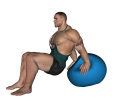 Dip - Fitness Ball Bent Knee
Dip - Fitness Ball Bent Knee
Benefits: .
Purpose: Benefits Strengthening the triceps balances the biceps muscle.
Beginner Triceps Shoulders Strength Fitness Ball Push Compound Gym
General Info: The triceps is a straight muscle with three heads, long head (which extends and adducts the shoulder joint), lateral head (outer triceps) and medial head (inner head along with the long head).
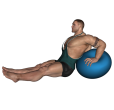 Dip - Fitness Ball Straight Leg
Dip - Fitness Ball Straight Leg
Benefits: Strengthening the triceps balances the biceps muscle.
Purpose: This exercise strengthens the triceps muscle.
Beginner Triceps Shoulders Strength Fitness Ball Push Compound Gym
General Info: The triceps is a straight muscle with three heads, long head (which extends and adducts the shoulder joint), lateral head (outer triceps) and medial head (inner head along with the long head).
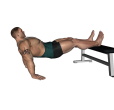 Dip - Leg Raised Floor
Dip - Leg Raised Floor
Benefits: Strengthening the triceps balances the biceps muscle.
Purpose: This exercise strengthens the triceps muscle.
Beginner Triceps Shoulders Strength Flat Bench Push Compound Gym
General Info: The triceps is a straight muscle with three heads, long head (which extends and adducts the shoulder joint), lateral head (outer triceps) and medial head (inner head along with the long head).
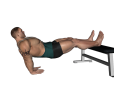 Dip - Leg Raised Floor Close Grip
Dip - Leg Raised Floor Close Grip
Benefits: Strengthening the triceps balances the biceps muscle.
Purpose: This exercise strengthens the triceps muscle.
Beginner Triceps Shoulders Strength Flat Bench Push Compound Gym
General Info: The triceps is a straight muscle with three heads, long head (which extends and adducts the shoulder joint), lateral head (outer triceps) and medial head (inner head along with the long head).
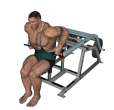 Dip - Machine
Dip - Machine
Benefits: Strengthening the triceps balances the biceps muscle.
Purpose: This exercise strengthens the triceps muscle.
Beginner Triceps Shoulders Strength Dip Machine Push Compound Gym
General Info: The triceps is a straight muscle with three heads, long head (which extends and adducts the shoulder joint), lateral head (outer triceps) and medial head (inner head along with the long head).
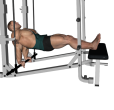 Dip - Smith Machine
Dip - Smith Machine
Benefits: Strengthening the triceps balances the biceps muscle.
Purpose: This exercise strengthens the triceps muscle.
Beginner Triceps Shoulders Strength Smith Machine Flat Bench Push Compound Gym
General Info: The triceps is a straight muscle with three heads, long head (which extends and adducts the shoulder joint), lateral head (outer triceps) and medial head (inner head along with the long head).
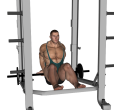 Dip - Smith Machine Bent Knee
Dip - Smith Machine Bent Knee
Benefits: .
Purpose: Benefits Strengthening the triceps balances the biceps muscle.
Beginner Triceps Shoulders Strength Smith Machine Push Compound Gym
General Info: The triceps is a straight muscle with three heads, long head (which extends and adducts the shoulder joint), lateral head (outer triceps) and medial head (inner head along with the long head).
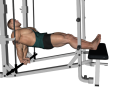 Dip - Smith Machine Close Grip
Dip - Smith Machine Close Grip
Benefits: Strengthening the triceps balances the biceps muscle.
Purpose: This exercise strengthens the triceps muscle.
Beginner Triceps Shoulders Strength Smith Machine Flat Bench Push Compound Gym
General Info: The triceps is a straight muscle with three heads, long head (which extends and adducts the shoulder joint), lateral head (outer triceps) and medial head (inner head along with the long head).
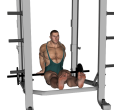 Dip - Smith Machine Straight Leg
Dip - Smith Machine Straight Leg
Benefits: .
Purpose: Benefits Strengthening the triceps balances the biceps muscle.
Beginner Triceps Shoulders Strength Smith Machine Push Compound Gym
General Info: The triceps is a straight muscle with three heads, long head (which extends and adducts the shoulder joint), lateral head (outer triceps) and medial head (inner head along with the long head).
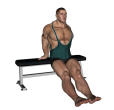 Dip - Straight Leg Bench
Dip - Straight Leg Bench
Benefits: Strengthening the triceps balances the biceps muscle.
Purpose: This exercise strengthens the triceps muscle.
Beginner Triceps Shoulders Strength Flat Bench Push Compound Gym
General Info: The triceps is a straight muscle with three heads, long head (which extends and adducts the shoulder joint), lateral head (outer triceps) and medial head (inner head along with the long head).
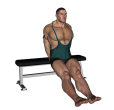 Dip - Straight Leg Bench Close Grip
Dip - Straight Leg Bench Close Grip
Benefits: .
Purpose: Benefits Strengthening the triceps balances the biceps muscle.
Beginner Triceps Shoulders Strength Flat Bench Push Compound Gym
General Info: The triceps is a straight muscle with three heads, long head (which extends and adducts the shoulder joint), lateral head (outer triceps) and medial head (inner head along with the long head).
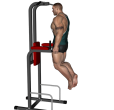 Dip - Triceps
Dip - Triceps
Benefits: Strengthening the triceps balances the biceps muscle.
Purpose: This exercise strengthens the triceps muscle.
Beginner Triceps Shoulders Strength Dipping Bars Push Compound Gym
General Info: The triceps is a straight muscle with three heads, long head (which extends and adducts the shoulder joint), lateral head (outer triceps) and medial head (inner head along with the long head).
 Dip - Triceps With Chains
Dip - Triceps With Chains
Benefits: This exercise is done with the addition of chains. The primary function of chains is to accommodate resistance. Chains are also a great means of weight loading (adding more weight to an exercise). Chains are also a great way for working the stabilizers.
Purpose: .
Beginner Triceps Shoulders Strength Dipping Bars Chains Push Compound Gym
General Info: The triceps is a straight muscle with three heads, long head (which extends and adducts the shoulder joint), lateral head (outer triceps) and medial head (inner head along with the long head).
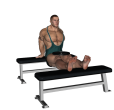 Dip - Weighted Bench
Dip - Weighted Bench
Benefits: .
Purpose: Benefits Strengthening the triceps balances the biceps muscle.
Beginner Triceps Shoulders Strength Flat Bench Plate Push Compound Gym
General Info: The triceps is a straight muscle with three heads, long head (which extends and adducts the shoulder joint), lateral head (outer triceps) and medial head (inner head along with the long head).
 Dip - Weighted Chair
Dip - Weighted Chair
Benefits: .
Purpose: Benefits Strengthening the triceps balances the biceps muscle.
Beginner Triceps Shoulders Strength Chair Book Push Compound Home
General Info: The triceps is a straight muscle with three heads, long head (which extends and adducts the shoulder joint), lateral head (outer triceps) and medial head (inner head along with the long head).
 Drag - Forward With Press
Drag - Forward With Press
Benefits: It is the single best exercise to develop full body strength and increase your fat-burning metabolism.
Purpose: To develop core strength of the lower and middle body.
Intermediate Quads Triceps Chest Strength Sled Push Compound Gym
General Info: The quads are a set of four muscles in the upper front thigh. All four muscles work to straighten the knee. One of the four (rectus femoris) also helps to bend the hip. Squats are considered a vital exercise for increasing the strength and size of the legs and butt.
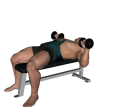 Dumbbell Press - Basic
Dumbbell Press - Basic
Benefits: Dumbbells do not limit your movement as much as a barbell does and thus makes greater demands on the stabilizing muscles.
Purpose: This exercise increases strength and strength speed, and produces greater functional strength for pressing movements.
Beginner Chest Triceps Strength Dumbbell Flat Bench Push Compound Gym
General Info: The chest is composed of the Pectoralis Major and the Pectoralis Minor. The Pec Major attaches to the upper arm and pulls the upper arm across the chest. The Pec Minor lies mostly underneath the Pec Major and draws the shoulder blade down and forward.
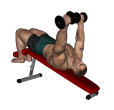 Dumbbell Press - Decline
Dumbbell Press - Decline
Benefits: This exercise works the chest muscles with a focus on your lower pecs.
Purpose: This exercise is used to target the lower pecs muscle to develop size, definition, strength, endurance and power.
Beginner Chest Triceps Shoulders Strength Dumbbell Decline Bench Push Compound Gym
General Info: The chest is composed of the Pectoralis Major and the Pectoralis Minor. The Pec Major attaches to the upper arm and pulls the upper arm across the chest. The Pec Minor lies mostly underneath the Pec Major and draws the shoulder blade down and forward.
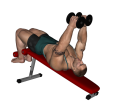 Dumbbell Press - Decline Inwards
Dumbbell Press - Decline Inwards
Benefits: Dumbbells do not limit your movement as much as a barbell does and thus makes greater demands on the stabilizing muscles.
Purpose: This exercise increases strength and strength speed, and produces greater functional strength for pressing movements.
Beginner Chest Triceps Strength Dumbbell Decline Bench Push Compound Gym
General Info: The chest is composed of the Pectoralis Major and the Pectoralis Minor. The Pec Major attaches to the upper arm and pulls the upper arm across the chest. The Pec Minor lies mostly underneath the Pec Major and draws the shoulder blade down and forward.
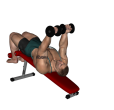 Dumbbell Press - Decline Reverse
Dumbbell Press - Decline Reverse
Benefits: This exercise works the chest muscles with a focus on your lower pecs. The reverse grip makes the exercise more difficult.
Purpose: This exercise is used to target the lower pecs muscle to develop size, definition, strength, endurance and power.
Beginner Chest Triceps Shoulders Strength Dumbbell Decline Bench Push Compound Gym
General Info: The chest is composed of the Pectoralis Major and the Pectoralis Minor. The Pec Major attaches to the upper arm and pulls the upper arm across the chest. The Pec Minor lies mostly underneath the Pec Major and draws the shoulder blade down and forward.
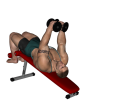 Dumbbell Press - Decline Reverse Rotation
Dumbbell Press - Decline Reverse Rotation
Benefits: This exercise works the chest muscles with a focus on your lower pecs. The reverse grip makes the exercise more difficult.
Purpose: This exercise is used to target the lower pecs muscle to develop size, definition, strength, endurance and power.
Beginner Chest Triceps Shoulders Strength Dumbbell Decline Bench Push Compound Gym
General Info: The chest is composed of the Pectoralis Major and the Pectoralis Minor. The Pec Major attaches to the upper arm and pulls the upper arm across the chest. The Pec Minor lies mostly underneath the Pec Major and draws the shoulder blade down and forward.
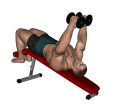 Dumbbell Press - Decline Rotation
Dumbbell Press - Decline Rotation
Benefits: Dumbbells do not limit your movement as much as a barbell does and thus makes greater demands on the stabilizing muscles.
Purpose: This exercise increases strength and strength speed, and produces greater functional strength for pressing movements.
Beginner Chest Triceps Strength Dumbbell Decline Bench Push Compound Gym
General Info: The chest is composed of the Pectoralis Major and the Pectoralis Minor. The Pec Major attaches to the upper arm and pulls the upper arm across the chest. The Pec Minor lies mostly underneath the Pec Major and draws the shoulder blade down and forward.
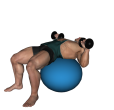 Dumbbell Press - Fitness Ball
Dumbbell Press - Fitness Ball
Benefits: Dumbbells do not limit your movement as much as a barbell does and thus makes greater demands on the stabilizing muscles.
Purpose: This exercise increases strength and strength speed, and produces greater functional strength for pressing movements.
Beginner Chest Triceps Strength Dumbbell Fitness Ball Push Compound Gym
General Info: The chest is composed of the Pectoralis Major and the Pectoralis Minor. The Pec Major attaches to the upper arm and pulls the upper arm across the chest. The Pec Minor lies mostly underneath the Pec Major and draws the shoulder blade down and forward.
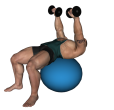 Dumbbell Press - Fitness Ball and Flye
Dumbbell Press - Fitness Ball and Flye
Benefits: A barbell allows someone to lift heavier weights and thus build more strength quicker. The flye part of the exercise works the anterior deltoids.
Purpose: This exercise increases strength and strength speed, and produces greater functional strength for pressing movements.
Intermediate Chest Triceps Anterior Delts Strength Dumbbell Fitness Ball Push Compound Gym
General Info: The chest is composed of the Pectoralis Major and the Pectoralis Minor. The Pec Major attaches to the upper arm and pulls the upper arm across the chest. The Pec Minor lies mostly underneath the Pec Major and draws the shoulder blade down and forward.
 Dumbbell Press - Fitness Ball and Flye Reverse
Dumbbell Press - Fitness Ball and Flye Reverse
Benefits: A barbell allows someone to lift heavier weights and thus build more strength quicker.
Purpose: This exercise increases strength and strength speed, and produces greater functional strength for pressing movements.
Intermediate Chest Triceps Anterior Delts Strength Dumbbell Fitness Ball Push Compound Gym
General Info: The chest is composed of the Pectoralis Major and the Pectoralis Minor. The Pec Major attaches to the upper arm and pulls the upper arm across the chest. The Pec Minor lies mostly underneath the Pec Major and draws the shoulder blade down and forward.
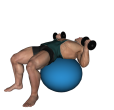 Dumbbell Press - Fitness Ball Reverse
Dumbbell Press - Fitness Ball Reverse
Benefits: Dumbbells do not limit your movement as much as a barbell does and thus makes greater demands on the stabilizing muscles. The reverse grip makes the exercise more difficult.
Purpose: This exercise increases strength and strength speed, and produces greater functional strength for pressing movements.
Beginner Chest Triceps Strength Dumbbell Fitness Ball Push Compound Gym
General Info: The chest is composed of the Pectoralis Major and the Pectoralis Minor. The Pec Major attaches to the upper arm and pulls the upper arm across the chest. The Pec Minor lies mostly underneath the Pec Major and draws the shoulder blade down and forward.
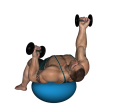 Dumbbell Press - Fitness Ball Reverse Alternate
Dumbbell Press - Fitness Ball Reverse Alternate
Benefits: Dumbbells do not limit your movement as much as a barbell does and thus makes greater demands on the stabilizing muscles.
Purpose: This exercise increases strength and strength speed, and produces greater functional strength for pressing movements.
Beginner Chest Triceps Strength Dumbbell Fitness Ball Push Compound Gym
General Info: The chest is composed of the Pectoralis Major and the Pectoralis Minor. The Pec Major attaches to the upper arm and pulls the upper arm across the chest. The Pec Minor lies mostly underneath the Pec Major and draws the shoulder blade down and forward.
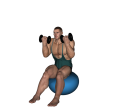 Dumbbell Press - Fitness Ball Rotation
Dumbbell Press - Fitness Ball Rotation
Benefits: Dumbbells do not limit your movement as much as a barbell does and thus makes greater demands on the stabilizing muscles.
Purpose: This exercise increases strength and strength speed, and produces greater functional strength for pressing movements.
Beginner Chest Triceps Strength Dumbbell Fitness Ball Push Compound Gym
General Info: The chest is composed of the Pectoralis Major and the Pectoralis Minor. The Pec Major attaches to the upper arm and pulls the upper arm across the chest. The Pec Minor lies mostly underneath the Pec Major and draws the shoulder blade down and forward.
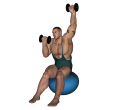 Dumbbell Press - Fitness Ball Rotation Alternate
Dumbbell Press - Fitness Ball Rotation Alternate
Benefits: Dumbbells do not limit your movement as much as a barbell does and thus makes greater demands on the stabilizing muscles.
Purpose: This exercise increases strength and strength speed, and produces greater functional strength for pressing movements.
Beginner Chest Triceps Strength Dumbbell Fitness Ball Push Compound Gym
General Info: The chest is composed of the Pectoralis Major and the Pectoralis Minor. The Pec Major attaches to the upper arm and pulls the upper arm across the chest. The Pec Minor lies mostly underneath the Pec Major and draws the shoulder blade down and forward.
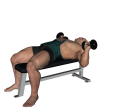 Dumbbell Press - Flat Bench
Dumbbell Press - Flat Bench
Benefits: Dumbbells do not limit your movement as much as a barbell does and thus makes greater demands on the stabilizing muscles.
Purpose: This exercise increases strength and strength speed, and produces greater functional strength for pressing movements.
Beginner Chest Triceps Strength Dumbbell Flat Bench Push Compound Gym
General Info: The chest is composed of the Pectoralis Major and the Pectoralis Minor. The Pec Major attaches to the upper arm and pulls the upper arm across the chest. The Pec Minor lies mostly underneath the Pec Major and draws the shoulder blade down and forward.
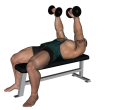 Dumbbell Press - Flat Bench and Flye
Dumbbell Press - Flat Bench and Flye
Benefits: Dumbbells do not limit your movement as much as a barbell does and thus makes greater demands on the stabilizing muscles. The flye part of the exercise works the anterior deltoids.
Purpose: This exercise increases strength and strength speed, and produces greater functional strength for pressing movements.
Intermediate Chest Triceps Anterior Delts Strength Dumbbell Flat Bench Push Compound Gym
General Info: The chest is composed of the Pectoralis Major and the Pectoralis Minor. The Pec Major attaches to the upper arm and pulls the upper arm across the chest. The Pec Minor lies mostly underneath the Pec Major and draws the shoulder blade down and forward.
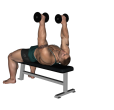 Dumbbell Press - Flat Bench and Flye Reverse
Dumbbell Press - Flat Bench and Flye Reverse
Benefits: A barbell allows someone to lift heavier weights and thus build more strength quicker.
Purpose: This exercise increases strength and strength speed, and produces greater functional strength for pressing movements.
Intermediate Chest Triceps Anterior Delts Strength Dumbbell Flat Bench Push Compound Gym
General Info: The chest is composed of the Pectoralis Major and the Pectoralis Minor. The Pec Major attaches to the upper arm and pulls the upper arm across the chest. The Pec Minor lies mostly underneath the Pec Major and draws the shoulder blade down and forward.
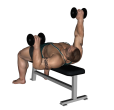 Dumbbell Press - Flat Bench Feet Up
Dumbbell Press - Flat Bench Feet Up
Benefits: Dumbbells do not limit your movement as much as a barbell does and thus makes greater demands on the stabilizing muscles.
Purpose: This exercise increases strength and strength speed, and produces greater functional strength for pressing movements.
Beginner Chest Triceps Strength Dumbbell Flat Bench Push Compound Gym
General Info: The chest is composed of the Pectoralis Major and the Pectoralis Minor. The Pec Major attaches to the upper arm and pulls the upper arm across the chest. The Pec Minor lies mostly underneath the Pec Major and draws the shoulder blade down and forward.
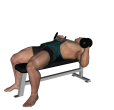 Dumbbell Press - Flat Bench Inwards
Dumbbell Press - Flat Bench Inwards
Benefits: Dumbbells do not limit your movement as much as a barbell does and thus makes greater demands on the stabilizing muscles.
Purpose: This exercise increases strength and strength speed, and produces greater functional strength for pressing movements.
Beginner Chest Triceps Strength Dumbbell Flat Bench Push Compound Gym
General Info: The chest is composed of the Pectoralis Major and the Pectoralis Minor. The Pec Major attaches to the upper arm and pulls the upper arm across the chest. The Pec Minor lies mostly underneath the Pec Major and draws the shoulder blade down and forward.
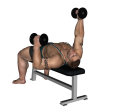 Dumbbell Press - Flat Bench Inwards Alternate
Dumbbell Press - Flat Bench Inwards Alternate
Benefits: Dumbbells do not limit your movement as much as a barbell does and thus makes greater demands on the stabilizing muscles.
Purpose: This exercise increases strength and strength speed, and produces greater functional strength for pressing movements.
Beginner Chest Triceps Strength Dumbbell Flat Bench Push Compound Gym
General Info: The chest is composed of the Pectoralis Major and the Pectoralis Minor. The Pec Major attaches to the upper arm and pulls the upper arm across the chest. The Pec Minor lies mostly underneath the Pec Major and draws the shoulder blade down and forward.
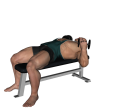 Dumbbell Press - Flat Bench Reverse
Dumbbell Press - Flat Bench Reverse
Benefits: Dumbbells do not limit your movement as much as a barbell does and thus makes greater demands on the stabilizing muscles. The reverse grip makes the exercise more difficult.
Purpose: This exercise increases strength and strength speed, and produces greater functional strength for pressing movements.
Beginner Chest Triceps Strength Dumbbell Flat Bench Push Compound Gym
General Info: The chest is composed of the Pectoralis Major and the Pectoralis Minor. The Pec Major attaches to the upper arm and pulls the upper arm across the chest. The Pec Minor lies mostly underneath the Pec Major and draws the shoulder blade down and forward.
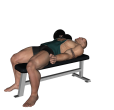 Dumbbell Press - Flat Bench Single
Dumbbell Press - Flat Bench Single
Benefits: Dumbbells do not limit your movement as much as a barbell does and thus makes greater demands on the stabilizing muscles.
Purpose: This exercise increases strength and strength speed, and produces greater functional strength for pressing movements.
Beginner Chest Triceps Strength Dumbbell Flat Bench Push Compound Gym
General Info: The chest is composed of the Pectoralis Major and the Pectoralis Minor. The Pec Major attaches to the upper arm and pulls the upper arm across the chest. The Pec Minor lies mostly underneath the Pec Major and draws the shoulder blade down and forward.
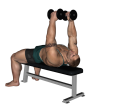 Dumbbell Press - Flat Reverse and Flye
Dumbbell Press - Flat Reverse and Flye
Benefits: A barbell allows someone to lift heavier weights and thus build more strength quicker.
Purpose: This exercise increases strength and strength speed, and produces greater functional strength for pressing movements.
Intermediate Chest Triceps Anterior Delts Strength Dumbbell Flat Bench Push Compound Gym
General Info: The chest is composed of the Pectoralis Major and the Pectoralis Minor. The Pec Major attaches to the upper arm and pulls the upper arm across the chest. The Pec Minor lies mostly underneath the Pec Major and draws the shoulder blade down and forward.
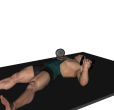 Dumbbell Press - Floor
Dumbbell Press - Floor
Benefits: Dumbbells do not limit your movement as much as a barbell does and thus makes greater demands on the stabilizing muscles.
Purpose: This exercise increases strength and strength speed, and produces greater functional strength for pressing movements.
Beginner Chest Triceps Strength Dumbbell Push Compound Gym
General Info: The chest is composed of the Pectoralis Major and the Pectoralis Minor. The Pec Major attaches to the upper arm and pulls the upper arm across the chest. The Pec Minor lies mostly underneath the Pec Major and draws the shoulder blade down and forward.
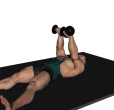 Dumbbell Press - Floor and Flye
Dumbbell Press - Floor and Flye
Benefits: Dumbbells do not limit your movement as much as a barbell does and thus makes greater demands on the stabilizing muscles. The flye part of the exercise works the anterior deltoids.
Purpose: This exercise increases strength and strength speed, and produces greater functional strength for pressing movements.
Intermediate Chest Triceps Anterior Delts Strength Dumbbell Push Compound Gym
General Info: The chest is composed of the Pectoralis Major and the Pectoralis Minor. The Pec Major attaches to the upper arm and pulls the upper arm across the chest. The Pec Minor lies mostly underneath the Pec Major and draws the shoulder blade down and forward.
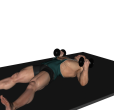 Dumbbell Press - Floor Inwards
Dumbbell Press - Floor Inwards
Benefits: Dumbbells do not limit your movement as much as a barbell does and thus makes greater demands on the stabilizing muscles.
Purpose: This exercise increases strength and strength speed, and produces greater functional strength for pressing movements.
Beginner Chest Triceps Strength Dumbbell Push Compound Gym
General Info: The chest is composed of the Pectoralis Major and the Pectoralis Minor. The Pec Major attaches to the upper arm and pulls the upper arm across the chest. The Pec Minor lies mostly underneath the Pec Major and draws the shoulder blade down and forward.
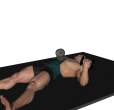 Dumbbell Press - Floor Reverse
Dumbbell Press - Floor Reverse
Benefits: Dumbbells do not limit your movement as much as a barbell does and thus makes greater demands on the stabilizing muscles. The reverse grip makes the exercise more difficult.
Purpose: This exercise increases strength and strength speed, and produces greater functional strength for pressing movements.
Beginner Chest Triceps Strength Dumbbell Push Compound Gym
General Info: The chest is composed of the Pectoralis Major and the Pectoralis Minor. The Pec Major attaches to the upper arm and pulls the upper arm across the chest. The Pec Minor lies mostly underneath the Pec Major and draws the shoulder blade down and forward.
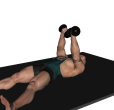 Dumbbell Press - Floor Reverse and Flye
Dumbbell Press - Floor Reverse and Flye
Benefits: Dumbbells do not limit your movement as much as a barbell does and thus makes greater demands on the stabilizing muscles. The reverse grip makes the exercise more difficult. The flye part of the exercise works the anterior deltoids.
Purpose: This exercise increases strength and strength speed, and produces greater functional strength for pressing movements.
Intermediate Chest Triceps Anterior Delts Strength Dumbbell Push Compound Gym
General Info: The chest is composed of the Pectoralis Major and the Pectoralis Minor. The Pec Major attaches to the upper arm and pulls the upper arm across the chest. The Pec Minor lies mostly underneath the Pec Major and draws the shoulder blade down and forward.
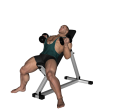 Dumbbell Press - Hammer Incline
Dumbbell Press - Hammer Incline
Benefits: A Hammer Grip isolates the chest muscles.
Purpose: This exercise increases strength and size.
Beginner Chest Triceps Strength Dumbbell Incline Bench Push Compound Gym
General Info: The chest is composed of the Pectoralis Major and the Pectoralis Minor. The Pec Major attaches to the upper arm and pulls the upper arm across the chest. The Pec Minor lies mostly underneath the Pec Major and draws the shoulder blade down and forward.
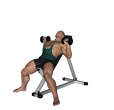 Dumbbell Press - Incline
Dumbbell Press - Incline
Benefits: This exercise works the chest muscles with a focus on your upper pecs.
Purpose: This exercise is used to target the upper pecs muscle to develop size, definition, strength, endurance and power.
Beginner Chest Triceps Shoulders Strength Dumbbell Incline Bench Push Compound Gym
General Info: The chest is composed of the Pectoralis Major and the Pectoralis Minor. The Pec Major attaches to the upper arm and pulls the upper arm across the chest. The Pec Minor lies mostly underneath the Pec Major and draws the shoulder blade down and forward.
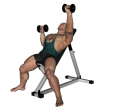 Dumbbell Press - Incline Alternate
Dumbbell Press - Incline Alternate
Benefits: This exercise works the chest muscles with a focus on your upper pecs.
Purpose: This exercise is used to target the upper pecs muscle to develop size, definition, strength, endurance and power.
Beginner Chest Triceps Shoulders Strength Dumbbell Incline Bench Push Compound Gym
General Info: The chest is composed of the Pectoralis Major and the Pectoralis Minor. The Pec Major attaches to the upper arm and pulls the upper arm across the chest. The Pec Minor lies mostly underneath the Pec Major and draws the shoulder blade down and forward.
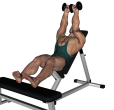 Dumbbell Press - Incline Feet Up
Dumbbell Press - Incline Feet Up
Benefits: This exercise works the chest muscles with a focus on your upper pecs.
Purpose: This exercise is used to target the upper pecs muscle to develop size, definition, strength, endurance and power.
Beginner Chest Triceps Shoulders Strength Dumbbell Incline Bench Push Compound Gym
General Info: The chest is composed of the Pectoralis Major and the Pectoralis Minor. The Pec Major attaches to the upper arm and pulls the upper arm across the chest. The Pec Minor lies mostly underneath the Pec Major and draws the shoulder blade down and forward.
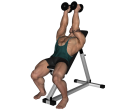 Dumbbell Press - Incline Inwards
Dumbbell Press - Incline Inwards
Benefits: This exercise works the chest muscles with a focus on your upper pecs.
Purpose: This exercise is used to target the upper pecs muscle to develop size, definition, strength, endurance and power.
Beginner Chest Triceps Shoulders Strength Dumbbell Incline Bench Push Compound Gym
General Info: The chest is composed of the Pectoralis Major and the Pectoralis Minor. The Pec Major attaches to the upper arm and pulls the upper arm across the chest. The Pec Minor lies mostly underneath the Pec Major and draws the shoulder blade down and forward.
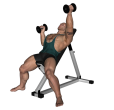 Dumbbell Press - Incline Inwards Alternate
Dumbbell Press - Incline Inwards Alternate
Benefits: This exercise works the chest muscles with a focus on your upper pecs.
Purpose: This exercise is used to target the upper pecs muscle to develop size, definition, strength, endurance and power.
Beginner Chest Triceps Shoulders Strength Dumbbell Incline Bench Push Compound Gym
General Info: The chest is composed of the Pectoralis Major and the Pectoralis Minor. The Pec Major attaches to the upper arm and pulls the upper arm across the chest. The Pec Minor lies mostly underneath the Pec Major and draws the shoulder blade down and forward.
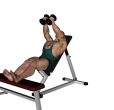 Dumbbell Press - Incline Inwards Feet Up
Dumbbell Press - Incline Inwards Feet Up
Benefits: This exercise works the chest muscles with a focus on your upper pecs.
Purpose: This exercise is used to target the upper pecs muscle to develop size, definition, strength, endurance and power.
Beginner Chest Triceps Shoulders Strength Dumbbell Incline Bench Push Compound Gym
General Info: The chest is composed of the Pectoralis Major and the Pectoralis Minor. The Pec Major attaches to the upper arm and pulls the upper arm across the chest. The Pec Minor lies mostly underneath the Pec Major and draws the shoulder blade down and forward.
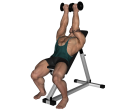 Dumbbell Press - Incline Reverse
Dumbbell Press - Incline Reverse
Benefits: This exercise works the chest muscles with a focus on your upper pecs.
Purpose: This exercise is used to target the upper pecs muscle to develop size, definition, strength, endurance and power.
Beginner Chest Triceps Shoulders Strength Dumbbell Incline Bench Push Compound Gym
General Info: The chest is composed of the Pectoralis Major and the Pectoralis Minor. The Pec Major attaches to the upper arm and pulls the upper arm across the chest. The Pec Minor lies mostly underneath the Pec Major and draws the shoulder blade down and forward.
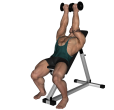 Dumbbell Press - Incline Reverse Alternate
Dumbbell Press - Incline Reverse Alternate
Benefits: This exercise works the chest muscles with a focus on your upper pecs.
Purpose: This exercise is used to target the upper pecs muscle to develop size, definition, strength, endurance and power.
Beginner Chest Triceps Shoulders Strength Dumbbell Incline Bench Push Compound Gym
General Info: The chest is composed of the Pectoralis Major and the Pectoralis Minor. The Pec Major attaches to the upper arm and pulls the upper arm across the chest. The Pec Minor lies mostly underneath the Pec Major and draws the shoulder blade down and forward.
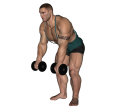 Dumbbell Row - Basic
Dumbbell Row - Basic
Benefits: This exercise is a strong, effective free weight back exercise for building muscle mass and size of the lats.
Purpose: This is a good exercise for increasing strength and size in the upper back.
Intermediate Traps Lats Triceps Posterior Delts Strength Dumbbell Pull Compound Gym
General Info: There are a number of muscles in the back, although the two major muscles are the lats and traps. The lats pulls the arm back and down towards the spine. The traps pull the shoulder blades back and towards the spine.
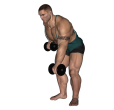 Dumbbell Row - Basic Alternate
Dumbbell Row - Basic Alternate
Benefits: This exercise is a strong, effective free weight back exercise for building muscle mass and size of the lats.
Purpose: This is a good exercise for increasing strength and size in the upper back.
Intermediate Traps Lats Triceps Posterior Delts Strength Dumbbell Pull Compound Gym
General Info: There are a number of muscles in the back, although the two major muscles are the lats and traps. The lats pulls the arm back and down towards the spine. The traps pull the shoulder blades back and towards the spine.
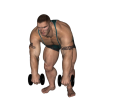 Dumbbell Row - Bent Over
Dumbbell Row - Bent Over
Benefits: This exercise is a strong, effective free weight back exercise for building muscle mass and size of the lats.
Purpose: This is a good exercise for increasing strength and size in the upper back.
Intermediate Traps Lats Triceps Posterior Delts Strength Dumbbell Pull Compound Gym
General Info: There are a number of muscles in the back, although the two major muscles are the lats and traps. The lats pulls the arm back and down towards the spine. The traps pull the shoulder blades back and towards the spine.
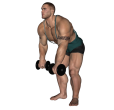 Dumbbell Row - Bent Over Alternate
Dumbbell Row - Bent Over Alternate
Benefits: This exercise is a strong, effective free weight back exercise for building muscle mass and size of the lats.
Purpose: This is a good exercise for increasing strength and size in the upper back.
Intermediate Traps Lats Triceps Posterior Delts Strength Dumbbell Pull Compound Gym
General Info: There are a number of muscles in the back, although the two major muscles are the lats and traps. The lats pulls the arm back and down towards the spine. The traps pull the shoulder blades back and towards the spine.
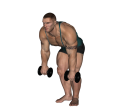 Dumbbell Row - Bent Over Close Stance Alternate
Dumbbell Row - Bent Over Close Stance Alternate
Benefits: This exercise is a strong, effective free weight back exercise for building muscle mass and size of the lats.
Purpose: This is a good exercise for increasing strength and size in the upper back.
Intermediate Traps Lats Triceps Posterior Delts Strength Dumbbell Pull Compound Gym
General Info: There are a number of muscles in the back, although the two major muscles are the lats and traps. The lats pulls the arm back and down towards the spine. The traps pull the shoulder blades back and towards the spine.
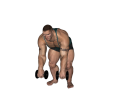 Dumbbell Row - Bent Over Dual
Dumbbell Row - Bent Over Dual
Benefits: This exercise is a strong, effective free weight back exercise for building muscle mass and size of the lats.
Purpose: This is a good exercise for increasing strength and size in the upper back.
Intermediate Traps Lats Triceps Posterior Delts Strength Dumbbell Pull Compound Gym
General Info: There are a number of muscles in the back, although the two major muscles are the lats and traps. The lats pulls the arm back and down towards the spine. The traps pull the shoulder blades back and towards the spine.
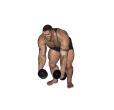 Dumbbell Row - Bent Over Dual Palms In
Dumbbell Row - Bent Over Dual Palms In
Benefits: This exercise is a strong, effective free weight back exercise for building muscle mass and size of the lats.
Purpose: This is a good exercise for increasing strength and size in the upper back.
Intermediate Traps Lats Triceps Posterior Delts Strength Dumbbell Pull Compound Gym
General Info: There are a number of muscles in the back, although the two major muscles are the lats and traps. The lats pulls the arm back and down towards the spine. The traps pull the shoulder blades back and towards the spine.
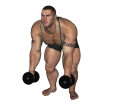 Dumbbell Row - Bent Over Inwards
Dumbbell Row - Bent Over Inwards
Benefits: This exercise is a strong, effective free weight back exercise for building muscle mass and size of the lats.
Purpose: This is a good exercise for increasing strength and size in the upper back.
Intermediate Traps Lats Triceps Posterior Delts Strength Dumbbell Pull Compound Gym
General Info: There are a number of muscles in the back, although the two major muscles are the lats and traps. The lats pulls the arm back and down towards the spine. The traps pull the shoulder blades back and towards the spine.
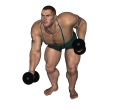 Dumbbell Row - Bent Over Inwards Alternate
Dumbbell Row - Bent Over Inwards Alternate
Benefits: This exercise is a strong, effective free weight back exercise for building muscle mass and size of the lats.
Purpose: This is a good exercise for increasing strength and size in the upper back.
Intermediate Traps Lats Triceps Posterior Delts Strength Dumbbell Pull Compound Gym
General Info: There are a number of muscles in the back, although the two major muscles are the lats and traps. The lats pulls the arm back and down towards the spine. The traps pull the shoulder blades back and towards the spine.
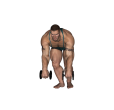 Dumbbell Row - Bent Over Narrow Stance
Dumbbell Row - Bent Over Narrow Stance
Benefits: This exercise is a strong, effective free weight back exercise for building muscle mass and size of the lats.
Purpose: This is a good exercise for increasing strength and size in the upper back.
Intermediate Traps Lats Triceps Posterior Delts Strength Dumbbell Pull Compound Gym
General Info: There are a number of muscles in the back, although the two major muscles are the lats and traps. The lats pulls the arm back and down towards the spine. The traps pull the shoulder blades back and towards the spine.
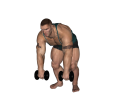 Dumbbell Row - Bent Over Rotation
Dumbbell Row - Bent Over Rotation
Benefits: This exercise is a strong, effective free weight back exercise for building muscle mass and size of the lats.
Purpose: This is a good exercise for increasing strength and size in the upper back.
Intermediate Traps Lats Triceps Posterior Delts Strength Dumbbell Pull Compound Gym
General Info: There are a number of muscles in the back, although the two major muscles are the lats and traps. The lats pulls the arm back and down towards the spine. The traps pull the shoulder blades back and towards the spine.
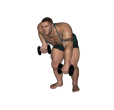 Dumbbell Row - Bent Over Rotation Alternate
Dumbbell Row - Bent Over Rotation Alternate
Benefits: This exercise is a strong, effective free weight back exercise for building muscle mass and size of the lats.
Purpose: This is a good exercise for increasing strength and size in the upper back.
Intermediate Traps Lats Triceps Posterior Delts Strength Dumbbell Pull Compound Gym
General Info: There are a number of muscles in the back, although the two major muscles are the lats and traps. The lats pulls the arm back and down towards the spine. The traps pull the shoulder blades back and towards the spine.
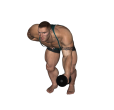 Dumbbell Row - Bent Over Single Inwards
Dumbbell Row - Bent Over Single Inwards
Benefits: This exercise is a strong, effective free weight back exercise for building muscle mass and size of the lats.
Purpose: This is a good exercise for increasing strength and size in the upper back.
Intermediate Traps Lats Triceps Posterior Delts Strength Dumbbell Pull Compound Gym
General Info: There are a number of muscles in the back, although the two major muscles are the lats and traps. The lats pulls the arm back and down towards the spine. The traps pull the shoulder blades back and towards the spine.
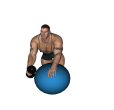 Dumbbell Row - Fitness Ball Inwards
Dumbbell Row - Fitness Ball Inwards
Benefits: This exercise is a strong, effective free weight back exercise for building muscle mass and size of the lats.
Purpose: This is a good exercise for increasing strength and size in the upper back.
Intermediate Traps Lats Triceps Posterior Delts Strength Dumbbell Fitness Ball Pull Compound Gym
General Info: There are a number of muscles in the back, although the two major muscles are the lats and traps. The lats pulls the arm back and down towards the spine. The traps pull the shoulder blades back and towards the spine.
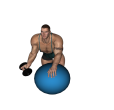 Dumbbell Row - Fitness Ball Rotation Version 1
Dumbbell Row - Fitness Ball Rotation Version 1
Benefits: This exercise is a strong, effective free weight back exercise for building muscle mass and size of the lats.
Purpose: This is a good exercise for increasing strength and size in the upper back.
Intermediate Traps Lats Triceps Posterior Delts Strength Dumbbell Fitness Ball Pull Compound Gym
General Info: There are a number of muscles in the back, although the two major muscles are the lats and traps. The lats pulls the arm back and down towards the spine. The traps pull the shoulder blades back and towards the spine.
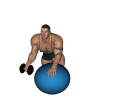 Dumbbell Row - Fitness Ball Rotation Version 2
Dumbbell Row - Fitness Ball Rotation Version 2
Benefits: This exercise is a strong, effective free weight back exercise for building muscle mass and size of the lats.
Purpose: This is a good exercise for increasing strength and size in the upper back.
Intermediate Traps Lats Triceps Posterior Delts Strength Dumbbell Fitness Ball Pull Compound Gym
General Info: There are a number of muscles in the back, although the two major muscles are the lats and traps. The lats pulls the arm back and down towards the spine. The traps pull the shoulder blades back and towards the spine.
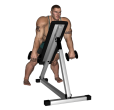 Dumbbell Row - Incline
Dumbbell Row - Incline
Benefits: This exercise is a strong, effective free weight back exercise for building muscle mass and size of the lats.
Purpose: This is a good exercise for increasing strength and size in the upper back.
Intermediate Traps Lats Triceps Posterior Delts Strength Dumbbell Incline Bench Pull Compound Gym
General Info: There are a number of muscles in the back, although the two major muscles are the lats and traps. The lats pulls the arm back and down towards the spine. The traps pull the shoulder blades back and towards the spine.
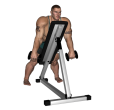 Dumbbell Row - Incline Alternate
Dumbbell Row - Incline Alternate
Benefits: This exercise is a strong, effective free weight back exercise for building muscle mass and size of the lats.
Purpose: This is a good exercise for increasing strength and size in the upper back.
Intermediate Traps Lats Triceps Posterior Delts Strength Dumbbell Incline Bench Pull Compound Gym
General Info: There are a number of muscles in the back, although the two major muscles are the lats and traps. The lats pulls the arm back and down towards the spine. The traps pull the shoulder blades back and towards the spine.
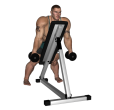 Dumbbell Row - Incline Inwards
Dumbbell Row - Incline Inwards
Benefits: This exercise is a strong, effective free weight back exercise for building muscle mass and size of the lats.
Purpose: This is a good exercise for increasing strength and size in the upper back.
Intermediate Traps Lats Triceps Posterior Delts Strength Dumbbell Incline Bench Pull Compound Gym
General Info: There are a number of muscles in the back, although the two major muscles are the lats and traps. The lats pulls the arm back and down towards the spine. The traps pull the shoulder blades back and towards the spine.
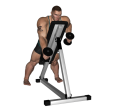 Dumbbell Row - Incline Inwards Alternate
Dumbbell Row - Incline Inwards Alternate
Benefits: This exercise is a strong, effective free weight back exercise for building muscle mass and size of the lats.
Purpose: This is a good exercise for increasing strength and size in the upper back.
Intermediate Traps Lats Triceps Posterior Delts Strength Dumbbell Incline Bench Pull Compound Gym
General Info: There are a number of muscles in the back, although the two major muscles are the lats and traps. The lats pulls the arm back and down towards the spine. The traps pull the shoulder blades back and towards the spine.
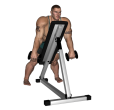 Dumbbell Row - Incline Rotation
Dumbbell Row - Incline Rotation
Benefits: This exercise is a strong, effective free weight back exercise for building muscle mass and size of the lats.
Purpose: This is a good exercise for increasing strength and size in the upper back.
Intermediate Traps Lats Triceps Posterior Delts Strength Dumbbell Incline Bench Pull Compound Gym
General Info: There are a number of muscles in the back, although the two major muscles are the lats and traps. The lats pulls the arm back and down towards the spine. The traps pull the shoulder blades back and towards the spine.
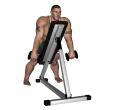 Dumbbell Row - Incline Rotation Alternate
Dumbbell Row - Incline Rotation Alternate
Benefits: This exercise is a strong, effective free weight back exercise for building muscle mass and size of the lats.
Purpose: This is a good exercise for increasing strength and size in the upper back.
Intermediate Traps Lats Triceps Posterior Delts Strength Dumbbell Incline Bench Pull Compound Gym
General Info: There are a number of muscles in the back, although the two major muscles are the lats and traps. The lats pulls the arm back and down towards the spine. The traps pull the shoulder blades back and towards the spine.
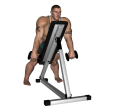 Dumbbell Row - Incline Single
Dumbbell Row - Incline Single
Benefits: This exercise is a strong, effective free weight back exercise for building muscle mass and size of the lats.
Purpose: This is a good exercise for increasing strength and size in the upper back.
Intermediate Traps Lats Triceps Posterior Delts Strength Dumbbell Incline Bench Pull Compound Gym
General Info: There are a number of muscles in the back, although the two major muscles are the lats and traps. The lats pulls the arm back and down towards the spine. The traps pull the shoulder blades back and towards the spine.
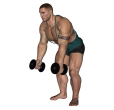 Dumbbell Row - Inwards
Dumbbell Row - Inwards
Benefits: This exercise is a strong, effective free weight back exercise for building muscle mass and size of the lats.
Purpose: This is a good exercise for increasing strength and size in the upper back.
Intermediate Traps Lats Triceps Posterior Delts Strength Dumbbell Pull Compound Gym
General Info: There are a number of muscles in the back, although the two major muscles are the lats and traps. The lats pulls the arm back and down towards the spine. The traps pull the shoulder blades back and towards the spine.
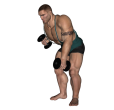 Dumbbell Row - Inwards Alternate
Dumbbell Row - Inwards Alternate
Benefits: This exercise is a strong, effective free weight back exercise for building muscle mass and size of the lats.
Purpose: This is a good exercise for increasing strength and size in the upper back.
Intermediate Traps Lats Triceps Posterior Delts Strength Dumbbell Pull Compound Gym
General Info: There are a number of muscles in the back, although the two major muscles are the lats and traps. The lats pulls the arm back and down towards the spine. The traps pull the shoulder blades back and towards the spine.
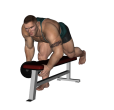 Dumbbell Row - One Arm
Dumbbell Row - One Arm
Benefits: This exercise is a strong, effective free weight back exercise for building muscle mass and size of the lats.
Purpose: This is a good exercise for increasing strength and size in the upper back.
Intermediate Traps Lats Triceps Posterior Delts Strength Dumbbell Pull Compound Gym
General Info: There are a number of muscles in the back, although the two major muscles are the lats and traps. The lats pulls the arm back and down towards the spine. The traps pull the shoulder blades back and towards the spine.
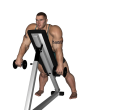 Dumbbell Row - Overhang
Dumbbell Row - Overhang
Benefits: This exercise is a strong, effective free weight back exercise for building muscle mass and size of the lats.
Purpose: This is a good exercise for increasing strength and size in the upper back.
Intermediate Traps Lats Triceps Posterior Delts Strength Dumbbell Incline Bench Pull Compound Gym
General Info: There are a number of muscles in the back, although the two major muscles are the lats and traps. The lats pulls the arm back and down towards the spine. The traps pull the shoulder blades back and towards the spine.
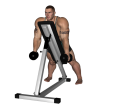 Dumbbell Row - Overhang Inwards
Dumbbell Row - Overhang Inwards
Benefits: This exercise is a strong, effective free weight back exercise for building muscle mass and size of the lats.
Purpose: This is a good exercise for increasing strength and size in the upper back.
Intermediate Traps Lats Triceps Posterior Delts Strength Dumbbell Incline Bench Pull Compound Gym
General Info: There are a number of muscles in the back, although the two major muscles are the lats and traps. The lats pulls the arm back and down towards the spine. The traps pull the shoulder blades back and towards the spine.
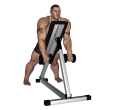 Dumbbell Row - Overhang Single
Dumbbell Row - Overhang Single
Benefits: This exercise is a strong, effective free weight back exercise for building muscle mass and size of the lats.
Purpose: This is a good exercise for increasing strength and size in the upper back.
Intermediate Traps Lats Triceps Posterior Delts Strength Dumbbell Incline Bench Pull Compound Gym
General Info: There are a number of muscles in the back, although the two major muscles are the lats and traps. The lats pulls the arm back and down towards the spine. The traps pull the shoulder blades back and towards the spine.
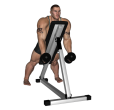 Dumbbell Row - Overhang Single Inwards
Dumbbell Row - Overhang Single Inwards
Benefits: This exercise is a strong, effective free weight back exercise for building muscle mass and size of the lats.
Purpose: This is a good exercise for increasing strength and size in the upper back.
Intermediate Traps Lats Triceps Posterior Delts Strength Dumbbell Incline Bench Pull Compound Gym
General Info: There are a number of muscles in the back, although the two major muscles are the lats and traps. The lats pulls the arm back and down towards the spine. The traps pull the shoulder blades back and towards the spine.
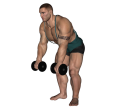 Dumbbell Row - Rotation
Dumbbell Row - Rotation
Benefits: This exercise is a strong, effective free weight back exercise for building muscle mass and size of the lats.
Purpose: This is a good exercise for increasing strength and size in the upper back.
Intermediate Traps Lats Triceps Posterior Delts Strength Dumbbell Pull Compound Gym
General Info: There are a number of muscles in the back, although the two major muscles are the lats and traps. The lats pulls the arm back and down towards the spine. The traps pull the shoulder blades back and towards the spine.
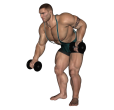 Dumbbell Row - Rotation Alternate
Dumbbell Row - Rotation Alternate
Benefits: This exercise is a strong, effective free weight back exercise for building muscle mass and size of the lats.
Purpose: This is a good exercise for increasing strength and size in the upper back.
Intermediate Traps Lats Triceps Posterior Delts Strength Dumbbell Pull Compound Gym
General Info: There are a number of muscles in the back, although the two major muscles are the lats and traps. The lats pulls the arm back and down towards the spine. The traps pull the shoulder blades back and towards the spine.
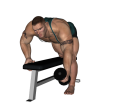 Dumbbell Row - Single Arm Inwards
Dumbbell Row - Single Arm Inwards
Benefits: This exercise is a strong, effective free weight back exercise for building muscle mass and size of the lats.
Purpose: This is a good exercise for increasing strength and size in the upper back.
Intermediate Traps Lats Triceps Posterior Delts Strength Dumbbell Flat Bench Pull Compound Gym
General Info: There are a number of muscles in the back, although the two major muscles are the lats and traps. The lats pulls the arm back and down towards the spine. The traps pull the shoulder blades back and towards the spine.
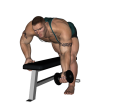 Dumbbell Row - Single Arm Rotation
Dumbbell Row - Single Arm Rotation
Benefits: This exercise is a strong, effective free weight back exercise for building muscle mass and size of the lats.
Purpose: This is a good exercise for increasing strength and size in the upper back.
Intermediate Traps Lats Triceps Posterior Delts Strength Dumbbell Flat Bench Pull Compound Gym
General Info: There are a number of muscles in the back, although the two major muscles are the lats and traps. The lats pulls the arm back and down towards the spine. The traps pull the shoulder blades back and towards the spine.
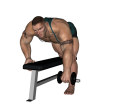 Dumbbell Row - Single Arm Rotation Variation
Dumbbell Row - Single Arm Rotation Variation
Benefits: This exercise is a strong, effective free weight back exercise for building muscle mass and size of the lats.
Purpose: This is a good exercise for increasing strength and size in the upper back.
Intermediate Traps Lats Triceps Posterior Delts Strength Dumbbell Flat Bench Pull Compound Gym
General Info: There are a number of muscles in the back, although the two major muscles are the lats and traps. The lats pulls the arm back and down towards the spine. The traps pull the shoulder blades back and towards the spine.
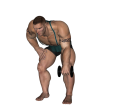 Dumbbell Row - Single Bent Knee
Dumbbell Row - Single Bent Knee
Benefits: This exercise is a strong, effective free weight back exercise for building muscle mass and size of the lats.
Purpose: This is a good exercise for increasing strength and size in the upper back.
Intermediate Traps Lats Triceps Posterior Delts Strength Dumbbell Pull Compound Gym
General Info: There are a number of muscles in the back, although the two major muscles are the lats and traps. The lats pulls the arm back and down towards the spine. The traps pull the shoulder blades back and towards the spine.
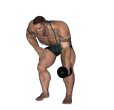 Dumbbell Row - Single Bent Knee Inwards
Dumbbell Row - Single Bent Knee Inwards
Benefits: This exercise is a strong, effective free weight back exercise for building muscle mass and size of the lats.
Purpose: This is a good exercise for increasing strength and size in the upper back.
Intermediate Traps Lats Triceps Posterior Delts Strength Dumbbell Pull Compound Gym
General Info: There are a number of muscles in the back, although the two major muscles are the lats and traps. The lats pulls the arm back and down towards the spine. The traps pull the shoulder blades back and towards the spine.
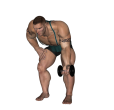 Dumbbell Row - Single Bent Knee Rotation
Dumbbell Row - Single Bent Knee Rotation
Benefits: This exercise is a strong, effective free weight back exercise for building muscle mass and size of the lats.
Purpose: This is a good exercise for increasing strength and size in the upper back.
Intermediate Traps Lats Triceps Posterior Delts Strength Dumbbell Pull Compound Gym
General Info: There are a number of muscles in the back, although the two major muscles are the lats and traps. The lats pulls the arm back and down towards the spine. The traps pull the shoulder blades back and towards the spine.
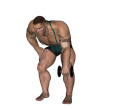 Dumbbell Row - Single Bent Knee Rotation Variation
Dumbbell Row - Single Bent Knee Rotation Variation
Benefits: This exercise is a strong, effective free weight back exercise for building muscle mass and size of the lats.
Purpose: This is a good exercise for increasing strength and size in the upper back.
Intermediate Traps Lats Triceps Posterior Delts Strength Dumbbell Pull Compound Gym
General Info: There are a number of muscles in the back, although the two major muscles are the lats and traps. The lats pulls the arm back and down towards the spine. The traps pull the shoulder blades back and towards the spine.
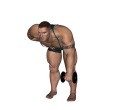 Dumbbell Row - Single Bent Over
Dumbbell Row - Single Bent Over
Benefits: This exercise is a strong, effective free weight back exercise for building muscle mass and size of the lats.
Purpose: This is a good exercise for increasing strength and size in the upper back.
Intermediate Traps Lats Triceps Posterior Delts Strength Dumbbell Pull Compound Gym
General Info: There are a number of muscles in the back, although the two major muscles are the lats and traps. The lats pulls the arm back and down towards the spine. The traps pull the shoulder blades back and towards the spine.
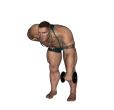 Dumbbell Row - Single Bent Over Rotation
Dumbbell Row - Single Bent Over Rotation
Benefits: This exercise is a strong, effective free weight back exercise for building muscle mass and size of the lats.
Purpose: This is a good exercise for increasing strength and size in the upper back.
Intermediate Traps Lats Triceps Posterior Delts Strength Dumbbell Pull Compound Gym
General Info: There are a number of muscles in the back, although the two major muscles are the lats and traps. The lats pulls the arm back and down towards the spine. The traps pull the shoulder blades back and towards the spine.
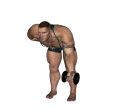 Dumbbell Row - Single Bent Over Rotation Variation
Dumbbell Row - Single Bent Over Rotation Variation
Benefits: This exercise is a strong, effective free weight back exercise for building muscle mass and size of the lats.
Purpose: This is a good exercise for increasing strength and size in the upper back.
Intermediate Traps Lats Triceps Posterior Delts Strength Dumbbell Pull Compound Gym
General Info: There are a number of muscles in the back, although the two major muscles are the lats and traps. The lats pulls the arm back and down towards the spine. The traps pull the shoulder blades back and towards the spine.
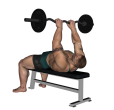 EZ Bar Press - Flat Bench Close Grip
EZ Bar Press - Flat Bench Close Grip
Benefits: This exercise works both heads of the triceps with a heavier weight than can typically be done with dumbbells.
Purpose: This exercise is used to target the triceps muscle to develop size, definition, strength, endurance and power.
Beginner Triceps Chest Shoulders Strength EZ Bar Flat Bench Push Compound Gym
General Info: The triceps is a straight muscle with three heads. The long head straightens the elbow, adducts the shoulder (brings it from a side position to the body) and extends the shoulder (brings the arm from a front position down to the body). The lateral head (outer head) straightens the elbow. The medial head also straightens the elbow.
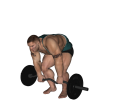 EZ Bar Row - Basic
EZ Bar Row - Basic
Benefits: This exercise is a strong, effective free weight back exercise for building muscle mass and size of the lats.
Purpose: This is a good exercise for increasing strength and size in the upper back.
Intermediate Traps Lats Triceps Posterior Delts Strength EZ Bar Pull Compound Gym
General Info: There are a number of muscles in the back, although the two major muscles are the lats and traps. The lats pulls the arm back and down towards the spine. The traps pull the shoulder blades back and towards the spine.
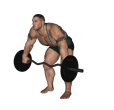 EZ Bar Row - Basic Wide Grip
EZ Bar Row - Basic Wide Grip
Benefits: This exercise is a strong, effective free weight back exercise for building muscle mass and size of the lats.
Purpose: This is a good exercise for increasing strength and size in the upper back.
Intermediate Traps Lats Triceps Posterior Delts Strength EZ Bar Pull Compound Gym
General Info: There are a number of muscles in the back, although the two major muscles are the lats and traps. The lats pulls the arm back and down towards the spine. The traps pull the shoulder blades back and towards the spine.
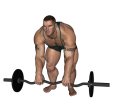 EZ Bar Row - Bent Over
EZ Bar Row - Bent Over
Benefits: This exercise is a strong, effective free weight back exercise for building muscle mass and size of the lats.
Purpose: This is a good exercise for increasing strength and size in the upper back.
Intermediate Traps Lats Triceps Posterior Delts Strength EZ Bar Pull Compound Gym
General Info: There are a number of muscles in the back, although the two major muscles are the lats and traps. The lats pulls the arm back and down towards the spine. The traps pull the shoulder blades back and towards the spine.
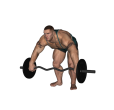 EZ Bar Row - Bent Over Wide Grip
EZ Bar Row - Bent Over Wide Grip
Benefits: This exercise is a strong, effective free weight back exercise for building muscle mass and size of the lats.
Purpose: This is a good exercise for increasing strength and size in the upper back.
Intermediate Traps Lats Triceps Posterior Delts Strength EZ Bar Pull Compound Gym
General Info: There are a number of muscles in the back, although the two major muscles are the lats and traps. The lats pulls the arm back and down towards the spine. The traps pull the shoulder blades back and towards the spine.
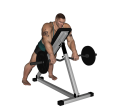 EZ Bar Row - Incline Bench
EZ Bar Row - Incline Bench
Benefits: This exercise is a strong, effective free weight back exercise for building muscle mass and size of the lats.
Purpose: This is a good exercise for increasing strength and size in the upper back.
Intermediate Traps Lats Triceps Posterior Delts Strength EZ Bar Incline Bench Pull Compound Gym
General Info: There are a number of muscles in the back, although the two major muscles are the lats and traps. The lats pulls the arm back and down towards the spine. The traps pull the shoulder blades back and towards the spine.
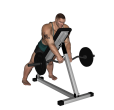 EZ Bar Row - Incline Close Grip
EZ Bar Row - Incline Close Grip
Benefits: This exercise is a strong, effective free weight back exercise for building muscle mass and size of the lats.
Purpose: This is a good exercise for increasing strength and size in the upper back.
Intermediate Traps Lats Triceps Posterior Delts Strength EZ Bar Incline Bench Pull Compound Gym
General Info: There are a number of muscles in the back, although the two major muscles are the lats and traps. The lats pulls the arm back and down towards the spine. The traps pull the shoulder blades back and towards the spine.
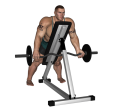 EZ Bar Row - Incline Mixed Grip
EZ Bar Row - Incline Mixed Grip
Benefits: This exercise is a strong, effective free weight back exercise for building muscle mass and size of the lats.
Purpose: This is a good exercise for increasing strength and size in the upper back.
Intermediate Traps Lats Triceps Posterior Delts Strength EZ Bar Incline Bench Pull Compound Gym
General Info: There are a number of muscles in the back, although the two major muscles are the lats and traps. The lats pulls the arm back and down towards the spine. The traps pull the shoulder blades back and towards the spine.
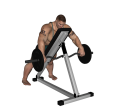 EZ Bar Row - Incline Wide Grip
EZ Bar Row - Incline Wide Grip
Benefits: This exercise is a strong, effective free weight back exercise for building muscle mass and size of the lats.
Purpose: This is a good exercise for increasing strength and size in the upper back.
Intermediate Traps Lats Triceps Posterior Delts Strength EZ Bar Incline Bench Pull Compound Gym
General Info: There are a number of muscles in the back, although the two major muscles are the lats and traps. The lats pulls the arm back and down towards the spine. The traps pull the shoulder blades back and towards the spine.
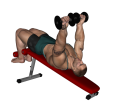 Flye - Decline Dumbbell and Reverse Press
Flye - Decline Dumbbell and Reverse Press
Benefits: A barbell allows someone to lift heavier weights and thus build more strength quicker.
Purpose: This exercise increases strength and strength speed, and produces greater functional strength for pressing movements.
Intermediate Chest Triceps Anterior Delts Strength Dumbbell Decline Bench Push Compound Gym
General Info: The chest is composed of the Pectoralis Major and the Pectoralis Minor. The Pec Major attaches to the upper arm and pulls the upper arm across the chest. The Pec Minor lies mostly underneath the Pec Major and draws the shoulder blade down and forward.
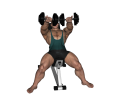 Flye - Incline Dumbbell and Reverse Press
Flye - Incline Dumbbell and Reverse Press
Benefits: A barbell allows someone to lift heavier weights and thus build more strength quicker.
Purpose: This exercise increases strength and strength speed, and produces greater functional strength for pressing movements.
Intermediate Chest Triceps Anterior Delts Strength Dumbbell Incline Bench Push Compound Gym
General Info: The chest is composed of the Pectoralis Major and the Pectoralis Minor. The Pec Major attaches to the upper arm and pulls the upper arm across the chest. The Pec Minor lies mostly underneath the Pec Major and draws the shoulder blade down and forward.
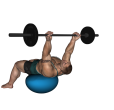 French Press - Ball Reverse Barbell Close Grip
French Press - Ball Reverse Barbell Close Grip
Benefits: The exercise eliminates isolates the triceps.
Purpose: This exercise works primarily the triceps.
Beginner Triceps Strength Barbell Fitness Ball Push Gym
General Info: The triceps is a straight muscle with three heads. The long head straightens the elbow, adducts the shoulder (brings it from a side position to the body) and extends the shoulder (brings the arm from a front position down to the body). The lateral head (outer head) straightens the elbow. The medial head also straightens the elbow.
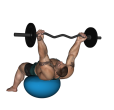 French Press - Ball Reverse EZ Bar Narrow Stance
French Press - Ball Reverse EZ Bar Narrow Stance
Benefits: The exercise eliminates isolates the triceps.
Purpose: This exercise works primarily the triceps.
Beginner Triceps Strength EZ Bar Fitness Ball Push Gym
General Info: The triceps is a straight muscle with three heads. The long head straightens the elbow, adducts the shoulder (brings it from a side position to the body) and extends the shoulder (brings the arm from a front position down to the body). The lateral head (outer head) straightens the elbow. The medial head also straightens the elbow.
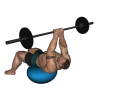 French Press - Fitness Ball Barbell Close Grip
French Press - Fitness Ball Barbell Close Grip
Benefits: The exercise eliminates isolates the triceps.
Purpose: This exercise works primarily the triceps.
Beginner Triceps Strength Barbell Fitness Ball Push Gym
General Info: The triceps is a straight muscle with three heads. The long head straightens the elbow, adducts the shoulder (brings it from a side position to the body) and extends the shoulder (brings the arm from a front position down to the body). The lateral head (outer head) straightens the elbow. The medial head also straightens the elbow.
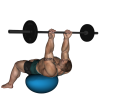 French Press - Fitness Ball Barbell Reverse
French Press - Fitness Ball Barbell Reverse
Benefits: The exercise eliminates isolates the triceps. The reverse grip makes the exercise more difficult.
Purpose: This exercise works primarily the triceps.
Beginner Triceps Strength Barbell Fitness Ball Push Gym
General Info: The triceps is a straight muscle with three heads. The long head straightens the elbow, adducts the shoulder (brings it from a side position to the body) and extends the shoulder (brings the arm from a front position down to the body). The lateral head (outer head) straightens the elbow. The medial head also straightens the elbow.
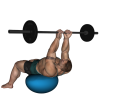 French Press - Fitness Ball Barbell Reverse Close
French Press - Fitness Ball Barbell Reverse Close
Benefits: The exercise eliminates isolates the triceps. The reverse grip makes the exercise more difficult.
Purpose: This exercise works primarily the triceps.
Beginner Triceps Strength Barbell Fitness Ball Push Gym
General Info: The triceps is a straight muscle with three heads. The long head straightens the elbow, adducts the shoulder (brings it from a side position to the body) and extends the shoulder (brings the arm from a front position down to the body). The lateral head (outer head) straightens the elbow. The medial head also straightens the elbow.
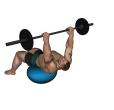 French Press - Fitness Ball Barbell Straight Grip
French Press - Fitness Ball Barbell Straight Grip
Benefits: The exercise eliminates isolates the triceps.
Purpose: This exercise works primarily the triceps.
Beginner Triceps Strength Barbell Fitness Ball Push Gym
General Info: The triceps is a straight muscle with three heads. The long head straightens the elbow, adducts the shoulder (brings it from a side position to the body) and extends the shoulder (brings the arm from a front position down to the body). The lateral head (outer head) straightens the elbow. The medial head also straightens the elbow.
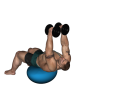 French Press - Fitness Ball Dumbbell
French Press - Fitness Ball Dumbbell
Benefits: The exercise eliminates isolates the triceps.
Purpose: This exercise works primarily the triceps.
Beginner Triceps Strength Dumbbell Fitness Ball Push Gym
General Info: The triceps is a straight muscle with three heads. The long head straightens the elbow, adducts the shoulder (brings it from a side position to the body) and extends the shoulder (brings the arm from a front position down to the body). The lateral head (outer head) straightens the elbow. The medial head also straightens the elbow.
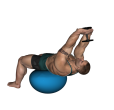 French Press - Fitness Ball Dumbbell 2 Handed
French Press - Fitness Ball Dumbbell 2 Handed
Benefits: This exercise works all heads of the triceps.
Purpose: This exercise is used to target the triceps muscle to develop size, definition, strength, endurance and power.
Beginner Triceps Strength Dumbbell Fitness Ball Push Gym
General Info: The triceps muscle group are straight muscles with three heads. All three heads straighten the elbow while the long head, crossing the shoulder joint also adducts the shoulder (pulls it down from the side) and extends the shoulder (pulls it down from the front).
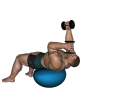 French Press - Fitness Ball Dumbbell Alternate
French Press - Fitness Ball Dumbbell Alternate
Benefits: The exercise eliminates isolates the triceps.
Purpose: This exercise works primarily the triceps.
Beginner Triceps Strength Dumbbell Fitness Ball Push Gym
General Info: The triceps is a straight muscle with three heads. The long head straightens the elbow, adducts the shoulder (brings it from a side position to the body) and extends the shoulder (brings the arm from a front position down to the body). The lateral head (outer head) straightens the elbow. The medial head also straightens the elbow.
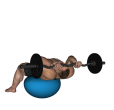 French Press - Fitness Ball EZ Bar
French Press - Fitness Ball EZ Bar
Benefits: The exercise eliminates isolates the triceps.
Purpose: This exercise works primarily the triceps.
Beginner Triceps Strength EZ Bar Fitness Ball Push Gym
General Info: The triceps is a straight muscle with three heads. The long head straightens the elbow, adducts the shoulder (brings it from a side position to the body) and extends the shoulder (brings the arm from a front position down to the body). The lateral head (outer head) straightens the elbow. The medial head also straightens the elbow.
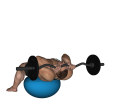 French Press - Fitness Ball EZ Bar Close Grip
French Press - Fitness Ball EZ Bar Close Grip
Benefits: The exercise eliminates isolates the triceps.
Purpose: This exercise works primarily the triceps.
Beginner Triceps Strength EZ Bar Fitness Ball Push Gym
General Info: The triceps is a straight muscle with three heads. The long head straightens the elbow, adducts the shoulder (brings it from a side position to the body) and extends the shoulder (brings the arm from a front position down to the body). The lateral head (outer head) straightens the elbow. The medial head also straightens the elbow.
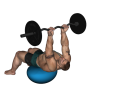 French Press - Fitness Ball EZ Bar Reverse
French Press - Fitness Ball EZ Bar Reverse
Benefits: The exercise eliminates isolates the triceps. The reverse grip makes the exercise more difficult.
Purpose: This exercise works primarily the triceps.
Beginner Triceps Strength EZ Bar Fitness Ball Push Gym
General Info: The triceps is a straight muscle with three heads. The long head straightens the elbow, adducts the shoulder (brings it from a side position to the body) and extends the shoulder (brings the arm from a front position down to the body). The lateral head (outer head) straightens the elbow. The medial head also straightens the elbow.
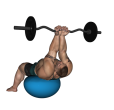 French Press - Fitness Ball EZ Bar Reverse Close
French Press - Fitness Ball EZ Bar Reverse Close
Benefits: The exercise eliminates isolates the triceps.
Purpose: This exercise works primarily the triceps.
Beginner Triceps Strength EZ Bar Fitness Ball Push Gym
General Info: The triceps is a straight muscle with three heads. The long head straightens the elbow, adducts the shoulder (brings it from a side position to the body) and extends the shoulder (brings the arm from a front position down to the body). The lateral head (outer head) straightens the elbow. The medial head also straightens the elbow.
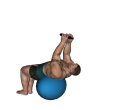 French Press - Fitness Ball Plate
French Press - Fitness Ball Plate
Benefits: This exercise works all heads of the triceps.
Purpose: This exercise is used to target the triceps muscle to develop size, definition, strength, endurance and power.
Beginner Triceps Strength Plate Fitness Ball Push Gym
General Info: The triceps muscle group are straight muscles with three heads. All three heads straighten the elbow while the long head, crossing the shoulder joint also adducts the shoulder (pulls it down from the side) and extends the shoulder (pulls it down from the front).
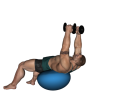 French Press - Fitness Ball Single Dumbbell
French Press - Fitness Ball Single Dumbbell
Benefits: The exercise eliminates isolates the triceps.
Purpose: This exercise works primarily the triceps.
Beginner Triceps Strength Dumbbell Fitness Ball Push Gym
General Info: The triceps is a straight muscle with three heads. The long head straightens the elbow, adducts the shoulder (brings it from a side position to the body) and extends the shoulder (brings the arm from a front position down to the body). The lateral head (outer head) straightens the elbow. The medial head also straightens the elbow.
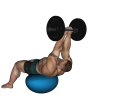 French Press - Fitness Ball Tricep Barbell
French Press - Fitness Ball Tricep Barbell
Benefits: The exercise eliminates isolates the triceps.
Purpose: This exercise works primarily the triceps.
Beginner Triceps Strength Tricep Barbell Fitness Ball Push Gym
General Info: The triceps is a straight muscle with three heads. The long head straightens the elbow, adducts the shoulder (brings it from a side position to the body) and extends the shoulder (brings the arm from a front position down to the body). The lateral head (outer head) straightens the elbow. The medial head also straightens the elbow.
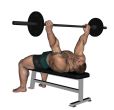 French Press - Flat Barbell Wide Grip
French Press - Flat Barbell Wide Grip
Benefits: The exercise eliminates isolates the triceps.
Purpose: This exercise works primarily the triceps.
Beginner Triceps Strength Barbell Flat Bench Push Gym
General Info: The triceps is a straight muscle with three heads. The long head straightens the elbow, adducts the shoulder (brings it from a side position to the body) and extends the shoulder (brings the arm from a front position down to the body). The lateral head (outer head) straightens the elbow. The medial head also straightens the elbow.
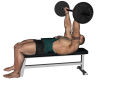 French Press - Flat Bench Barbell
French Press - Flat Bench Barbell
Benefits: The exercise eliminates isolates the triceps.
Purpose: This exercise works primarily the triceps.
Beginner Triceps Strength Barbell Flat Bench Push Gym
General Info: The triceps is a straight muscle with three heads. The long head straightens the elbow, adducts the shoulder (brings it from a side position to the body) and extends the shoulder (brings the arm from a front position down to the body). The lateral head (outer head) straightens the elbow. The medial head also straightens the elbow.
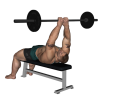 French Press - Flat Bench Barbell Close Grip
French Press - Flat Bench Barbell Close Grip
Benefits: The exercise eliminates isolates the triceps.
Purpose: This exercise works primarily the triceps.
Beginner Triceps Strength Barbell Flat Bench Push Gym
General Info: The triceps is a straight muscle with three heads. The long head straightens the elbow, adducts the shoulder (brings it from a side position to the body) and extends the shoulder (brings the arm from a front position down to the body). The lateral head (outer head) straightens the elbow. The medial head also straightens the elbow.
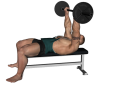 French Press - Flat Bench Barbell Reverse
French Press - Flat Bench Barbell Reverse
Benefits: The exercise eliminates isolates the triceps. The reverse grip makes the exercise more difficult.
Purpose: This exercise works primarily the triceps.
Beginner Triceps Strength Barbell Push Gym
General Info: The triceps is a straight muscle with three heads. The long head straightens the elbow, adducts the shoulder (brings it from a side position to the body) and extends the shoulder (brings the arm from a front position down to the body). The lateral head (outer head) straightens the elbow. The medial head also straightens the elbow.
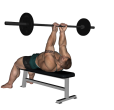 French Press - Flat Bench Barbell Reverse Close
French Press - Flat Bench Barbell Reverse Close
Benefits: The exercise eliminates isolates the triceps. The reverse grip makes the exercise more difficult.
Purpose: This exercise works primarily the triceps.
Beginner Triceps Strength Barbell Flat Bench Push Gym
General Info: The triceps is a straight muscle with three heads. The long head straightens the elbow, adducts the shoulder (brings it from a side position to the body) and extends the shoulder (brings the arm from a front position down to the body). The lateral head (outer head) straightens the elbow. The medial head also straightens the elbow.
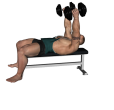 French Press - Flat Bench Dumbbell
French Press - Flat Bench Dumbbell
Benefits: The exercise eliminates isolates the triceps.
Purpose: This exercise works primarily the triceps.
Beginner Triceps Strength Dumbbell Flat Bench Push Gym
General Info: The triceps is a straight muscle with three heads. The long head straightens the elbow, adducts the shoulder (brings it from a side position to the body) and extends the shoulder (brings the arm from a front position down to the body). The lateral head (outer head) straightens the elbow. The medial head also straightens the elbow.
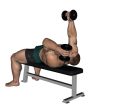 French Press - Flat Bench Dumbbell Feet Up
French Press - Flat Bench Dumbbell Feet Up
Benefits: The exercise eliminates isolates the triceps.
Purpose: This exercise works primarily the triceps.
Beginner Triceps Strength Dumbbell Flat Bench Push Gym
General Info: The triceps is a straight muscle with three heads. The long head straightens the elbow, adducts the shoulder (brings it from a side position to the body) and extends the shoulder (brings the arm from a front position down to the body). The lateral head (outer head) straightens the elbow. The medial head also straightens the elbow.
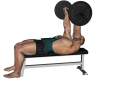 French Press - Flat Bench EZ Bar
French Press - Flat Bench EZ Bar
Benefits: The exercise eliminates isolates the triceps.
Purpose: This exercise works primarily the triceps.
Beginner Triceps Strength EZ Bar Flat Bench Push Gym
General Info: The triceps is a straight muscle with three heads. The long head straightens the elbow, adducts the shoulder (brings it from a side position to the body) and extends the shoulder (brings the arm from a front position down to the body). The lateral head (outer head) straightens the elbow. The medial head also straightens the elbow.
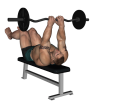 French Press - Flat Bench EZ Bar Close Feet Up
French Press - Flat Bench EZ Bar Close Feet Up
Benefits: The exercise eliminates isolates the triceps. Keeping the feet up ensures that you do not arch the back.
Purpose: This exercise works primarily the triceps.
Beginner Triceps Strength EZ Bar Flat Bench Push Gym
General Info: The triceps is a straight muscle with three heads. The long head straightens the elbow, adducts the shoulder (brings it from a side position to the body) and extends the shoulder (brings the arm from a front position down to the body). The lateral head (outer head) straightens the elbow. The medial head also straightens the elbow.
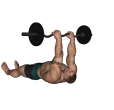 French Press - Flat Bench EZ Bar Close Grip
French Press - Flat Bench EZ Bar Close Grip
Benefits: The exercise eliminates isolates the triceps.
Purpose: This exercise works primarily the triceps.
Beginner Triceps Strength EZ Bar Flat Bench Push Gym
General Info: The triceps is a straight muscle with three heads. The long head straightens the elbow, adducts the shoulder (brings it from a side position to the body) and extends the shoulder (brings the arm from a front position down to the body). The lateral head (outer head) straightens the elbow. The medial head also straightens the elbow.
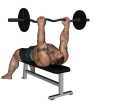 French Press - Flat Bench EZ Bar Feet Up
French Press - Flat Bench EZ Bar Feet Up
Benefits: The exercise eliminates isolates the triceps.
Purpose: This exercise works primarily the triceps.
Beginner Triceps Strength EZ Bar Flat Bench Push Gym
General Info: The triceps is a straight muscle with three heads. The long head straightens the elbow, adducts the shoulder (brings it from a side position to the body) and extends the shoulder (brings the arm from a front position down to the body). The lateral head (outer head) straightens the elbow. The medial head also straightens the elbow.
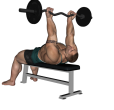 French Press - Flat Bench EZ Bar Reverse
French Press - Flat Bench EZ Bar Reverse
Benefits: The exercise eliminates isolates the triceps.
Purpose: This exercise works primarily the triceps.
Beginner Triceps Strength EZ Bar Flat Bench Push Gym
General Info: The triceps is a straight muscle with three heads. The long head straightens the elbow, adducts the shoulder (brings it from a side position to the body) and extends the shoulder (brings the arm from a front position down to the body). The lateral head (outer head) straightens the elbow. The medial head also straightens the elbow.
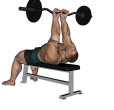 French Press - Flat Bench EZ Bar Reverse Close
French Press - Flat Bench EZ Bar Reverse Close
Benefits: The exercise eliminates isolates the triceps. The reverse grip makes the exercise more difficult.
Purpose: This exercise works primarily the triceps.
Beginner Triceps Strength EZ Bar Flat Bench Push Gym
General Info: The triceps is a straight muscle with three heads. The long head straightens the elbow, adducts the shoulder (brings it from a side position to the body) and extends the shoulder (brings the arm from a front position down to the body). The lateral head (outer head) straightens the elbow. The medial head also straightens the elbow.
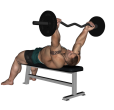 French Press - Flat Bench EZ Reverse Feet Up
French Press - Flat Bench EZ Reverse Feet Up
Benefits: The exercise eliminates isolates the triceps.
Purpose: This exercise works primarily the triceps.
Beginner Triceps Strength EZ Bar Flat Bench Push Gym
General Info: The triceps is a straight muscle with three heads. The long head straightens the elbow, adducts the shoulder (brings it from a side position to the body) and extends the shoulder (brings the arm from a front position down to the body). The lateral head (outer head) straightens the elbow. The medial head also straightens the elbow.
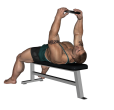 French Press - Flat Bench Plate
French Press - Flat Bench Plate
Benefits: The exercise eliminates isolates the triceps.
Purpose: This exercise works primarily the triceps.
Beginner Triceps Strength Plate Flat Bench Push Gym
General Info: The triceps is a straight muscle with three heads. The long head straightens the elbow, adducts the shoulder (brings it from a side position to the body) and extends the shoulder (brings the arm from a front position down to the body). The lateral head (outer head) straightens the elbow. The medial head also straightens the elbow.
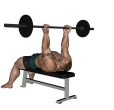 French Press - Flat Reverse Barbell
French Press - Flat Reverse Barbell
Benefits: The exercise eliminates isolates the triceps.
Purpose: This exercise works primarily the triceps.
Beginner Triceps Strength Barbell Flat Bench Push Gym
General Info: The triceps is a straight muscle with three heads. The long head straightens the elbow, adducts the shoulder (brings it from a side position to the body) and extends the shoulder (brings the arm from a front position down to the body). The lateral head (outer head) straightens the elbow. The medial head also straightens the elbow.
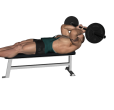 French Press - Lying Barbell Close Grip
French Press - Lying Barbell Close Grip
Benefits: The exercise eliminates isolates the triceps.
Purpose: This exercise works primarily the triceps.
Beginner Triceps Strength Barbell Flat Bench Pull Gym
General Info: The triceps is a straight muscle with three heads. The long head straightens the elbow, adducts the shoulder (brings it from a side position to the body) and extends the shoulder (brings the arm from a front position down to the body). The lateral head (outer head) straightens the elbow. The medial head also straightens the elbow.
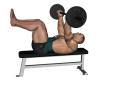 French Press - Lying Barbell Feet Up
French Press - Lying Barbell Feet Up
Benefits: The exercise eliminates isolates the triceps. Keeping the feet up ensures that you do not arch the back.
Purpose: This exercise works primarily the triceps.
Beginner Triceps Strength Barbell Flat Bench Pull Gym
General Info: The triceps is a straight muscle with three heads. The long head straightens the elbow, adducts the shoulder (brings it from a side position to the body) and extends the shoulder (brings the arm from a front position down to the body). The lateral head (outer head) straightens the elbow. The medial head also straightens the elbow.
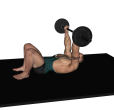 French Press - Lying Barbell Reverse
French Press - Lying Barbell Reverse
Benefits: The exercise eliminates isolates the triceps. The reverse grip makes the exercise more difficult.
Purpose: This exercise works primarily the triceps.
Beginner Triceps Strength Barbell Push Gym
General Info: The triceps is a straight muscle with three heads. The long head straightens the elbow, adducts the shoulder (brings it from a side position to the body) and extends the shoulder (brings the arm from a front position down to the body). The lateral head (outer head) straightens the elbow. The medial head also straightens the elbow.
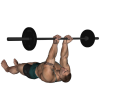 French Press - Lying Barbell Reverse Close
French Press - Lying Barbell Reverse Close
Benefits: The exercise eliminates isolates the triceps. The reverse grip makes the exercise more difficult.
Purpose: This exercise works primarily the triceps.
Beginner Triceps Strength Barbell Push Gym
General Info: The triceps is a straight muscle with three heads. The long head straightens the elbow, adducts the shoulder (brings it from a side position to the body) and extends the shoulder (brings the arm from a front position down to the body). The lateral head (outer head) straightens the elbow. The medial head also straightens the elbow.
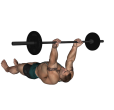 French Press - Lying Barbell Reverse Feet Up
French Press - Lying Barbell Reverse Feet Up
Benefits: The exercise eliminates isolates the triceps.
Purpose: This exercise works primarily the triceps.
Beginner Triceps Strength Barbell Push Gym
General Info: The triceps is a straight muscle with three heads. The long head straightens the elbow, adducts the shoulder (brings it from a side position to the body) and extends the shoulder (brings the arm from a front position down to the body). The lateral head (outer head) straightens the elbow. The medial head also straightens the elbow.
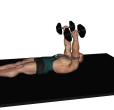 French Press - Lying Dumbbell
French Press - Lying Dumbbell
Benefits: The exercise eliminates isolates the triceps.
Purpose: This exercise works primarily the triceps.
Beginner Triceps Strength Dumbbell Push Gym
General Info: The triceps is a straight muscle with three heads. The long head straightens the elbow, adducts the shoulder (brings it from a side position to the body) and extends the shoulder (brings the arm from a front position down to the body). The lateral head (outer head) straightens the elbow. The medial head also straightens the elbow.
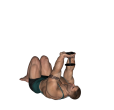 French Press - Lying Dumbbell 2 Handed
French Press - Lying Dumbbell 2 Handed
Benefits: This exercise works all heads of the triceps.
Purpose: This exercise is used to target the triceps muscle to develop size, definition, strength, endurance and power.
Beginner Triceps Strength Dumbbell Push Gym
General Info: The triceps muscle group are straight muscles with three heads. All three heads straighten the elbow while the long head, crossing the shoulder joint also adducts the shoulder (pulls it down from the side) and extends the shoulder (pulls it down from the front).
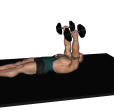 French Press - Lying Dumbbell Alternate
French Press - Lying Dumbbell Alternate
Benefits: The exercise eliminates isolates the triceps.
Purpose: This exercise works primarily the triceps.
Beginner Triceps Strength Dumbbell Push Gym
General Info: The triceps is a straight muscle with three heads. The long head straightens the elbow, adducts the shoulder (brings it from a side position to the body) and extends the shoulder (brings the arm from a front position down to the body). The lateral head (outer head) straightens the elbow. The medial head also straightens the elbow.
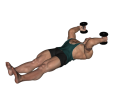 French Press - Lying Dumbbell Feet Up
French Press - Lying Dumbbell Feet Up
Benefits: The exercise eliminates isolates the triceps.
Purpose: This exercise works primarily the triceps.
Beginner Triceps Strength Dumbbell Push Gym
General Info: The triceps is a straight muscle with three heads. The long head straightens the elbow, adducts the shoulder (brings it from a side position to the body) and extends the shoulder (brings the arm from a front position down to the body). The lateral head (outer head) straightens the elbow. The medial head also straightens the elbow.
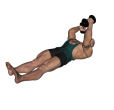 French Press - Lying Dumbbell Feet Up Alternate
French Press - Lying Dumbbell Feet Up Alternate
Benefits: The exercise eliminates isolates the triceps.
Purpose: This exercise works primarily the triceps.
Beginner Triceps Strength Dumbbell Push Gym
General Info: The triceps is a straight muscle with three heads. The long head straightens the elbow, adducts the shoulder (brings it from a side position to the body) and extends the shoulder (brings the arm from a front position down to the body). The lateral head (outer head) straightens the elbow. The medial head also straightens the elbow.
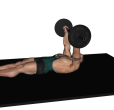 French Press - Lying EZ Bar
French Press - Lying EZ Bar
Benefits: The exercise eliminates isolates the triceps.
Purpose: This exercise works primarily the triceps.
Beginner Triceps Strength EZ Bar Push Gym
General Info: The triceps is a straight muscle with three heads. The long head straightens the elbow, adducts the shoulder (brings it from a side position to the body) and extends the shoulder (brings the arm from a front position down to the body). The lateral head (outer head) straightens the elbow. The medial head also straightens the elbow.
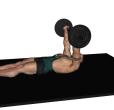 French Press - Lying EZ Bar Reverse
French Press - Lying EZ Bar Reverse
Benefits: The exercise eliminates isolates the triceps.
Purpose: This exercise works primarily the triceps.
Beginner Triceps Strength EZ Bar Push Gym
General Info: The triceps is a straight muscle with three heads. The long head straightens the elbow, adducts the shoulder (brings it from a side position to the body) and extends the shoulder (brings the arm from a front position down to the body). The lateral head (outer head) straightens the elbow. The medial head also straightens the elbow.
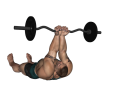 French Press - Lying EZ Bar Reverse Close
French Press - Lying EZ Bar Reverse Close
Benefits: The exercise eliminates isolates the triceps.
Purpose: This exercise works primarily the triceps.
Beginner Triceps Strength EZ Bar Push Gym
General Info: The triceps is a straight muscle with three heads. The long head straightens the elbow, adducts the shoulder (brings it from a side position to the body) and extends the shoulder (brings the arm from a front position down to the body). The lateral head (outer head) straightens the elbow. The medial head also straightens the elbow.
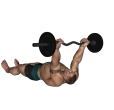 French Press - Lying EZ Bar Reverse Feet Up
French Press - Lying EZ Bar Reverse Feet Up
Benefits: The exercise eliminates isolates the triceps.
Purpose: This exercise works primarily the triceps.
Beginner Triceps Strength EZ Bar Push Gym
General Info: The triceps is a straight muscle with three heads. The long head straightens the elbow, adducts the shoulder (brings it from a side position to the body) and extends the shoulder (brings the arm from a front position down to the body). The lateral head (outer head) straightens the elbow. The medial head also straightens the elbow.
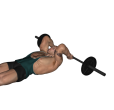 French Press - Lying Floor Barbell
French Press - Lying Floor Barbell
Benefits: The exercise eliminates isolates the triceps.
Purpose: This exercise works primarily the triceps.
Beginner Triceps Strength Barbell Push Gym
General Info: The triceps is a straight muscle with three heads. The long head straightens the elbow, adducts the shoulder (brings it from a side position to the body) and extends the shoulder (brings the arm from a front position down to the body). The lateral head (outer head) straightens the elbow. The medial head also straightens the elbow.
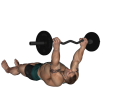 French Press - Lying Floor EZ Bar
French Press - Lying Floor EZ Bar
Benefits: The exercise eliminates isolates the triceps.
Purpose: This exercise works primarily the triceps.
Beginner Triceps Strength EZ Bar Push Gym
General Info: The triceps is a straight muscle with three heads. The long head straightens the elbow, adducts the shoulder (brings it from a side position to the body) and extends the shoulder (brings the arm from a front position down to the body). The lateral head (outer head) straightens the elbow. The medial head also straightens the elbow.
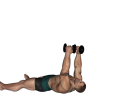 French Press - Lying Floor Single Dumbbell
French Press - Lying Floor Single Dumbbell
Benefits: The exercise eliminates isolates the triceps.
Purpose: This exercise works primarily the triceps.
Beginner Triceps Strength Dumbbell Push Gym
General Info: The triceps is a straight muscle with three heads. The long head straightens the elbow, adducts the shoulder (brings it from a side position to the body) and extends the shoulder (brings the arm from a front position down to the body). The lateral head (outer head) straightens the elbow. The medial head also straightens the elbow.
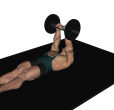 French Press - Lying Tricep Barbell
French Press - Lying Tricep Barbell
Benefits: The exercise eliminates isolates the triceps.
Purpose: This exercise works primarily the triceps.
Beginner Triceps Strength Tricep Barbell Push Gym
General Info: The triceps is a straight muscle with three heads. The long head straightens the elbow, adducts the shoulder (brings it from a side position to the body) and extends the shoulder (brings the arm from a front position down to the body). The lateral head (outer head) straightens the elbow. The medial head also straightens the elbow.
 French Press - Lying Water Bottle
French Press - Lying Water Bottle
Benefits: The exercise eliminates isolates the triceps.
Purpose: This exercise works primarily the triceps.
Beginner Triceps Strength Water Bottle Push Home
General Info: The triceps is a straight muscle with three heads. The long head straightens the elbow, adducts the shoulder (brings it from a side position to the body) and extends the shoulder (brings the arm from a front position down to the body). The lateral head (outer head) straightens the elbow. The medial head also straightens the elbow.
 French Press - Lying Water Bottle 2 Handed
French Press - Lying Water Bottle 2 Handed
Benefits: This exercise works all heads of the triceps.
Purpose: This exercise is used to target the triceps muscle to develop size, definition, strength, endurance and power.
Beginner Triceps Strength Water Bottle Push Home
General Info: The triceps muscle group are straight muscles with three heads. All three heads straighten the elbow while the long head, crossing the shoulder joint also adducts the shoulder (pulls it down from the side) and extends the shoulder (pulls it down from the front).
 French Press - Lying Water Bottle Alternate
French Press - Lying Water Bottle Alternate
Benefits: The exercise eliminates isolates the triceps.
Purpose: This exercise works primarily the triceps.
Beginner Triceps Strength Water Bottle Push Home
General Info: The triceps is a straight muscle with three heads. The long head straightens the elbow, adducts the shoulder (brings it from a side position to the body) and extends the shoulder (brings the arm from a front position down to the body). The lateral head (outer head) straightens the elbow. The medial head also straightens the elbow.
 French Press - Lying Water Bottle Feet Up
French Press - Lying Water Bottle Feet Up
Benefits: The exercise eliminates isolates the triceps.
Purpose: This exercise works primarily the triceps.
Beginner Triceps Strength Water Bottle Push Home
General Info: The triceps is a straight muscle with three heads. The long head straightens the elbow, adducts the shoulder (brings it from a side position to the body) and extends the shoulder (brings the arm from a front position down to the body). The lateral head (outer head) straightens the elbow. The medial head also straightens the elbow.
 French Press - Lying Water Bottle Feet Up Alternate
French Press - Lying Water Bottle Feet Up Alternate
Benefits: The exercise eliminates isolates the triceps.
Purpose: This exercise works primarily the triceps.
Beginner Triceps Strength Water Bottle Push Home
General Info: The triceps is a straight muscle with three heads. The long head straightens the elbow, adducts the shoulder (brings it from a side position to the body) and extends the shoulder (brings the arm from a front position down to the body). The lateral head (outer head) straightens the elbow. The medial head also straightens the elbow.
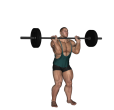 Jerk - Balance
Jerk - Balance
Benefits: The press is a highly effective compound upper-body exercise.
Purpose: The push press is a good exercise for building up and strengthening the shoulder region.
Intermediate Shoulders Triceps Strength Barbell Push Compound Gym
General Info: The Deltoids is a fan-shaped muscle. The Anterior (Front) Deltoid raises the arm toward the front of the body and rotates the arm inward. The Lateral (Side) Deltoid raises the arm to the side. The Posterior (Rear) Deltoid raises the arm toward the rear and rotates the arm outward.
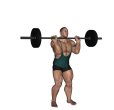 Jerk - Split
Jerk - Split
Benefits: The press is a highly effective compound upper-body exercise.
Purpose: The push press is a good exercise for building up and strengthening the shoulder region.
Intermediate Shoulders Triceps Strength Barbell Push Compound Gym
General Info: The Deltoids is a fan-shaped muscle. The Anterior (Front) Deltoid raises the arm toward the front of the body and rotates the arm inward. The Lateral (Side) Deltoid raises the arm to the side. The Posterior (Rear) Deltoid raises the arm toward the rear and rotates the arm outward.
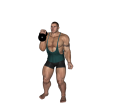 Kettlebell - Arnold Press
Kettlebell - Arnold Press
Benefits: Arnold Press vs a Barbell Press gives a wide range of motion as you lower the dumbbells well down in front giving that maximum stretch other shoulder exercises lack. Essentially it is a combination of two moves which isolate shoulder muscles - shoulder press and a lateral raise.
Purpose: To build muscle mass in the front and side heads of the deltoids. Arnold Shoulder Press is an excellent alternative to Shoulder Dumbbell press and can be used to spice up your workouts. I perform Arnold press and shoulder dumbbell presses on alternate weeks for variety in my workouts.
Intermediate Shoulders Forearms Triceps Strength Kettlebell Push Compound Gym
General Info: When it comes to the best exercise with the best range of motion for Shoulder muscles, Arnold press stands out from the crowd. It was created by bodybuilder Arnold Schwarzenegger and hits both the medial and front heads of deltoids.
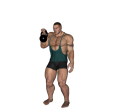 Kettlebell - Bent Press
Kettlebell - Bent Press
Benefits: The press is a highly effective compound upper-body exercise. It also works the oblique muscles.
Purpose: The Barbell Shoulder Press (sometimes called the Military Press) is a good exercise for building up and strengthening the shoulder region.
Shoulders Triceps Strength Kettlebell Push Compound Gym
General Info: The Deltoids is a fan-shaped muscle. The Anterior (Front) Deltoid raises the arm toward the front of the body and rotates the arm inward. The Lateral (Side) Deltoid raises the arm to the side. The Posterior (Rear) Deltoid raises the arm toward the rear and rotates the arm outward.
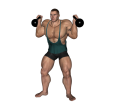 Kettlebell - Double Jerk
Kettlebell - Double Jerk
Benefits: The press is a highly effective compound upper-body exercise.
Purpose: The push press is a good exercise for building up and strengthening the shoulder region.
Shoulders Triceps Strength Kettlebell Push Compound Gym
General Info: The Deltoids is a fan-shaped muscle. The Anterior (Front) Deltoid raises the arm toward the front of the body and rotates the arm inward. The Lateral (Side) Deltoid raises the arm to the side. The Posterior (Rear) Deltoid raises the arm toward the rear and rotates the arm outward.
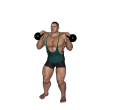 Kettlebell - Double Push Press
Kettlebell - Double Push Press
Benefits: The press is a highly effective compound upper-body exercise.
Purpose: The press is a good exercise for building up and strengthening the shoulder region.
Intermediate Shoulders Triceps Strength Kettlebell Push Compound Gym
General Info: The Deltoids is a fan-shaped muscle. The Anterior (Front) Deltoid raises the arm toward the front of the body and rotates the arm inward. The Lateral (Side) Deltoid raises the arm to the side. The Posterior (Rear) Deltoid raises the arm toward the rear and rotates the arm outward.
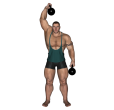 Kettlebell - Double Windmill
Kettlebell - Double Windmill
Benefits: This exercise trains the deep core muscles.
Purpose: This exercise strengthens the abdominal muscles.
Abdominals Hamstrings Shoulders Glutes Triceps Strength Kettlebell Compound Gym
General Info: The abs can be divided into the abdominals themselves and the obliques. The obliques are the outer abs and are used in twisting movements. For the sake of exercising, the abdominals are sometimes divided into upper abs and lower abs (this is not a technical division but something for exercising). Both upper and lower abs are used in straight line ab exercises while the upper abs are also involved in twisting movements.
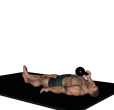 Kettlebell - Leg Over Floor Press
Kettlebell - Leg Over Floor Press
Benefits: Kettlebells do not limit your movement as much as a barbell does and thus makes greater demands on the stabilizing muscles.
Purpose: This exercise increases strength and strength speed, and produces greater functional strength for pressing movements.
Intermediate Chest Triceps Strength Kettlebell Push Compound Gym
General Info: The chest is composed of the Pectoralis Major and the Pectoralis Minor. The Pec Major attaches to the upper arm and pulls the upper arm across the chest. The Pec Minor lies mostly underneath the Pec Major and draws the shoulder blade down and forward.
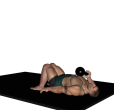 Kettlebell - One Arm Floor Press
Kettlebell - One Arm Floor Press
Benefits: Dumbbells do not limit your movement as much as a barbell does and thus makes greater demands on the stabilizing muscles.
Purpose: This exercise increases strength and strength speed, and produces greater functional strength for pressing movements.
Intermediate Chest Triceps Strength Kettlebell Push Compound Gym
General Info: The chest is composed of the Pectoralis Major and the Pectoralis Minor. The Pec Major attaches to the upper arm and pulls the upper arm across the chest. The Pec Minor lies mostly underneath the Pec Major and draws the shoulder blade down and forward.
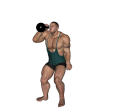 Kettlebell - One Arm Jerk
Kettlebell - One Arm Jerk
Benefits: The press is a highly effective compound upper-body exercise.
Purpose: The push press is a good exercise for building up and strengthening the shoulder region.
Shoulders Triceps Strength Kettlebell Push Compound Gym
General Info: The Deltoids is a fan-shaped muscle. The Anterior (Front) Deltoid raises the arm toward the front of the body and rotates the arm inward. The Lateral (Side) Deltoid raises the arm to the side. The Posterior (Rear) Deltoid raises the arm toward the rear and rotates the arm outward.
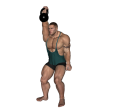 Kettlebell - One Arm Military Press To The Side
Kettlebell - One Arm Military Press To The Side
Benefits: The press is a highly effective compound upper-body exercise.
Purpose: The Military Press is a good exercise for building up and strengthening the shoulder region.
Shoulders Triceps Chest Strength Kettlebell Push Compound Gym
General Info: The Deltoids is a fan-shaped muscle. The Anterior (Front) Deltoid raises the arm toward the front of the body and rotates the arm inward. The Lateral (Side) Deltoid raises the arm to the side. The Posterior (Rear) Deltoid raises the arm toward the rear and rotates the arm outward.
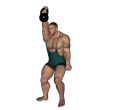 Kettlebell - One Arm Para Press
Kettlebell - One Arm Para Press
Benefits: The press is a highly effective compound upper-body exercise.
Purpose: This exercise is a good exercise for building up and strengthening the shoulder region.
Shoulders Triceps Chest Strength Kettlebell Push Compound Gym
General Info: The Deltoids is a fan-shaped muscle. The Anterior (Front) Deltoid raises the arm toward the front of the body and rotates the arm inward. The Lateral (Side) Deltoid raises the arm to the side. The Posterior (Rear) Deltoid raises the arm toward the rear and rotates the arm outward.
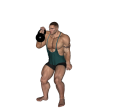 Kettlebell - One Arm Push Press
Kettlebell - One Arm Push Press
Benefits: The press is a highly effective compound upper-body exercise.
Purpose: The push press is a good exercise for building up and strengthening the shoulder region.
Intermediate Shoulders Triceps Chest Strength Kettlebell Push Compound Gym
General Info: The Deltoids is a fan-shaped muscle. The Anterior (Front) Deltoid raises the arm toward the front of the body and rotates the arm inward. The Lateral (Side) Deltoid raises the arm to the side. The Posterior (Rear) Deltoid raises the arm toward the rear and rotates the arm outward.
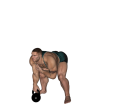 Kettlebell - One Arm Row
Kettlebell - One Arm Row
Benefits: This exercise is a strong, effective free weight back exercise for building muscle mass and size of the lats.
Purpose: This is a good exercise for increasing strength and size in the upper back.
Intermediate Traps Lats Triceps Posterior Delts Strength Kettlebell Pull Compound Gym
General Info: There are a number of muscles in the back, although the two major muscles are the lats and traps. The lats pulls the arm back and down towards the spine. The traps pull the shoulder blades back and towards the spine.
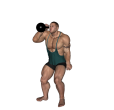 Kettlebell - One Arm Split Jerk
Kettlebell - One Arm Split Jerk
Benefits: The press is a highly effective compound upper-body exercise.
Purpose: The push press is a good exercise for building up and strengthening the shoulder region.
Shoulders Triceps Strength Kettlebell Push Compound Gym
General Info: The Deltoids is a fan-shaped muscle. The Anterior (Front) Deltoid raises the arm toward the front of the body and rotates the arm inward. The Lateral (Side) Deltoid raises the arm to the side. The Posterior (Rear) Deltoid raises the arm toward the rear and rotates the arm outward.
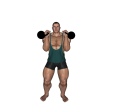 Kettlebell - Press Alternate
Kettlebell - Press Alternate
Benefits: The press is a highly effective compound upper-body exercise.
Purpose: The Barbell Shoulder Press (sometimes called the Military Press) is a good exercise for building up and strengthening the shoulder region.
Beginner Shoulders Triceps Strength Kettlebell Push Compound Gym
General Info: The Deltoids is a fan-shaped muscle. The Anterior (Front) Deltoid raises the arm toward the front of the body and rotates the arm inward. The Lateral (Side) Deltoid raises the arm to the side. The Posterior (Rear) Deltoid raises the arm toward the rear and rotates the arm outward.
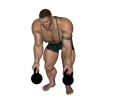 Kettlebell - Row Alternate
Kettlebell - Row Alternate
Benefits: This exercise is a strong, effective free weight back exercise for building muscle mass and size of the lats.
Purpose: This is a good exercise for increasing strength and size in the upper back.
Intermediate Traps Lats Triceps Posterior Delts Strength Kettlebell Pull Compound Gym
General Info: There are a number of muscles in the back, although the two major muscles are the lats and traps. The lats pulls the arm back and down towards the spine. The traps pull the shoulder blades back and towards the spine.
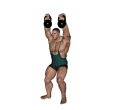 Kettlebell - Seesaw Press
Kettlebell - Seesaw Press
Benefits: The press is a highly effective compound upper-body exercise.
Purpose: The Military Press is a good exercise for building up and strengthening the shoulder region.
Intermediate Shoulders Triceps Chest Strength Kettlebell Push Compound Gym
General Info: The Deltoids is a fan-shaped muscle. The Anterior (Front) Deltoid raises the arm toward the front of the body and rotates the arm inward. The Lateral (Side) Deltoid raises the arm to the side. The Posterior (Rear) Deltoid raises the arm toward the rear and rotates the arm outward.
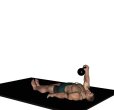 Kettlebell - Turkish Get Up Lunge Style
Kettlebell - Turkish Get Up Lunge Style
Benefits: This exercise is a highly effective compound upper-body exercise. It also works the quads.
Purpose: The exercise is a good exercise for building up and strengthening the shoulder region.
Shoulders Triceps Quads Strength Kettlebell Push Compound Gym
General Info: The Deltoids is a fan-shaped muscle. The Anterior (Front) Deltoid raises the arm toward the front of the body and rotates the arm inward. The Lateral (Side) Deltoid raises the arm to the side. The Posterior (Rear) Deltoid raises the arm toward the rear and rotates the arm outward.
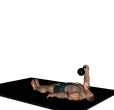 Kettlebell - Turkish Get Up Squat Style
Kettlebell - Turkish Get Up Squat Style
Benefits: This exercise is a highly effective compound upper-body exercise. It also works the quads.
Purpose: The exercise is a good exercise for building up and strengthening the shoulder region.
Shoulders Triceps Quads Strength Kettlebell Push Compound Gym
General Info: The Deltoids is a fan-shaped muscle. The Anterior (Front) Deltoid raises the arm toward the front of the body and rotates the arm inward. The Lateral (Side) Deltoid raises the arm to the side. The Posterior (Rear) Deltoid raises the arm toward the rear and rotates the arm outward.
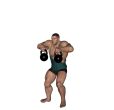 Kettlebell - Two Arm Jerk
Kettlebell - Two Arm Jerk
Benefits: The jerk is a highly effective compound upper-body exercise.
Purpose: The jerk is a good exercise for building up and strengthening the shoulder region.
Shoulders Triceps Strength Kettlebell Push Compound Gym
General Info: The Deltoids is a fan-shaped muscle. The Anterior (Front) Deltoid raises the arm toward the front of the body and rotates the arm inward. The Lateral (Side) Deltoid raises the arm to the side. The Posterior (Rear) Deltoid raises the arm toward the rear and rotates the arm outward.
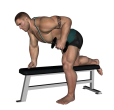 Kickback - Triceps Dumbbell
Kickback - Triceps Dumbbell
Benefits: This exercise works all heads of the triceps.
Purpose: This exercise is used to target the triceps muscle to develop size, definition, strength, endurance and power.
Beginner Triceps Strength Dumbbell Flat Bench Push Gym
General Info: The triceps muscles are straight muscles with three heads. All three heads straighten the elbow while the long head, crossing the shoulder joint also adducts the shoulder (pulls it down from the side) and extends the shoulder (pulls it down from the front).
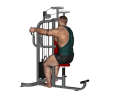 Posterior Raise - Pec Dec Machine
Posterior Raise - Pec Dec Machine
Benefits: This exercise isolates the posterior delt muscle.
Purpose: This exercise strengthens the rear deltoid muscle area.
Intermediate Rear Shoulders Lats Traps Triceps Strength Pec Dec Pull Gym
General Info: The posterior (rear) deltoid or shoulder is one of the three distinct heads of the deltoid anatomy. It is typically used in tandem with the back muscles during upper body pulling exercises.
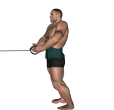 Posterior Raise - Standing With Band
Posterior Raise - Standing With Band
Benefits: This exercise isolates the posterior delt muscle.
Purpose: This exercise strengthens the rear deltoid muscle area.
Intermediate Rear Shoulders Lats Traps Triceps Strength Band Pull Gym
General Info: The posterior (rear) deltoid or shoulder is one of the three distinct heads of the deltoid anatomy. It is typically used in tandem with the back muscles during upper body pulling exercises.
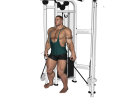 Posterior Raise - Twin Pulley
Posterior Raise - Twin Pulley
Benefits: This exercise isolates the posterior delt muscle.
Purpose: This exercise strengthens the rear deltoid muscle area.
Intermediate Rear Shoulders Lats Traps Triceps Strength High Low Cable Machine Pull Gym
General Info: The posterior (rear) deltoid or shoulder is one of the three distinct heads of the deltoid anatomy. It is typically used in tandem with the back muscles during upper body pulling exercises.
 Press - Floor and Flye Water Bottle
Press - Floor and Flye Water Bottle
Benefits: This exercise works the chest muscles, giving them shape and strength.
Purpose: This exercise increases strength and strength speed, and produces greater functional strength for pressing movements.
Intermediate Chest Triceps Anterior Delts Strength Water Bottle Push Compound Home
General Info: The chest is composed of the Pectoralis Major and the Pectoralis Minor. The Pec Major attaches to the upper arm and pulls the upper arm across the chest. The Pec Minor lies mostly underneath the Pec Major and draws the shoulder blade down and forward.
 Press - Floor Reverse and Flye Bottle
Press - Floor Reverse and Flye Bottle
Benefits: This exercise helps to shape and strengthen the chest muscles.
Purpose: This exercise increases strength and strength speed, and produces greater functional strength for pressing movements.
Intermediate Chest Triceps Anterior Delts Strength Water Bottle Push Compound Home
General Info: The chest is composed of the Pectoralis Major and the Pectoralis Minor. The Pec Major attaches to the upper arm and pulls the upper arm across the chest. The Pec Minor lies mostly underneath the Pec Major and draws the shoulder blade down and forward.
 Press - Floor Water Bottle
Press - Floor Water Bottle
Benefits: Dumbbells do not limit your movement as much as a barbell does and thus makes greater demands on the stabilizing muscles.
Purpose: This exercise increases strength and strength speed, and produces greater functional strength for pressing movements.
Beginner Chest Triceps Strength Water Bottle Push Compound Home
General Info: The chest is composed of the Pectoralis Major and the Pectoralis Minor. The Pec Major attaches to the upper arm and pulls the upper arm across the chest. The Pec Minor lies mostly underneath the Pec Major and draws the shoulder blade down and forward.
 Press - Floor Water Bottle Inwards
Press - Floor Water Bottle Inwards
Benefits: Dumbbells do not limit your movement as much as a barbell does and thus makes greater demands on the stabilizing muscles.
Purpose: This exercise increases strength and strength speed, and produces greater functional strength for pressing movements.
Beginner Chest Triceps Strength Water Bottle Push Compound Home
General Info: The chest is composed of the Pectoralis Major and the Pectoralis Minor. The Pec Major attaches to the upper arm and pulls the upper arm across the chest. The Pec Minor lies mostly underneath the Pec Major and draws the shoulder blade down and forward.
 Press - Floor Water Bottle Reverse
Press - Floor Water Bottle Reverse
Benefits: Dumbbells do not limit your movement as much as a barbell does and thus makes greater demands on the stabilizing muscles.
Purpose: This exercise increases strength and strength speed, and produces greater functional strength for pressing movements.
Beginner Chest Triceps Strength Water Bottle Push Compound Home
General Info: The chest is composed of the Pectoralis Major and the Pectoralis Minor. The Pec Major attaches to the upper arm and pulls the upper arm across the chest. The Pec Minor lies mostly underneath the Pec Major and draws the shoulder blade down and forward.
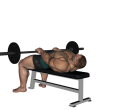 Pull Over - Front Raise
Pull Over - Front Raise
Benefits: A barbell allows someone to lift heavier weights and thus build more strength quicker.
Purpose: This exercise increases strength and strength speed, and produces greater functional strength for pressing movements.
Intermediate Chest Triceps Strength Barbell Flat Bench Pull Compound Gym
General Info: The chest is composed of the Pectoralis Major and the Pectoralis Minor. The Pec Major attaches to the upper arm and pulls the upper arm across the chest. The Pec Minor lies mostly underneath the Pec Major and draws the shoulder blade down and forward.
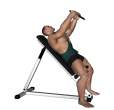 Pull Over - Incline Plate
Pull Over - Incline Plate
Benefits: A barbell allows someone to lift heavier weights and thus build more strength quicker.
Purpose: This exercise increases strength and strength speed, and produces greater functional strength for pressing movements.
Beginner Chest Triceps Strength Plate Incline Bench Pull Compound Gym
General Info: The chest is composed of the Pectoralis Major and the Pectoralis Minor. The Pec Major attaches to the upper arm and pulls the upper arm across the chest. The Pec Minor lies mostly underneath the Pec Major and draws the shoulder blade down and forward.
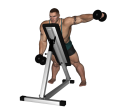 Pull Over - Incline Reverse Dumbbell Alternate
Pull Over - Incline Reverse Dumbbell Alternate
Benefits: A barbell allows someone to lift heavier weights and thus build more strength quicker.
Purpose: This exercise increases strength and strength speed, and produces greater functional strength for pressing movements.
Beginner Chest Triceps Strength Dumbbell Incline Bench Pull Compound Gym
General Info: The chest is composed of the Pectoralis Major and the Pectoralis Minor. The Pec Major attaches to the upper arm and pulls the upper arm across the chest. The Pec Minor lies mostly underneath the Pec Major and draws the shoulder blade down and forward.
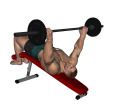 Pull Over - Wide Grip Decline Barbell
Pull Over - Wide Grip Decline Barbell
Benefits: A barbell allows someone to lift heavier weights and thus build more strength quicker.
Purpose: This exercise increases strength and strength speed, and produces greater functional strength for pressing movements.
Intermediate Chest Triceps Strength Barbell Decline Bench Pull Compound Gym
General Info: The chest is composed of the Pectoralis Major and the Pectoralis Minor. The Pec Major attaches to the upper arm and pulls the upper arm across the chest. The Pec Minor lies mostly underneath the Pec Major and draws the shoulder blade down and forward.
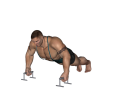 Push Up - Bar
Push Up - Bar
Benefits: Pushups are a basic body weight chest exercise.
Purpose: This exercise increases strength and produces greater functional strength for pressing movements.
Beginner Chest Triceps Strength Barbell Push Compound Gym
General Info: The chest is composed of the Pectoralis Major and the Pectoralis Minor. The Pec Major attaches to the upper arm and pulls the upper arm across the chest. The Pec Minor lies mostly underneath the Pec Major and draws the shoulder blade down and forward.
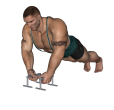 Push Up - Bar Close Grip
Push Up - Bar Close Grip
Benefits: Close grip pushups work the triceps more than the chest.
Purpose: This exercise increases strength and produces greater functional strength for pressing movements.
Beginner Triceps Chest Strength Barbell Push Compound Gym Home
General Info: Typically pushups are considered to be a chest exercise. However, when the hands are placed in a close grip, it works the triceps muscles more. The closer the grip, the more the triceps are worked.
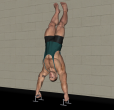 Push Up - Bar Hand Stand
Push Up - Bar Hand Stand
Benefits: Pushups are a basic body weight chest exercise.
Purpose: This exercise increases strength and produces greater functional strength for pressing movements.
Beginner Chest Triceps Strength Barbell Push Compound Gym
General Info: The chest is composed of the Pectoralis Major and the Pectoralis Minor. The Pec Major attaches to the upper arm and pulls the upper arm across the chest. The Pec Minor lies mostly underneath the Pec Major and draws the shoulder blade down and forward.
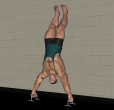 Push Up - Bar Hand Stand Wide Grip
Push Up - Bar Hand Stand Wide Grip
Benefits: Pushups are a basic body weight chest exercise.
Purpose: This exercise increases strength and produces greater functional strength for pressing movements.
Beginner Chest Triceps Strength Barbell Push Compound Gym
General Info: The chest is composed of the Pectoralis Major and the Pectoralis Minor. The Pec Major attaches to the upper arm and pulls the upper arm across the chest. The Pec Minor lies mostly underneath the Pec Major and draws the shoulder blade down and forward.
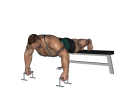 Push Up - Bar Leg Raised
Push Up - Bar Leg Raised
Benefits: Pushups are a basic body weight chest exercise.
Purpose: This exercise increases strength and produces greater functional strength for pressing movements.
Beginner Chest Triceps Strength Barbell Push Compound Gym
General Info: The chest is composed of the Pectoralis Major and the Pectoralis Minor. The Pec Major attaches to the upper arm and pulls the upper arm across the chest. The Pec Minor lies mostly underneath the Pec Major and draws the shoulder blade down and forward.
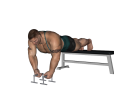 Push Up - Bar Leg Raised Close Grip
Push Up - Bar Leg Raised Close Grip
Benefits: Close grip pushups work the triceps more than the chest.
Purpose: This exercise increases strength and produces greater functional strength for pressing movements.
Beginner Triceps Chest Strength Barbell Push Compound Gym Home
General Info: Typically pushups are considered to be a chest exercise. However, when the hands are placed in a close grip, it works the triceps muscles more. The closer the grip, the more the triceps are worked.
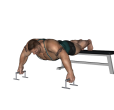 Push Up - Bar Leg Raised Wide Grip
Push Up - Bar Leg Raised Wide Grip
Benefits: Pushups are a basic body weight chest exercise.
Purpose: This exercise increases strength and produces greater functional strength for pressing movements.
Beginner Chest Triceps Strength Barbell Push Compound Gym
General Info: The chest is composed of the Pectoralis Major and the Pectoralis Minor. The Pec Major attaches to the upper arm and pulls the upper arm across the chest. The Pec Minor lies mostly underneath the Pec Major and draws the shoulder blade down and forward.
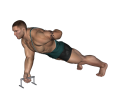 Push Up - Bar One Handed
Push Up - Bar One Handed
Benefits: Pushups are a basic body weight chest exercise.
Purpose: This exercise increases strength and produces greater functional strength for pressing movements.
Intermediate Chest Triceps Strength Barbell Push Compound Gym
General Info: The chest is composed of the Pectoralis Major and the Pectoralis Minor. The Pec Major attaches to the upper arm and pulls the upper arm across the chest. The Pec Minor lies mostly underneath the Pec Major and draws the shoulder blade down and forward.
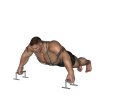 Push Up - Bar Wide Grip
Push Up - Bar Wide Grip
Benefits: Pushups are a basic body weight chest exercise.
Purpose: This exercise increases strength and produces greater functional strength for pressing movements.
Beginner Chest Triceps Strength Barbell Push Compound Gym
General Info: The chest is composed of the Pectoralis Major and the Pectoralis Minor. The Pec Major attaches to the upper arm and pulls the upper arm across the chest. The Pec Minor lies mostly underneath the Pec Major and draws the shoulder blade down and forward.
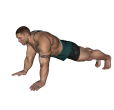 Push Up - Basic
Push Up - Basic
Benefits: Pushups are a basic body weight chest exercise.
Purpose: This exercise increases strength and produces greater functional strength for pressing movements.
Beginner Chest Triceps Strength Body Only Push Compound Gym Home
General Info: The chest is composed of the Pectoralis Major and the Pectoralis Minor. The Pec Major attaches to the upper arm and pulls the upper arm across the chest. The Pec Minor lies mostly underneath the Pec Major and draws the shoulder blade down and forward.
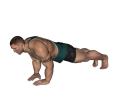 Push Up - Close Hand
Push Up - Close Hand
Benefits: Close grip pushups work the triceps more than the chest.
Purpose: This exercise increases strength and produces greater functional strength for pressing movements.
Beginner Triceps Chest Strength Body Only Push Compound Gym Home
General Info: Typically pushups are considered to be a chest exercise. However, when the hands are placed in a close grip, it works the triceps muscles more. The closer the grip, the more the triceps are worked.
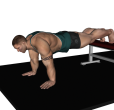 Push Up - Feet Elevated
Push Up - Feet Elevated
Benefits: Pushups are a basic body weight chest exercise. Elevating the feet makes the exercise more difficult.
Purpose: This exercise increases strength and produces greater functional strength for pressing movements.
Intermediate Chest Triceps Strength Flat Bench Push Compound Gym Home
General Info: The chest is composed of the Pectoralis Major and the Pectoralis Minor. The Pec Major attaches to the upper arm and pulls the upper arm across the chest. The Pec Minor lies mostly underneath the Pec Major and draws the shoulder blade down and forward.
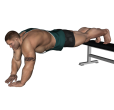 Push Up - Feet Elevated Close Grip
Push Up - Feet Elevated Close Grip
Benefits: Close grip pushups work the triceps more than the chest.
Purpose: This exercise increases strength and produces greater functional strength for pressing movements.
Intermediate Triceps Chest Strength Flat Bench Push Compound Gym Home
General Info: Typically pushups are considered to be a chest exercise. However, when the hands are placed in a close grip, it works the triceps muscles more. The closer the grip, the more the triceps are worked.
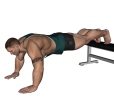 Push Up - Feet Elevated Wide Grip
Push Up - Feet Elevated Wide Grip
Benefits: Pushups are a basic body weight chest exercise.
Purpose: This exercise increases strength and produces greater functional strength for pressing movements.
Intermediate Chest Triceps Strength Flat Bench Push Compound Gym Home
General Info: The chest is composed of the Pectoralis Major and the Pectoralis Minor. The Pec Major attaches to the upper arm and pulls the upper arm across the chest. The Pec Minor lies mostly underneath the Pec Major and draws the shoulder blade down and forward.
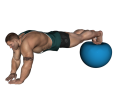 Push Up - Feet On Ball Close Grip
Push Up - Feet On Ball Close Grip
Benefits: Close grip pushups work the triceps more than the chest.
Purpose: This exercise increases strength and produces greater functional strength for pressing movements.
Intermediate Triceps Chest Strength Fitness Ball Push Compound Gym Home
General Info: Typically pushups are considered to be a chest exercise. However, when the hands are placed in a close grip, it works the triceps muscles more. The closer the grip, the more the triceps are worked.
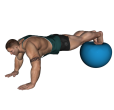 Push Up - Feet On Ball Wide Grip
Push Up - Feet On Ball Wide Grip
Benefits: Pushups are a basic body weight chest exercise.
Purpose: This exercise increases strength and produces greater functional strength for pressing movements.
Intermediate Chest Triceps Strength Fitness Ball Push Compound Gym
General Info: The chest is composed of the Pectoralis Major and the Pectoralis Minor. The Pec Major attaches to the upper arm and pulls the upper arm across the chest. The Pec Minor lies mostly underneath the Pec Major and draws the shoulder blade down and forward.
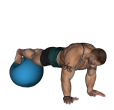 Push Up - Feet On Fitness Ball
Push Up - Feet On Fitness Ball
Benefits: Pushups are a basic body weight chest exercise. Elevating the feet makes the exercise more difficult.
Purpose: This exercise increases strength and produces greater functional strength for pressing movements.
Intermediate Chest Triceps Strength Fitness Ball Push Compound Gym
General Info: The chest is composed of the Pectoralis Major and the Pectoralis Minor. The Pec Major attaches to the upper arm and pulls the upper arm across the chest. The Pec Minor lies mostly underneath the Pec Major and draws the shoulder blade down and forward.
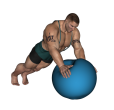 Push Up - Fitness Ball
Push Up - Fitness Ball
Benefits: Pushups are a basic body weight chest exercise.
Purpose: This exercise increases strength and produces greater functional strength for pressing movements.
Beginner Chest Triceps Strength Fitness Ball Push Compound Gym Home
General Info: The chest is composed of the Pectoralis Major and the Pectoralis Minor. The Pec Major attaches to the upper arm and pulls the upper arm across the chest. The Pec Minor lies mostly underneath the Pec Major and draws the shoulder blade down and forward.
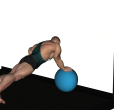 Push Up - Fitness Ball One Handed
Push Up - Fitness Ball One Handed
Benefits: Pushups are a basic body weight chest exercise.
Purpose: This exercise increases strength and produces greater functional strength for pressing movements.
Intermediate Chest Triceps Strength Fitness Ball Push Compound Gym
General Info: The chest is composed of the Pectoralis Major and the Pectoralis Minor. The Pec Major attaches to the upper arm and pulls the upper arm across the chest. The Pec Minor lies mostly underneath the Pec Major and draws the shoulder blade down and forward.
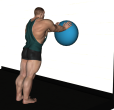 Push Up - Fitness Ball Wall
Push Up - Fitness Ball Wall
Benefits: Pushups are a basic body weight chest exercise.
Purpose: This exercise increases strength and produces greater functional strength for pressing movements.
Beginner Chest Triceps Strength Fitness Ball Push Compound Gym Home
General Info: The chest is composed of the Pectoralis Major and the Pectoralis Minor. The Pec Major attaches to the upper arm and pulls the upper arm across the chest. The Pec Minor lies mostly underneath the Pec Major and draws the shoulder blade down and forward.
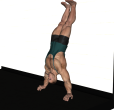 Push Up - Hand Stand
Push Up - Hand Stand
Benefits: Pushups are a basic body weight chest exercise. This is probably the most difficult of all pushup exercises.
Purpose: This exercise increases strength and produces greater functional strength for pressing movements.
Beginner Chest Triceps Strength Body Only Push Compound Gym
General Info: The chest is composed of the Pectoralis Major and the Pectoralis Minor. The Pec Major attaches to the upper arm and pulls the upper arm across the chest. The Pec Minor lies mostly underneath the Pec Major and draws the shoulder blade down and forward.
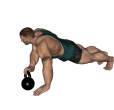 Push Up - Kettlebell Plyo
Push Up - Kettlebell Plyo
Benefits: Pushups are a basic body weight chest exercise. The difficulty in this exercise is to switch hands between repetitions.
Purpose: This exercise increases strength and produces greater functional strength for pressing movements.
Chest Triceps Kettlebell Push Compound Gym
General Info: The chest is composed of the Pectoralis Major and the Pectoralis Minor. The Pec Major attaches to the upper arm and pulls the upper arm across the chest. The Pec Minor lies mostly underneath the Pec Major and draws the shoulder blade down and forward.
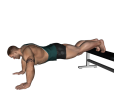 Push Up - Leg Raised Clap
Push Up - Leg Raised Clap
Benefits: Pushups are a basic body weight chest exercise.
Purpose: This exercise increases strength and produces greater functional strength for pressing movements.
Intermediate Chest Triceps Strength Body Only Push Compound Gym
General Info: The chest is composed of the Pectoralis Major and the Pectoralis Minor. The Pec Major attaches to the upper arm and pulls the upper arm across the chest. The Pec Minor lies mostly underneath the Pec Major and draws the shoulder blade down and forward.
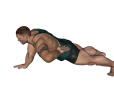 Push Up - One Hand
Push Up - One Hand
Benefits: Pushups are a basic body weight chest exercise.
Purpose: This exercise increases strength and produces greater functional strength for pressing movements.
Intermediate Chest Triceps Strength Body Only Push Compound Gym
General Info: The chest is composed of the Pectoralis Major and the Pectoralis Minor. The Pec Major attaches to the upper arm and pulls the upper arm across the chest. The Pec Minor lies mostly underneath the Pec Major and draws the shoulder blade down and forward.
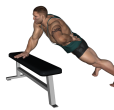 Push Up - One Handed Bench
Push Up - One Handed Bench
Benefits: Pushups are a basic body weight chest exercise.
Purpose: This exercise increases strength and produces greater functional strength for pressing movements.
Intermediate Chest Triceps Strength Flat Bench Push Compound Gym
General Info: The chest is composed of the Pectoralis Major and the Pectoralis Minor. The Pec Major attaches to the upper arm and pulls the upper arm across the chest. The Pec Minor lies mostly underneath the Pec Major and draws the shoulder blade down and forward.
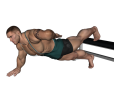 Push Up - One Handed Foot Elevated
Push Up - One Handed Foot Elevated
Benefits: Pushups are a basic body weight chest exercise.
Purpose: This exercise increases strength and produces greater functional strength for pressing movements.
Chest Triceps Strength Flat Bench Push Compound Gym Home
General Info: The chest is composed of the Pectoralis Major and the Pectoralis Minor. The Pec Major attaches to the upper arm and pulls the upper arm across the chest. The Pec Minor lies mostly underneath the Pec Major and draws the shoulder blade down and forward.
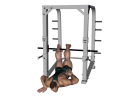 Push Up - Smith High Bar Reverse One Handed
Push Up - Smith High Bar Reverse One Handed
Benefits: Pushups are a basic body weight chest exercise.
Purpose: This exercise increases strength and produces greater functional strength for pressing movements.
Chest Triceps Strength Smith Machine Push Compound Gym Home
General Info: The chest is composed of the Pectoralis Major and the Pectoralis Minor. The Pec Major attaches to the upper arm and pulls the upper arm across the chest. The Pec Minor lies mostly underneath the Pec Major and draws the shoulder blade down and forward.
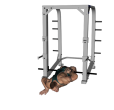 Push Up - Smith Low Bar Reverse One Handed
Push Up - Smith Low Bar Reverse One Handed
Benefits: Pushups are a basic body weight chest exercise.
Purpose: This exercise increases strength and produces greater functional strength for pressing movements.
Chest Triceps Strength Smith Machine Push Compound Gym Home
General Info: The chest is composed of the Pectoralis Major and the Pectoralis Minor. The Pec Major attaches to the upper arm and pulls the upper arm across the chest. The Pec Minor lies mostly underneath the Pec Major and draws the shoulder blade down and forward.
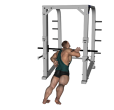 Push Up - Smith Machine High Bar One Handed
Push Up - Smith Machine High Bar One Handed
Benefits: Pushups are a basic body weight chest exercise.
Purpose: This exercise increases strength and produces greater functional strength for pressing movements.
Intermediate Chest Triceps Strength Smith Machine Push Compound Gym
General Info: The chest is composed of the Pectoralis Major and the Pectoralis Minor. The Pec Major attaches to the upper arm and pulls the upper arm across the chest. The Pec Minor lies mostly underneath the Pec Major and draws the shoulder blade down and forward.
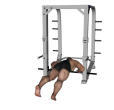 Push Up - Smith Machine Low Bar One Handed
Push Up - Smith Machine Low Bar One Handed
Benefits: Pushups are a basic body weight chest exercise.
Purpose: This exercise increases strength and produces greater functional strength for pressing movements.
Intermediate Chest Triceps Strength Smith Machine Push Compound Gym
General Info: The chest is composed of the Pectoralis Major and the Pectoralis Minor. The Pec Major attaches to the upper arm and pulls the upper arm across the chest. The Pec Minor lies mostly underneath the Pec Major and draws the shoulder blade down and forward.
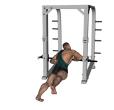 Push Up - Smith Machine Mid Bar One Handed
Push Up - Smith Machine Mid Bar One Handed
Benefits: Pushups are a basic body weight chest exercise.
Purpose: This exercise increases strength and produces greater functional strength for pressing movements.
Intermediate Chest Triceps Strength Smith Machine Push Compound Gym
General Info: The chest is composed of the Pectoralis Major and the Pectoralis Minor. The Pec Major attaches to the upper arm and pulls the upper arm across the chest. The Pec Minor lies mostly underneath the Pec Major and draws the shoulder blade down and forward.
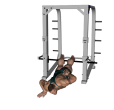 Push Up - Smith Mid Bar Reverse One Handed
Push Up - Smith Mid Bar Reverse One Handed
Benefits: Pushups are a basic body weight chest exercise.
Purpose: This exercise increases strength and produces greater functional strength for pressing movements.
Chest Triceps Strength Smith Machine Push Compound Gym Home
General Info: The chest is composed of the Pectoralis Major and the Pectoralis Minor. The Pec Major attaches to the upper arm and pulls the upper arm across the chest. The Pec Minor lies mostly underneath the Pec Major and draws the shoulder blade down and forward.
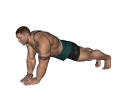 Push Up - Triceps
Push Up - Triceps
Benefits: Close grip pushups work the triceps more than the chest.
Purpose: This exercise increases strength and produces greater functional strength for pressing movements.
Beginner Triceps Chest Strength Body Only Push Compound Gym Home
General Info: Typically pushups are considered to be a chest exercise. However, when the hands are placed in a close grip, it works the triceps muscles more. The closer the grip, the more the triceps are worked.
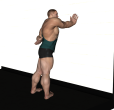 Push Up - Wall
Push Up - Wall
Benefits: Pushups are a basic body weight chest exercise.
Purpose: This exercise increases strength and produces greater functional strength for pressing movements.
Beginner Chest Triceps Strength Body Only Push Compound Gym Home
General Info: The chest is composed of the Pectoralis Major and the Pectoralis Minor. The Pec Major attaches to the upper arm and pulls the upper arm across the chest. The Pec Minor lies mostly underneath the Pec Major and draws the shoulder blade down and forward.
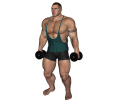 Raise - Dumbbell
Raise - Dumbbell
Benefits: Exercising the traps will provide a thicker, larger and more powerful back development which will help in other exercises and minimize injuries.
Purpose: This exercise develops the trapezoid muscles (upper back and shoulders).
Beginner Lateral Delts Triceps Strength Dumbbell Pull Gym
General Info: The trapezius is a large muscle group which is located in your upper body just below the neck and between your deltoid (shoulder) muscles. A prime means of working the traps directly is to use a shrug exercise.
 Raise - Water Bottle
Raise - Water Bottle
Benefits: Exercising the traps will provide a thicker, larger and more powerful back development which will help in other exercises and minimize injuries.
Purpose: This exercise develops the trapezoid muscles (upper back and shoulders).
Beginner Lateral Delts Triceps Strength Water Bottle Pull Home
General Info: The trapezius is a large muscle group which is located in your upper body just below the neck and between your deltoid (shoulder) muscles. A prime means of working the traps directly is to use a shrug exercise.
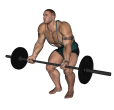 Reverse Row - Barbell
Reverse Row - Barbell
Benefits: This exercise is a strong, effective free weight back exercise for building muscle mass and size of the lats.
Purpose: This is a good exercise for increasing strength and size in the upper back.
Intermediate Traps Lats Triceps Posterior Delts Strength Barbell Pull Compound Gym
General Info: There are a number of muscles in the back, although the two major muscles are the lats and traps. The lats pulls the arm back and down towards the spine. The traps pull the shoulder blades back and towards the spine.
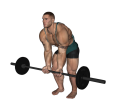 Reverse Row - Barbell Close Grip
Reverse Row - Barbell Close Grip
Benefits: This exercise is a strong, effective free weight back exercise for building muscle mass and size of the lats.
Purpose: This is a good exercise for increasing strength and size in the upper back.
Intermediate Traps Lats Triceps Posterior Delts Strength Barbell Pull Compound Gym
General Info: There are a number of muscles in the back, although the two major muscles are the lats and traps. The lats pulls the arm back and down towards the spine. The traps pull the shoulder blades back and towards the spine.
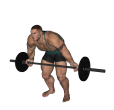 Reverse Row - Barbell Wide Grip
Reverse Row - Barbell Wide Grip
Benefits: This exercise is a strong, effective free weight back exercise for building muscle mass and size of the lats.
Purpose: This is a good exercise for increasing strength and size in the upper back.
Intermediate Traps Lats Triceps Posterior Delts Strength Barbell Pull Compound Gym
General Info: There are a number of muscles in the back, although the two major muscles are the lats and traps. The lats pulls the arm back and down towards the spine. The traps pull the shoulder blades back and towards the spine.
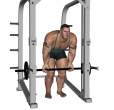 Reverse Row - Bent Knee Smith Machine
Reverse Row - Bent Knee Smith Machine
Benefits: This exercise is a strong, effective free weight back exercise for building muscle mass and size of the lats.
Purpose: This is a good exercise for increasing strength and size in the upper back.
Intermediate Traps Lats Triceps Posterior Delts Strength Smith Machine Pull Compound Gym
General Info: There are a number of muscles in the back, although the two major muscles are the lats and traps. The lats pulls the arm back and down towards the spine. The traps pull the shoulder blades back and towards the spine.
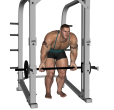 Reverse Row - Bent Knee Smith Wide
Reverse Row - Bent Knee Smith Wide
Benefits: This exercise is a strong, effective free weight back exercise for building muscle mass and size of the lats.
Purpose: This is a good exercise for increasing strength and size in the upper back.
Intermediate Traps Lats Triceps Posterior Delts Strength Smith Machine Pull Compound Gym
General Info: There are a number of muscles in the back, although the two major muscles are the lats and traps. The lats pulls the arm back and down towards the spine. The traps pull the shoulder blades back and towards the spine.
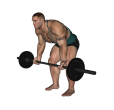 Reverse Row - Bent Over
Reverse Row - Bent Over
Benefits: This exercise is a strong, effective free weight back exercise for building muscle mass and size of the lats.
Purpose: This is a good exercise for increasing strength and size in the middle back.
Intermediate Traps Lats Triceps Posterior Delts Strength Barbell Pull Compound Gym
General Info: There are a number of muscles in the back, although the two major muscles are the lats and traps. The lats pulls the arm back and down towards the spine. The traps pull the shoulder blades back and towards the spine.
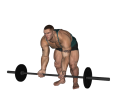 Reverse Row - Bent Over Barbell
Reverse Row - Bent Over Barbell
Benefits: This exercise is a strong, effective free weight back exercise for building muscle mass and size of the lats.
Purpose: This is a good exercise for increasing strength and size in the upper back.
Intermediate Traps Lats Triceps Posterior Delts Strength Barbell Pull Compound Gym
General Info: There are a number of muscles in the back, although the two major muscles are the lats and traps. The lats pulls the arm back and down towards the spine. The traps pull the shoulder blades back and towards the spine.
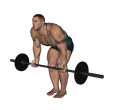 Reverse Row - Bent Over Barbell Narrow Stance
Reverse Row - Bent Over Barbell Narrow Stance
Benefits: This exercise is a strong, effective free weight back exercise for building muscle mass and size of the lats.
Purpose: This is a good exercise for increasing strength and size in the upper back.
Intermediate Traps Lats Triceps Posterior Delts Strength Barbell Pull Compound Gym
General Info: There are a number of muscles in the back, although the two major muscles are the lats and traps. The lats pulls the arm back and down towards the spine. The traps pull the shoulder blades back and towards the spine.
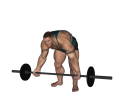 Reverse Row - Bent Over Barbell Wide
Reverse Row - Bent Over Barbell Wide
Benefits: This exercise is a strong, effective free weight back exercise for building muscle mass and size of the lats.
Purpose: This is a good exercise for increasing strength and size in the upper back.
Intermediate Traps Lats Triceps Posterior Delts Strength Barbell Pull Compound Gym
General Info: There are a number of muscles in the back, although the two major muscles are the lats and traps. The lats pulls the arm back and down towards the spine. The traps pull the shoulder blades back and towards the spine.
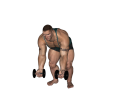 Reverse Row - Bent Over Dumbbell
Reverse Row - Bent Over Dumbbell
Benefits: This exercise is a strong, effective free weight back exercise for building muscle mass and size of the lats.
Purpose: This is a good exercise for increasing strength and size in the upper back.
Intermediate Traps Lats Triceps Posterior Delts Strength Dumbbell Pull Compound Gym
General Info: There are a number of muscles in the back, although the two major muscles are the lats and traps. The lats pulls the arm back and down towards the spine. The traps pull the shoulder blades back and towards the spine.
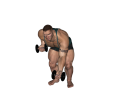 Reverse Row - Bent Over Dumbbell Alternate
Reverse Row - Bent Over Dumbbell Alternate
Benefits: This exercise is a strong, effective free weight back exercise for building muscle mass and size of the lats.
Purpose: This is a good exercise for increasing strength and size in the upper back.
Intermediate Traps Lats Triceps Posterior Delts Strength Dumbbell Pull Compound Gym
General Info: There are a number of muscles in the back, although the two major muscles are the lats and traps. The lats pulls the arm back and down towards the spine. The traps pull the shoulder blades back and towards the spine.
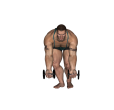 Reverse Row - Bent Over Dumbbell Narrow Stance
Reverse Row - Bent Over Dumbbell Narrow Stance
Benefits: This exercise is a strong, effective free weight back exercise for building muscle mass and size of the lats.
Purpose: This is a good exercise for increasing strength and size in the upper back.
Intermediate Traps Lats Triceps Posterior Delts Strength Dumbbell Pull Compound Gym
General Info: There are a number of muscles in the back, although the two major muscles are the lats and traps. The lats pulls the arm back and down towards the spine. The traps pull the shoulder blades back and towards the spine.
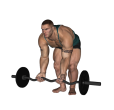 Reverse Row - Bent Over EZ Bar Narrow Stance
Reverse Row - Bent Over EZ Bar Narrow Stance
Benefits: This exercise is a strong, effective free weight back exercise for building muscle mass and size of the lats.
Purpose: This is a good exercise for increasing strength and size in the upper back.
Intermediate Traps Lats Triceps Posterior Delts Strength EZ Bar Pull Compound Gym
General Info: There are a number of muscles in the back, although the two major muscles are the lats and traps. The lats pulls the arm back and down towards the spine. The traps pull the shoulder blades back and towards the spine.
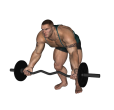 Reverse Row - Bent Over EZ Bar Wide Grip
Reverse Row - Bent Over EZ Bar Wide Grip
Benefits: This exercise is a strong, effective free weight back exercise for building muscle mass and size of the lats.
Purpose: This is a good exercise for increasing strength and size in the upper back.
Intermediate Traps Lats Triceps Posterior Delts Strength EZ Bar Pull Compound Gym
General Info: There are a number of muscles in the back, although the two major muscles are the lats and traps. The lats pulls the arm back and down towards the spine. The traps pull the shoulder blades back and towards the spine.
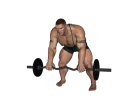 Reverse Row - Bent Over EZ Bar Wide Stance
Reverse Row - Bent Over EZ Bar Wide Stance
Benefits: This exercise is a strong, effective free weight back exercise for building muscle mass and size of the lats.
Purpose: This is a good exercise for increasing strength and size in the upper back.
Intermediate Traps Lats Triceps Posterior Delts Strength EZ Bar Pull Compound Gym
General Info: There are a number of muscles in the back, although the two major muscles are the lats and traps. The lats pulls the arm back and down towards the spine. The traps pull the shoulder blades back and towards the spine.
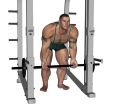 Reverse Row - Bent Over Smith Machine
Reverse Row - Bent Over Smith Machine
Benefits: This exercise is a strong, effective free weight back exercise for building muscle mass and size of the lats.
Purpose: This is a good exercise for increasing strength and size in the upper back.
Intermediate Traps Lats Triceps Posterior Delts Strength Smith Machine Pull Compound Gym
General Info: There are a number of muscles in the back, although the two major muscles are the lats and traps. The lats pulls the arm back and down towards the spine. The traps pull the shoulder blades back and towards the spine.
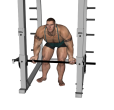 Reverse Row - Bent Over Smith Wide
Reverse Row - Bent Over Smith Wide
Benefits: This exercise is a strong, effective free weight back exercise for building muscle mass and size of the lats.
Purpose: This is a good exercise for increasing strength and size in the upper back.
Intermediate Traps Lats Triceps Posterior Delts Strength Smith Machine Pull Compound Gym
General Info: There are a number of muscles in the back, although the two major muscles are the lats and traps. The lats pulls the arm back and down towards the spine. The traps pull the shoulder blades back and towards the spine.
 Reverse Row - Bent Over Water Bottle
Reverse Row - Bent Over Water Bottle
Benefits: This exercise is a strong, effective free weight back exercise for building muscle mass and size of the lats.
Purpose: This is a good exercise for increasing strength and size in the upper back.
Intermediate Traps Lats Triceps Posterior Delts Strength Water Bottle Pull Compound Home
General Info: There are a number of muscles in the back, although the two major muscles are the lats and traps. The lats pulls the arm back and down towards the spine. The traps pull the shoulder blades back and towards the spine.
 Reverse Row - Bent Over Water Bottle Alternate
Reverse Row - Bent Over Water Bottle Alternate
Benefits: This exercise is a strong, effective free weight back exercise for building muscle mass and size of the lats.
Purpose: This is a good exercise for increasing strength and size in the upper back.
Intermediate Traps Lats Triceps Posterior Delts Strength Water Bottle Pull Compound Home
General Info: There are a number of muscles in the back, although the two major muscles are the lats and traps. The lats pulls the arm back and down towards the spine. The traps pull the shoulder blades back and towards the spine.
 Reverse Row - Bent Over Water Bottle Narrow
Reverse Row - Bent Over Water Bottle Narrow
Benefits: This exercise is a strong, effective free weight back exercise for building muscle mass and size of the lats.
Purpose: This is a good exercise for increasing strength and size in the upper back.
Intermediate Traps Lats Triceps Posterior Delts Strength Water Bottle Pull Compound Home
General Info: There are a number of muscles in the back, although the two major muscles are the lats and traps. The lats pulls the arm back and down towards the spine. The traps pull the shoulder blades back and towards the spine.
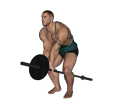 Reverse Row - Close Grip
Reverse Row - Close Grip
Benefits: This exercise is a strong, effective free weight back exercise for building muscle mass and size of the lats.
Purpose: This is a good exercise for increasing strength and size in the upper back.
Intermediate Traps Lats Triceps Posterior Delts Strength Barbell Pull Compound Gym
General Info: There are a number of muscles in the back, although the two major muscles are the lats and traps. The lats pulls the arm back and down towards the spine. The traps pull the shoulder blades back and towards the spine.
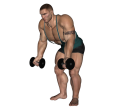 Reverse Row - Dumbbell
Reverse Row - Dumbbell
Benefits: This exercise is a strong, effective free weight back exercise for building muscle mass and size of the lats.
Purpose: This is a good exercise for increasing strength and size in the upper back.
Intermediate Traps Lats Triceps Posterior Delts Strength Dumbbell Pull Compound Gym
General Info: There are a number of muscles in the back, although the two major muscles are the lats and traps. The lats pulls the arm back and down towards the spine. The traps pull the shoulder blades back and towards the spine.
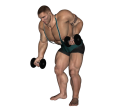 Reverse Row - Dumbbell Alternate
Reverse Row - Dumbbell Alternate
Benefits: This exercise is a strong, effective free weight back exercise for building muscle mass and size of the lats.
Purpose: This is a good exercise for increasing strength and size in the upper back.
Intermediate Traps Lats Triceps Posterior Delts Strength Dumbbell Pull Compound Gym
General Info: There are a number of muscles in the back, although the two major muscles are the lats and traps. The lats pulls the arm back and down towards the spine. The traps pull the shoulder blades back and towards the spine.
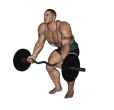 Reverse Row - EZ Bar
Reverse Row - EZ Bar
Benefits: This exercise is a strong, effective free weight back exercise for building muscle mass and size of the lats.
Purpose: This is a good exercise for increasing strength and size in the upper back.
Intermediate Traps Lats Triceps Posterior Delts Strength EZ Bar Pull Compound Gym
General Info: There are a number of muscles in the back, although the two major muscles are the lats and traps. The lats pulls the arm back and down towards the spine. The traps pull the shoulder blades back and towards the spine.
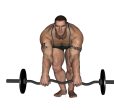 Reverse Row - EZ Bar Narrow Stance
Reverse Row - EZ Bar Narrow Stance
Benefits: This exercise is a strong, effective free weight back exercise for building muscle mass and size of the lats.
Purpose: This is a good exercise for increasing strength and size in the upper back.
Intermediate Traps Lats Triceps Posterior Delts Strength EZ Bar Pull Compound Gym
General Info: There are a number of muscles in the back, although the two major muscles are the lats and traps. The lats pulls the arm back and down towards the spine. The traps pull the shoulder blades back and towards the spine.
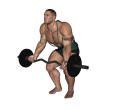 Reverse Row - EZ Bar Wide Grip
Reverse Row - EZ Bar Wide Grip
Benefits: This exercise is a strong, effective free weight back exercise for building muscle mass and size of the lats.
Purpose: This is a good exercise for increasing strength and size in the upper back.
Intermediate Traps Lats Triceps Posterior Delts Strength EZ Bar Pull Compound Gym
General Info: There are a number of muscles in the back, although the two major muscles are the lats and traps. The lats pulls the arm back and down towards the spine. The traps pull the shoulder blades back and towards the spine.
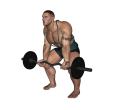 Reverse Row - EZ Bar Wide Stance
Reverse Row - EZ Bar Wide Stance
Benefits: This exercise is a strong, effective free weight back exercise for building muscle mass and size of the lats.
Purpose: This is a good exercise for increasing strength and size in the upper back.
Intermediate Traps Lats Triceps Posterior Delts Strength EZ Bar Pull Compound Gym
General Info: There are a number of muscles in the back, although the two major muscles are the lats and traps. The lats pulls the arm back and down towards the spine. The traps pull the shoulder blades back and towards the spine.
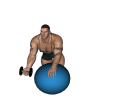 Reverse Row - Fitness Ball Dumbbell
Reverse Row - Fitness Ball Dumbbell
Benefits: This exercise is a strong, effective free weight back exercise for building muscle mass and size of the lats.
Purpose: This is a good exercise for increasing strength and size in the upper back.
Intermediate Traps Lats Triceps Posterior Delts Strength Dumbbell Fitness Ball Pull Compound Gym
General Info: There are a number of muscles in the back, although the two major muscles are the lats and traps. The lats pulls the arm back and down towards the spine. The traps pull the shoulder blades back and towards the spine.
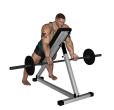 Reverse Row - Incline Barbell
Reverse Row - Incline Barbell
Benefits: This exercise is a strong, effective free weight back exercise for building muscle mass and size of the lats.
Purpose: This is a good exercise for increasing strength and size in the upper back.
Intermediate Traps Lats Triceps Posterior Delts Strength Barbell Incline Bench Pull Compound Gym
General Info: There are a number of muscles in the back, although the two major muscles are the lats and traps. The lats pulls the arm back and down towards the spine. The traps pull the shoulder blades back and towards the spine.
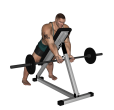 Reverse Row - Incline Barbell Close Grip
Reverse Row - Incline Barbell Close Grip
Benefits: This exercise is a strong, effective free weight back exercise for building muscle mass and size of the lats.
Purpose: This is a good exercise for increasing strength and size in the upper back.
Intermediate Traps Lats Triceps Posterior Delts Strength Barbell Incline Bench Pull Compound Gym
General Info: There are a number of muscles in the back, although the two major muscles are the lats and traps. The lats pulls the arm back and down towards the spine. The traps pull the shoulder blades back and towards the spine.
 Reverse Row - Incline Barbell Wide
Reverse Row - Incline Barbell Wide
Benefits: This exercise is a strong, effective free weight back exercise for building muscle mass and size of the lats.
Purpose: This is a good exercise for increasing strength and size in the upper back.
Intermediate Traps Lats Triceps Posterior Delts Strength Barbell Incline Bench Pull Compound Gym
General Info: There are a number of muscles in the back, although the two major muscles are the lats and traps. The lats pulls the arm back and down towards the spine. The traps pull the shoulder blades back and towards the spine.
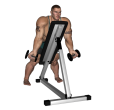 Reverse Row - Incline Dumbbell
Reverse Row - Incline Dumbbell
Benefits: This exercise is a strong, effective free weight back exercise for building muscle mass and size of the lats.
Purpose: This is a good exercise for increasing strength and size in the upper back.
Intermediate Traps Lats Triceps Posterior Delts Strength Dumbbell Incline Bench Pull Compound Gym
General Info: There are a number of muscles in the back, although the two major muscles are the lats and traps. The lats pulls the arm back and down towards the spine. The traps pull the shoulder blades back and towards the spine.
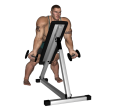 Reverse Row - Incline Dumbbell Alternate
Reverse Row - Incline Dumbbell Alternate
Benefits: This exercise is a strong, effective free weight back exercise for building muscle mass and size of the lats.
Purpose: This is a good exercise for increasing strength and size in the upper back.
Intermediate Traps Lats Triceps Posterior Delts Strength Dumbbell Incline Bench Pull Compound Gym
General Info: There are a number of muscles in the back, although the two major muscles are the lats and traps. The lats pulls the arm back and down towards the spine. The traps pull the shoulder blades back and towards the spine.
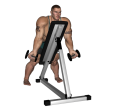 Reverse Row - Incline Dumbbell Alternate Variation
Reverse Row - Incline Dumbbell Alternate Variation
Benefits: This exercise is a strong, effective free weight back exercise for building muscle mass and size of the lats.
Purpose: This is a good exercise for increasing strength and size in the upper back.
Intermediate Traps Lats Triceps Posterior Delts Strength Dumbbell Incline Bench Pull Compound Gym
General Info: There are a number of muscles in the back, although the two major muscles are the lats and traps. The lats pulls the arm back and down towards the spine. The traps pull the shoulder blades back and towards the spine.
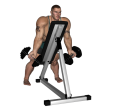 Reverse Row - Incline Dumbbell Single
Reverse Row - Incline Dumbbell Single
Benefits: This exercise is a strong, effective free weight back exercise for building muscle mass and size of the lats.
Purpose: This is a good exercise for increasing strength and size in the upper back.
Intermediate Traps Lats Triceps Posterior Delts Strength Dumbbell Incline Bench Pull Compound Gym
General Info: There are a number of muscles in the back, although the two major muscles are the lats and traps. The lats pulls the arm back and down towards the spine. The traps pull the shoulder blades back and towards the spine.
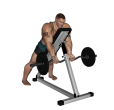 Reverse Row - Incline EZ Bar
Reverse Row - Incline EZ Bar
Benefits: This exercise is a strong, effective free weight back exercise for building muscle mass and size of the lats.
Purpose: This is a good exercise for increasing strength and size in the upper back.
Intermediate Traps Lats Triceps Posterior Delts Strength EZ Bar Incline Bench Pull Compound Gym
General Info: There are a number of muscles in the back, although the two major muscles are the lats and traps. The lats pulls the arm back and down towards the spine. The traps pull the shoulder blades back and towards the spine.
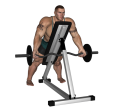 Reverse Row - Incline EZ Bar Wide Grip
Reverse Row - Incline EZ Bar Wide Grip
Benefits: This exercise is a strong, effective free weight back exercise for building muscle mass and size of the lats.
Purpose: This is a good exercise for increasing strength and size in the upper back.
Intermediate Traps Lats Triceps Posterior Delts Strength EZ Bar Incline Bench Pull Compound Gym
General Info: There are a number of muscles in the back, although the two major muscles are the lats and traps. The lats pulls the arm back and down towards the spine. The traps pull the shoulder blades back and towards the spine.
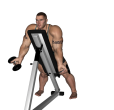 Reverse Row - Overhang Dumbbell
Reverse Row - Overhang Dumbbell
Benefits: This exercise is a strong, effective free weight back exercise for building muscle mass and size of the lats.
Purpose: This is a good exercise for increasing strength and size in the upper back.
Intermediate Traps Lats Triceps Posterior Delts Strength Dumbbell Incline Bench Pull Compound Gym
General Info: There are a number of muscles in the back, although the two major muscles are the lats and traps. The lats pulls the arm back and down towards the spine. The traps pull the shoulder blades back and towards the spine.
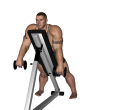 Reverse Row - Overhang Single Dumbbell
Reverse Row - Overhang Single Dumbbell
Benefits: This exercise is a strong, effective free weight back exercise for building muscle mass and size of the lats.
Purpose: This is a good exercise for increasing strength and size in the upper back.
Intermediate Traps Lats Triceps Posterior Delts Strength Dumbbell Incline Bench Pull Compound Gym
General Info: There are a number of muscles in the back, although the two major muscles are the lats and traps. The lats pulls the arm back and down towards the spine. The traps pull the shoulder blades back and towards the spine.
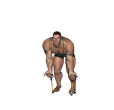 Reverse Row - Resistance Tube Bent Over
Reverse Row - Resistance Tube Bent Over
Benefits: This exercise is a strong, effective free weight back exercise for building muscle mass and size of the lats.
Purpose: This is a good exercise for increasing strength and size in the upper back.
Intermediate Traps Lats Triceps Posterior Delts Strength Resistance Tube Pull Compound Gym
General Info: There are a number of muscles in the back, although the two major muscles are the lats and traps. The lats pulls the arm back and down towards the spine. The traps pull the shoulder blades back and towards the spine.
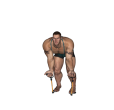 Reverse Row - Resistance Tube Single Bent Over
Reverse Row - Resistance Tube Single Bent Over
Benefits: This exercise is a strong, effective free weight back exercise for building muscle mass and size of the lats.
Purpose: This is a good exercise for increasing strength and size in the upper back.
Intermediate Traps Lats Triceps Posterior Delts Strength Resistance Tube Pull Compound Gym
General Info: There are a number of muscles in the back, although the two major muscles are the lats and traps. The lats pulls the arm back and down towards the spine. The traps pull the shoulder blades back and towards the spine.
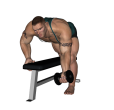 Reverse Row - Single Arm Dumbbell
Reverse Row - Single Arm Dumbbell
Benefits: This exercise is a strong, effective free weight back exercise for building muscle mass and size of the lats.
Purpose: This is a good exercise for increasing strength and size in the upper back.
Intermediate Traps Lats Triceps Posterior Delts Strength Dumbbell Flat Bench Pull Compound Gym
General Info: There are a number of muscles in the back, although the two major muscles are the lats and traps. The lats pulls the arm back and down towards the spine. The traps pull the shoulder blades back and towards the spine.
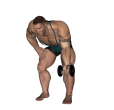 Reverse Row - Single Bent Knee Dumbbell
Reverse Row - Single Bent Knee Dumbbell
Benefits: This exercise is a strong, effective free weight back exercise for building muscle mass and size of the lats.
Purpose: This is a good exercise for increasing strength and size in the upper back.
Intermediate Traps Lats Triceps Posterior Delts Strength Dumbbell Pull Compound Gym
General Info: There are a number of muscles in the back, although the two major muscles are the lats and traps. The lats pulls the arm back and down towards the spine. The traps pull the shoulder blades back and towards the spine.
 Reverse Row - Single Bent Knee Water Bottle
Reverse Row - Single Bent Knee Water Bottle
Benefits: This exercise is a strong, effective free weight back exercise for building muscle mass and size of the lats.
Purpose: This is a good exercise for increasing strength and size in the upper back.
Intermediate Traps Lats Triceps Posterior Delts Strength Water Bottle Pull Compound Home
General Info: There are a number of muscles in the back, although the two major muscles are the lats and traps. The lats pulls the arm back and down towards the spine. The traps pull the shoulder blades back and towards the spine.
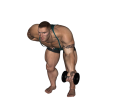 Reverse Row - Single Bent Over Dumbbell
Reverse Row - Single Bent Over Dumbbell
Benefits: This exercise is a strong, effective free weight back exercise for building muscle mass and size of the lats.
Purpose: This is a good exercise for increasing strength and size in the upper back.
Intermediate Traps Lats Triceps Posterior Delts Strength Dumbbell Pull Compound Gym
General Info: There are a number of muscles in the back, although the two major muscles are the lats and traps. The lats pulls the arm back and down towards the spine. The traps pull the shoulder blades back and towards the spine.
 Reverse Row - Single Bent Over Water Bottle
Reverse Row - Single Bent Over Water Bottle
Benefits: This exercise is a strong, effective free weight back exercise for building muscle mass and size of the lats.
Purpose: This is a good exercise for increasing strength and size in the upper back.
Intermediate Traps Lats Triceps Posterior Delts Strength Water Bottle Pull Compound Home
General Info: There are a number of muscles in the back, although the two major muscles are the lats and traps. The lats pulls the arm back and down towards the spine. The traps pull the shoulder blades back and towards the spine.
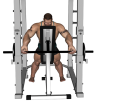 Reverse Row - Smith Incline Wide
Reverse Row - Smith Incline Wide
Benefits: This exercise is a strong, effective free weight back exercise for building muscle mass and size of the lats.
Purpose: This is a good exercise for increasing strength and size in the upper back.
Intermediate Traps Lats Triceps Posterior Delts Strength Smith Machine Incline Bench Pull Compound Gym
General Info: There are a number of muscles in the back, although the two major muscles are the lats and traps. The lats pulls the arm back and down towards the spine. The traps pull the shoulder blades back and towards the spine.
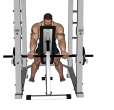 Reverse Row - Smith Machine Incline
Reverse Row - Smith Machine Incline
Benefits: This exercise is a strong, effective free weight back exercise for building muscle mass and size of the lats.
Purpose: This is a good exercise for increasing strength and size in the upper back.
Intermediate Traps Lats Triceps Posterior Delts Strength Smith Machine Incline Bench Pull Compound Gym
General Info: There are a number of muscles in the back, although the two major muscles are the lats and traps. The lats pulls the arm back and down towards the spine. The traps pull the shoulder blades back and towards the spine.
 Reverse Row - Water Bottle
Reverse Row - Water Bottle
Benefits: This exercise is a strong, effective free weight back exercise for building muscle mass and size of the lats.
Purpose: This is a good exercise for increasing strength and size in the upper back.
Intermediate Traps Lats Triceps Posterior Delts Strength Water Bottle Pull Compound Home
General Info: There are a number of muscles in the back, although the two major muscles are the lats and traps. The lats pulls the arm back and down towards the spine. The traps pull the shoulder blades back and towards the spine.
 Reverse Row - Water Bottle Alternate
Reverse Row - Water Bottle Alternate
Benefits: This exercise is a strong, effective free weight back exercise for building muscle mass and size of the lats.
Purpose: This is a good exercise for increasing strength and size in the upper back.
Intermediate Traps Lats Triceps Posterior Delts Strength Water Bottle Pull Compound Home
General Info: There are a number of muscles in the back, although the two major muscles are the lats and traps. The lats pulls the arm back and down towards the spine. The traps pull the shoulder blades back and towards the spine.
 Row - Basic Water Bottle
Row - Basic Water Bottle
Benefits: This exercise is a strong, effective free weight back exercise for building muscle mass and size of the lats.
Purpose: This is a good exercise for increasing strength and size in the upper back.
Intermediate Traps Lats Triceps Posterior Delts Strength Water Bottle Pull Compound Home
General Info: There are a number of muscles in the back, although the two major muscles are the lats and traps. The lats pulls the arm back and down towards the spine. The traps pull the shoulder blades back and towards the spine.
 Row - Basic Water Bottle Alternate
Row - Basic Water Bottle Alternate
Benefits: This exercise is a strong, effective free weight back exercise for building muscle mass and size of the lats.
Purpose: This is a good exercise for increasing strength and size in the upper back.
Intermediate Traps Lats Triceps Posterior Delts Strength Water Bottle Pull Compound Home
General Info: There are a number of muscles in the back, although the two major muscles are the lats and traps. The lats pulls the arm back and down towards the spine. The traps pull the shoulder blades back and towards the spine.
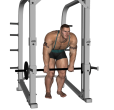 Row - Bent Knee Smith Machine
Row - Bent Knee Smith Machine
Benefits: This exercise is a strong, effective free weight back exercise for building muscle mass and size of the lats.
Purpose: This is a good exercise for increasing strength and size in the upper back.
Intermediate Traps Lats Triceps Posterior Delts Strength Smith Machine Pull Compound Gym
General Info: There are a number of muscles in the back, although the two major muscles are the lats and traps. The lats pulls the arm back and down towards the spine. The traps pull the shoulder blades back and towards the spine.
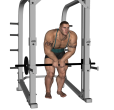 Row - Bent Knee Smith Machine Close
Row - Bent Knee Smith Machine Close
Benefits: This exercise is a strong, effective free weight back exercise for building muscle mass and size of the lats.
Purpose: This is a good exercise for increasing strength and size in the upper back.
Intermediate Traps Lats Triceps Posterior Delts Strength Smith Machine Pull Compound Gym
General Info: There are a number of muscles in the back, although the two major muscles are the lats and traps. The lats pulls the arm back and down towards the spine. The traps pull the shoulder blades back and towards the spine.
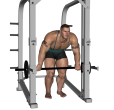 Row - Bent Knee Smith Machine Wide
Row - Bent Knee Smith Machine Wide
Benefits: This exercise is a strong, effective free weight back exercise for building muscle mass and size of the lats.
Purpose: This is a good exercise for increasing strength and size in the upper back.
Intermediate Traps Lats Triceps Posterior Delts Strength Smith Machine Pull Compound Gym
General Info: There are a number of muscles in the back, although the two major muscles are the lats and traps. The lats pulls the arm back and down towards the spine. The traps pull the shoulder blades back and towards the spine.
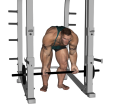 Row - Bent Over Smith Machine
Row - Bent Over Smith Machine
Benefits: This exercise is a strong, effective free weight back exercise for building muscle mass and size of the lats.
Purpose: This is a good exercise for increasing strength and size in the upper back.
Intermediate Traps Lats Triceps Posterior Delts Strength Smith Machine Pull Compound Gym
General Info: There are a number of muscles in the back, although the two major muscles are the lats and traps. The lats pulls the arm back and down towards the spine. The traps pull the shoulder blades back and towards the spine.
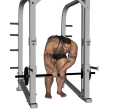 Row - Bent Over Smith Machine Close
Row - Bent Over Smith Machine Close
Benefits: This exercise is a strong, effective free weight back exercise for building muscle mass and size of the lats.
Purpose: This is a good exercise for increasing strength and size in the upper back.
Intermediate Traps Lats Triceps Posterior Delts Strength Smith Machine Pull Compound Gym
General Info: There are a number of muscles in the back, although the two major muscles are the lats and traps. The lats pulls the arm back and down towards the spine. The traps pull the shoulder blades back and towards the spine.
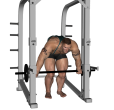 Row - Bent Over Smith Machine Wide
Row - Bent Over Smith Machine Wide
Benefits: This exercise is a strong, effective free weight back exercise for building muscle mass and size of the lats.
Purpose: This is a good exercise for increasing strength and size in the upper back.
Intermediate Traps Lats Triceps Posterior Delts Strength Smith Machine Pull Compound Gym
General Info: There are a number of muscles in the back, although the two major muscles are the lats and traps. The lats pulls the arm back and down towards the spine. The traps pull the shoulder blades back and towards the spine.
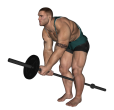 Row - Bent Over Two Arm Long Bar
Row - Bent Over Two Arm Long Bar
Benefits: This exercise is a strong, effective free weight back exercise for building muscle mass and size of the lats.
Purpose: This is a good exercise for increasing strength and size in the upper back.
Intermediate Traps Lats Triceps Posterior Delts Strength Long Bar Pull Compound Gym
General Info: There are a number of muscles in the back, although the two major muscles are the lats and traps. The lats pulls the arm back and down towards the spine. The traps pull the shoulder blades back and towards the spine.
 Row - Bent Over Water Bottle
Row - Bent Over Water Bottle
Benefits: This exercise is a strong, effective free weight back exercise for building muscle mass and size of the lats.
Purpose: This is a good exercise for increasing strength and size in the upper back.
Intermediate Traps Lats Triceps Posterior Delts Strength Water Bottle Pull Compound Home
General Info: There are a number of muscles in the back, although the two major muscles are the lats and traps. The lats pulls the arm back and down towards the spine. The traps pull the shoulder blades back and towards the spine.
 Row - Bent Over Water Bottle Alternate
Row - Bent Over Water Bottle Alternate
Benefits: This exercise is a strong, effective free weight back exercise for building muscle mass and size of the lats.
Purpose: This is a good exercise for increasing strength and size in the upper back.
Intermediate Traps Lats Triceps Posterior Delts Strength Water Bottle Pull Compound Home
General Info: There are a number of muscles in the back, although the two major muscles are the lats and traps. The lats pulls the arm back and down towards the spine. The traps pull the shoulder blades back and towards the spine.
 Row - Bent Over Water Bottle Close Alternate
Row - Bent Over Water Bottle Close Alternate
Benefits: This exercise is a strong, effective free weight back exercise for building muscle mass and size of the lats.
Purpose: This is a good exercise for increasing strength and size in the upper back.
Intermediate Traps Lats Triceps Posterior Delts Strength Water Bottle Pull Compound Home
General Info: There are a number of muscles in the back, although the two major muscles are the lats and traps. The lats pulls the arm back and down towards the spine. The traps pull the shoulder blades back and towards the spine.
 Row - Bent Over Water Bottle Dual
Row - Bent Over Water Bottle Dual
Benefits: This exercise is a strong, effective free weight back exercise for building muscle mass and size of the lats.
Purpose: This is a good exercise for increasing strength and size in the upper back.
Beginner Traps Lats Triceps Posterior Delts Strength Water Bottle Pull Compound Home
General Info: There are a number of muscles in the back, although the two major muscles are the lats and traps. The lats pulls the arm back and down towards the spine. The traps pull the shoulder blades back and towards the spine.
 Row - Bent Over Water Bottle Inwards
Row - Bent Over Water Bottle Inwards
Benefits: This exercise is a strong, effective free weight back exercise for building muscle mass and size of the lats.
Purpose: This is a good exercise for increasing strength and size in the upper back.
Intermediate Traps Lats Triceps Posterior Delts Strength Water Bottle Pull Compound Home
General Info: There are a number of muscles in the back, although the two major muscles are the lats and traps. The lats pulls the arm back and down towards the spine. The traps pull the shoulder blades back and towards the spine.
 Row - Bent Over Water Bottle Inwards Alternate
Row - Bent Over Water Bottle Inwards Alternate
Benefits: This exercise is a strong, effective free weight back exercise for building muscle mass and size of the lats.
Purpose: This is a good exercise for increasing strength and size in the upper back.
Intermediate Traps Lats Triceps Posterior Delts Strength Water Bottle Pull Compound Home
General Info: There are a number of muscles in the back, although the two major muscles are the lats and traps. The lats pulls the arm back and down towards the spine. The traps pull the shoulder blades back and towards the spine.
 Row - Bent Over Water Bottle Narrow
Row - Bent Over Water Bottle Narrow
Benefits: This exercise is a strong, effective free weight back exercise for building muscle mass and size of the lats.
Purpose: This is a good exercise for increasing strength and size in the upper back.
Intermediate Traps Lats Triceps Posterior Delts Strength Water Bottle Pull Compound Home
General Info: There are a number of muscles in the back, although the two major muscles are the lats and traps. The lats pulls the arm back and down towards the spine. The traps pull the shoulder blades back and towards the spine.
 Row - Bent Over Water Bottle Palms In
Row - Bent Over Water Bottle Palms In
Benefits: This exercise is a strong, effective free weight back exercise for building muscle mass and size of the lats.
Purpose: This is a good exercise for increasing strength and size in the upper back.
Intermediate Traps Lats Triceps Posterior Delts Strength Water Bottle Pull Compound Home
General Info: There are a number of muscles in the back, although the two major muscles are the lats and traps. The lats pulls the arm back and down towards the spine. The traps pull the shoulder blades back and towards the spine.
 Row - Bent Over Water Bottle Rotation
Row - Bent Over Water Bottle Rotation
Benefits: This exercise is a strong, effective free weight back exercise for building muscle mass and size of the lats.
Purpose: This is a good exercise for increasing strength and size in the upper back.
Intermediate Traps Lats Triceps Posterior Delts Strength Water Bottle Pull Compound Home
General Info: There are a number of muscles in the back, although the two major muscles are the lats and traps. The lats pulls the arm back and down towards the spine. The traps pull the shoulder blades back and towards the spine.
 Row - Bent Water Bottle Rotation Alternate
Row - Bent Water Bottle Rotation Alternate
Benefits: This exercise is a strong, effective free weight back exercise for building muscle mass and size of the lats.
Purpose: This is a good exercise for increasing strength and size in the upper back.
Intermediate Traps Lats Triceps Posterior Delts Strength Water Bottle Pull Compound Home
General Info: There are a number of muscles in the back, although the two major muscles are the lats and traps. The lats pulls the arm back and down towards the spine. The traps pull the shoulder blades back and towards the spine.
 Row - Bent Water Bottle Single Inwards
Row - Bent Water Bottle Single Inwards
Benefits: This exercise is a strong, effective free weight back exercise for building muscle mass and size of the lats.
Purpose: This is a good exercise for increasing strength and size in the upper back.
Intermediate Traps Lats Triceps Posterior Delts Strength Water Bottle Pull Compound Home
General Info: There are a number of muscles in the back, although the two major muscles are the lats and traps. The lats pulls the arm back and down towards the spine. The traps pull the shoulder blades back and towards the spine.
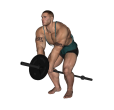 Row - Close Grip
Row - Close Grip
Benefits: This exercise is a strong, effective free weight back exercise for building muscle mass and size of the lats.
Purpose: This is a good exercise for increasing strength and size in the upper back.
Intermediate Traps Lats Triceps Posterior Delts Strength Barbell Pull Compound Gym
General Info: There are a number of muscles in the back, although the two major muscles are the lats and traps. The lats pulls the arm back and down towards the spine. The traps pull the shoulder blades back and towards the spine.
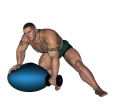 Row - Fitness Ball Single Arm
Row - Fitness Ball Single Arm
Benefits: This exercise is a strong, effective free weight back exercise for building muscle mass and size of the lats.
Purpose: This is a good exercise for increasing strength and size in the upper back.
Intermediate Traps Lats Triceps Posterior Delts Strength Dumbbell Fitness Ball Pull Compound Gym
General Info: There are a number of muscles in the back, although the two major muscles are the lats and traps. The lats pulls the arm back and down towards the spine. The traps pull the shoulder blades back and towards the spine.
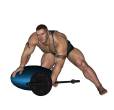 Row - Fitness Ball Single Arm Barbell
Row - Fitness Ball Single Arm Barbell
Benefits: This exercise is a strong, effective free weight back exercise for building muscle mass and size of the lats.
Purpose: This is a good exercise for increasing strength and size in the upper back.
Intermediate Traps Lats Triceps Posterior Delts Strength Barbell Fitness Ball Pull Compound Gym
General Info: There are a number of muscles in the back, although the two major muscles are the lats and traps. The lats pulls the arm back and down towards the spine. The traps pull the shoulder blades back and towards the spine.
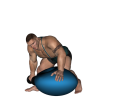 Row - Fitness Ball Single Arm Dumbbell
Row - Fitness Ball Single Arm Dumbbell
Benefits: This exercise is a strong, effective free weight back exercise for building muscle mass and size of the lats.
Purpose: This is a good exercise for increasing strength and size in the upper back.
Intermediate Traps Lats Triceps Posterior Delts Strength Dumbbell Fitness Ball Pull Compound Gym
General Info: There are a number of muscles in the back, although the two major muscles are the lats and traps. The lats pulls the arm back and down towards the spine. The traps pull the shoulder blades back and towards the spine.
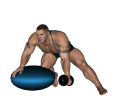 Row - Fitness Ball Single Arm Inwards
Row - Fitness Ball Single Arm Inwards
Benefits: This exercise is a strong, effective free weight back exercise for building muscle mass and size of the lats.
Purpose: This is a good exercise for increasing strength and size in the upper back.
Intermediate Traps Lats Triceps Posterior Delts Strength Dumbbell Fitness Ball Pull Compound Gym
General Info: There are a number of muscles in the back, although the two major muscles are the lats and traps. The lats pulls the arm back and down towards the spine. The traps pull the shoulder blades back and towards the spine.
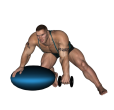 Row - Fitness Ball Single Arm Rotation
Row - Fitness Ball Single Arm Rotation
Benefits: This exercise is a strong, effective free weight back exercise for building muscle mass and size of the lats.
Purpose: This is a good exercise for increasing strength and size in the upper back.
Intermediate Traps Lats Triceps Posterior Delts Strength Dumbbell Fitness Ball Pull Compound Gym
General Info: There are a number of muscles in the back, although the two major muscles are the lats and traps. The lats pulls the arm back and down towards the spine. The traps pull the shoulder blades back and towards the spine.
 Row - Inwards Water Bottle
Row - Inwards Water Bottle
Benefits: This exercise is a strong, effective free weight back exercise for building muscle mass and size of the lats.
Purpose: This is a good exercise for increasing strength and size in the upper back.
Intermediate Traps Lats Triceps Posterior Delts Strength Water Bottle Pull Compound Home
General Info: There are a number of muscles in the back, although the two major muscles are the lats and traps. The lats pulls the arm back and down towards the spine. The traps pull the shoulder blades back and towards the spine.
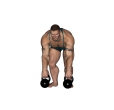 Row - Kettlebell
Row - Kettlebell
Benefits: This exercise is a strong, effective free weight back exercise for building muscle mass and size of the lats.
Purpose: This is a good exercise for increasing strength and size in the upper back.
Intermediate Traps Lats Triceps Posterior Delts Strength Kettlebell Pull Compound Gym
General Info: There are a number of muscles in the back, although the two major muscles are the lats and traps. The lats pulls the arm back and down towards the spine. The traps pull the shoulder blades back and towards the spine.
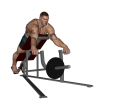 Row - Lying T Bar
Row - Lying T Bar
Benefits: This exercise is a strong, effective free weight back exercise for building muscle mass and size of the lats.
Purpose: This is a good exercise for increasing strength and size in the upper back.
Intermediate Traps Lats Triceps Posterior Delts Strength T-Bar Pull Compound Gym
General Info: There are a number of muscles in the back, although the two major muscles are the lats and traps. The lats pulls the arm back and down towards the spine. The traps pull the shoulder blades back and towards the spine.
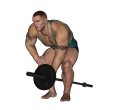 Row - One Arm Long Bar
Row - One Arm Long Bar
Benefits: This exercise is a strong, effective free weight back exercise for building muscle mass and size of the lats.
Purpose: This is a good exercise for increasing strength and size in the upper back.
Intermediate Traps Lats Triceps Posterior Delts Strength Barbell Pull Compound Gym
General Info: There are a number of muscles in the back, although the two major muscles are the lats and traps. The lats pulls the arm back and down towards the spine. The traps pull the shoulder blades back and towards the spine.
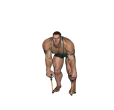 Row - Resistance Tube Bent Over
Row - Resistance Tube Bent Over
Benefits: This exercise is a strong, effective free weight back exercise for building muscle mass and size of the lats.
Purpose: This is a good exercise for increasing strength and size in the upper back.
Intermediate Traps Lats Triceps Posterior Delts Strength Resistance Tube Pull Compound Gym
General Info: There are a number of muscles in the back, although the two major muscles are the lats and traps. The lats pulls the arm back and down towards the spine. The traps pull the shoulder blades back and towards the spine.
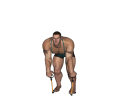 Row - Resistance Tube Bent Over Alternate
Row - Resistance Tube Bent Over Alternate
Benefits: This exercise is a strong, effective free weight back exercise for building muscle mass and size of the lats.
Purpose: This is a good exercise for increasing strength and size in the upper back.
Intermediate Traps Lats Triceps Posterior Delts Strength Resistance Tube Pull Compound Gym
General Info: There are a number of muscles in the back, although the two major muscles are the lats and traps. The lats pulls the arm back and down towards the spine. The traps pull the shoulder blades back and towards the spine.
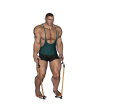 Row - Resistance Tube Inwards
Row - Resistance Tube Inwards
Benefits: This exercise is a strong, effective free weight back exercise for building muscle mass and size of the lats.
Purpose: This is a good exercise for increasing strength and size in the upper back.
Intermediate Traps Lats Triceps Posterior Delts Strength Resistance Tube Pull Compound Gym
General Info: There are a number of muscles in the back, although the two major muscles are the lats and traps. The lats pulls the arm back and down towards the spine. The traps pull the shoulder blades back and towards the spine.
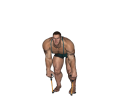 Row - Resistance Tube Rotation
Row - Resistance Tube Rotation
Benefits: This exercise is a strong, effective free weight back exercise for building muscle mass and size of the lats.
Purpose: This is a good exercise for increasing strength and size in the upper back.
Intermediate Traps Lats Triceps Posterior Delts Strength Resistance Tube Pull Compound Gym
General Info: There are a number of muscles in the back, although the two major muscles are the lats and traps. The lats pulls the arm back and down towards the spine. The traps pull the shoulder blades back and towards the spine.
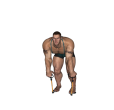 Row - Resistance Tube Rotation Alternate
Row - Resistance Tube Rotation Alternate
Benefits: This exercise is a strong, effective free weight back exercise for building muscle mass and size of the lats.
Purpose: This is a good exercise for increasing strength and size in the upper back.
Intermediate Traps Lats Triceps Posterior Delts Strength Resistance Tube Pull Compound Gym
General Info: There are a number of muscles in the back, although the two major muscles are the lats and traps. The lats pulls the arm back and down towards the spine. The traps pull the shoulder blades back and towards the spine.
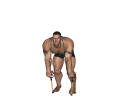 Row - Resistance Tube Single Bent Over
Row - Resistance Tube Single Bent Over
Benefits: This exercise is a strong, effective free weight back exercise for building muscle mass and size of the lats.
Purpose: This is a good exercise for increasing strength and size in the upper back.
Intermediate Traps Lats Triceps Posterior Delts Strength Resistance Tube Pull Compound Gym
General Info: There are a number of muscles in the back, although the two major muscles are the lats and traps. The lats pulls the arm back and down towards the spine. The traps pull the shoulder blades back and towards the spine.
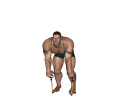 Row - Resistance Tube Single Rotation
Row - Resistance Tube Single Rotation
Benefits: This exercise is a strong, effective free weight back exercise for building muscle mass and size of the lats.
Purpose: This is a good exercise for increasing strength and size in the upper back.
Intermediate Traps Lats Triceps Posterior Delts Strength Resistance Tube Pull Compound Gym
General Info: There are a number of muscles in the back, although the two major muscles are the lats and traps. The lats pulls the arm back and down towards the spine. The traps pull the shoulder blades back and towards the spine.
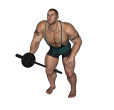 Row - Single Arm Barbell Variation
Row - Single Arm Barbell Variation
Benefits: This exercise is a strong, effective free weight back exercise for building muscle mass and size of the lats.
Purpose: This is a good exercise for increasing strength and size in the upper back.
Intermediate Traps Lats Triceps Posterior Delts Strength Barbell Pull Compound Gym
General Info: There are a number of muscles in the back, although the two major muscles are the lats and traps. The lats pulls the arm back and down towards the spine. The traps pull the shoulder blades back and towards the spine.
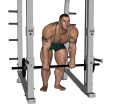 Row - Smith Machine
Row - Smith Machine
Benefits: This exercise is a strong, effective free weight back exercise for building muscle mass and size of the lats.
Purpose: This is a good exercise for increasing strength and size in the upper back.
Intermediate Traps Lats Triceps Posterior Delts Strength Smith Machine Pull Compound Gym
General Info: There are a number of muscles in the back, although the two major muscles are the lats and traps. The lats pulls the arm back and down towards the spine. The traps pull the shoulder blades back and towards the spine.
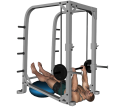 Row - Smith Machine Ball Inverted
Row - Smith Machine Ball Inverted
Benefits: This exercise is a strong, effective free weight back exercise for building muscle mass and size of the lats.
Purpose: This is a good exercise for increasing strength and size in the upper back.
Intermediate Traps Lats Triceps Posterior Delts Strength Smith Machine Fitness Ball Pull Compound Gym
General Info: There are a number of muscles in the back, although the two major muscles are the lats and traps. The lats pulls the arm back and down towards the spine. The traps pull the shoulder blades back and towards the spine.
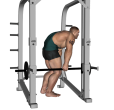 Row - Smith Machine Bent Knee Single Arm
Row - Smith Machine Bent Knee Single Arm
Benefits: This exercise is a strong, effective free weight back exercise for building muscle mass and size of the lats.
Purpose: This is a good exercise for increasing strength and size in the upper back.
Intermediate Traps Lats Triceps Posterior Delts Strength Smith Machine Pull Compound Gym
General Info: There are a number of muscles in the back, although the two major muscles are the lats and traps. The lats pulls the arm back and down towards the spine. The traps pull the shoulder blades back and towards the spine.
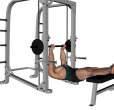 Row - Smith Machine High Inverted
Row - Smith Machine High Inverted
Benefits: This exercise is a strong, effective free weight back exercise for building muscle mass and size of the lats.
Purpose: This is a good exercise for increasing strength and size in the upper back.
Intermediate Traps Lats Triceps Posterior Delts Strength Smith Machine Flat Bench Pull Compound Gym
General Info: There are a number of muscles in the back, although the two major muscles are the lats and traps. The lats pulls the arm back and down towards the spine. The traps pull the shoulder blades back and towards the spine.
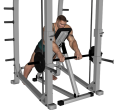 Row - Smith Machine Incline
Row - Smith Machine Incline
Benefits: This exercise is a strong, effective free weight back exercise for building muscle mass and size of the lats.
Purpose: This is a good exercise for increasing strength and size in the upper back.
Intermediate Traps Lats Triceps Posterior Delts Strength Smith Machine Incline Bench Pull Compound Gym
General Info: There are a number of muscles in the back, although the two major muscles are the lats and traps. The lats pulls the arm back and down towards the spine. The traps pull the shoulder blades back and towards the spine.
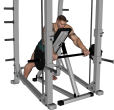 Row - Smith Machine Incline Wide
Row - Smith Machine Incline Wide
Benefits: This exercise is a strong, effective free weight back exercise for building muscle mass and size of the lats.
Purpose: This is a good exercise for increasing strength and size in the upper back.
Intermediate Traps Lats Triceps Posterior Delts Strength Smith Machine Incline Bench Pull Compound Gym
General Info: There are a number of muscles in the back, although the two major muscles are the lats and traps. The lats pulls the arm back and down towards the spine. The traps pull the shoulder blades back and towards the spine.
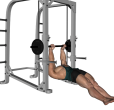 Row - Smith Machine Lying Inverted
Row - Smith Machine Lying Inverted
Benefits: This exercise is a strong, effective free weight back exercise for building muscle mass and size of the lats.
Purpose: This is a good exercise for increasing strength and size in the upper back.
Intermediate Traps Lats Triceps Posterior Delts Strength Smith Machine Pull Compound Gym
General Info: There are a number of muscles in the back, although the two major muscles are the lats and traps. The lats pulls the arm back and down towards the spine. The traps pull the shoulder blades back and towards the spine.
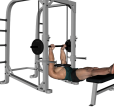 Row - Smith Machine Plate Inverted
Row - Smith Machine Plate Inverted
Benefits: This exercise is a strong, effective free weight back exercise for building muscle mass and size of the lats.
Purpose: This is a good exercise for increasing strength and size in the upper back.
Intermediate Traps Lats Triceps Posterior Delts Strength Smith Machine Flat Bench Plate Pull Compound Gym
General Info: There are a number of muscles in the back, although the two major muscles are the lats and traps. The lats pulls the arm back and down towards the spine. The traps pull the shoulder blades back and towards the spine.
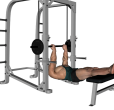 Row - Smith Reverse Grip High Inverted
Row - Smith Reverse Grip High Inverted
Benefits: This exercise is a strong, effective free weight back exercise for building muscle mass and size of the lats.
Purpose: This is a good exercise for increasing strength and size in the upper back.
Intermediate Traps Lats Triceps Posterior Delts Strength Smith Machine Flat Bench Pull Compound Gym
General Info: There are a number of muscles in the back, although the two major muscles are the lats and traps. The lats pulls the arm back and down towards the spine. The traps pull the shoulder blades back and towards the spine.
 Row - Smith Reverse Grip Inverted
Row - Smith Reverse Grip Inverted
Benefits: This exercise is a strong, effective free weight back exercise for building muscle mass and size of the lats.
Purpose: This is a good exercise for increasing strength and size in the upper back.
Intermediate Traps Lats Triceps Posterior Delts Strength Smith Machine Pull Compound Gym
General Info: There are a number of muscles in the back, although the two major muscles are the lats and traps. The lats pulls the arm back and down towards the spine. The traps pull the shoulder blades back and towards the spine.
 Row - Tube Single Bent Over Inwards
Row - Tube Single Bent Over Inwards
Benefits: This exercise is a strong, effective free weight back exercise for building muscle mass and size of the lats.
Purpose: This is a good exercise for increasing strength and size in the upper back.
Intermediate Traps Lats Triceps Posterior Delts Strength Resistance Tube Pull Compound Gym
General Info: There are a number of muscles in the back, although the two major muscles are the lats and traps. The lats pulls the arm back and down towards the spine. The traps pull the shoulder blades back and towards the spine.
 Row - Water Bottle Inwards Alternate
Row - Water Bottle Inwards Alternate
Benefits: This exercise is a strong, effective free weight back exercise for building muscle mass and size of the lats.
Purpose: This is a good exercise for increasing strength and size in the upper back.
Intermediate Traps Lats Triceps Posterior Delts Strength Water Bottle Pull Compound Home
General Info: There are a number of muscles in the back, although the two major muscles are the lats and traps. The lats pulls the arm back and down towards the spine. The traps pull the shoulder blades back and towards the spine.
 Row - Water Bottle Rotation
Row - Water Bottle Rotation
Benefits: This exercise is a strong, effective free weight back exercise for building muscle mass and size of the lats.
Purpose: This is a good exercise for increasing strength and size in the upper back.
Intermediate Traps Lats Triceps Posterior Delts Strength Water Bottle Pull Compound Home
General Info: There are a number of muscles in the back, although the two major muscles are the lats and traps. The lats pulls the arm back and down towards the spine. The traps pull the shoulder blades back and towards the spine.
 Row - Water Bottle Rotation Alternate
Row - Water Bottle Rotation Alternate
Benefits: This exercise is a strong, effective free weight back exercise for building muscle mass and size of the lats.
Purpose: This is a good exercise for increasing strength and size in the upper back.
Intermediate Traps Lats Triceps Posterior Delts Strength Water Bottle Pull Compound Home
General Info: There are a number of muscles in the back, although the two major muscles are the lats and traps. The lats pulls the arm back and down towards the spine. The traps pull the shoulder blades back and towards the spine.
 Row - Water Bottle Single Bent Over
Row - Water Bottle Single Bent Over
Benefits: This exercise is a strong, effective free weight back exercise for building muscle mass and size of the lats.
Purpose: This is a good exercise for increasing strength and size in the upper back.
Intermediate Traps Lats Triceps Posterior Delts Strength Water Bottle Pull Compound Home
General Info: There are a number of muscles in the back, although the two major muscles are the lats and traps. The lats pulls the arm back and down towards the spine. The traps pull the shoulder blades back and towards the spine.
 Row - Water Bottle Single Bent Over Rotation
Row - Water Bottle Single Bent Over Rotation
Benefits: This exercise is a strong, effective free weight back exercise for building muscle mass and size of the lats.
Purpose: This is a good exercise for increasing strength and size in the upper back.
Intermediate Traps Lats Triceps Posterior Delts Strength Water Bottle Pull Compound Home
General Info: There are a number of muscles in the back, although the two major muscles are the lats and traps. The lats pulls the arm back and down towards the spine. The traps pull the shoulder blades back and towards the spine.
 Row - Water Bottle Single Bent Over Rotation Variation
Row - Water Bottle Single Bent Over Rotation Variation
Benefits: This exercise is a strong, effective free weight back exercise for building muscle mass and size of the lats.
Purpose: This is a good exercise for increasing strength and size in the upper back.
Intermediate Traps Lats Triceps Posterior Delts Strength Water Bottle Pull Compound Home
General Info: There are a number of muscles in the back, although the two major muscles are the lats and traps. The lats pulls the arm back and down towards the spine. The traps pull the shoulder blades back and towards the spine.
 Row - With Chains
Row - With Chains
Benefits: This exercise is done with the addition of chains. The primary function of chains is to accommodate resistance. Chains are also a great means of weight loading (adding more weight to an exercise). Chains are also a great way for working the stabilizers.
Purpose: Benefits This exercise is a strong, effective free weight back exercise for building muscle mass and size of the lats.
Intermediate Traps Lats Triceps Posterior Delts Strength Chains Pull Compound Home
General Info: There are a number of muscles in the back, although the two major muscles are the lats and traps. The lats pulls the arm back and down towards the spine. The traps pull the shoulder blades back and towards the spine.
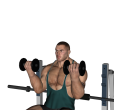 Shoulder Press - Arnold Dumbbell
Shoulder Press - Arnold Dumbbell
Benefits: The press is a highly effective compound upper-body exercise.
Purpose: Shoulder presses are good exercises for building up and strengthening the shoulder region. The Arnold Shoulder Press is an excellent intermediate alternative to the standard shoulder press.
Intermediate Shoulders Forearms Triceps Strength Dumbbell Flat Bench Push Compound Gym
General Info: The deltoid is a fan-shaped muscle. The Anterior (front) deltoid raises the arm toward the front of the body and rotates the arm inward. The Lateral (side) deltoid raises the arm to the side. The Posterior (rear) deltoid raises the arm toward the rear and rotates the arm outward. This exercise was created by bodybuilder Arnold Schwarzenegger and hits both the medial and front heads of deltoids.
 Shoulder Press - Arnold Water Bottle
Shoulder Press - Arnold Water Bottle
Benefits: The press is a highly effective compound upper-body exercise.
Purpose: Shoulder presses are good exercises for building up and strengthening the shoulder region. The Arnold Shoulder Press is an excellent intermediate alternative to the standard shoulder press.
Intermediate Shoulders Forearms Triceps Strength Water Bottle Chair Push Compound Home
General Info: The deltoids is a fan-shaped muscle. The Anterior (front) deltoid raises the arm toward the front of the body and rotates the arm inward. The Lateral (side) deltoid raises the arm to the side. The Posterior (rear) deltoid raises the arm toward the rear and rotates the arm outward. This exercise was created by bodybuilder Arnold Schwarzenegger and hits both the medial and front heads of deltoids.
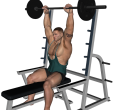 Shoulder Press - Barbell
Shoulder Press - Barbell
Benefits: The press is a highly effective compound upper-body exercise.
Purpose: The Barbell Shoulder Press (sometimes called the Military Press) is a good exercise for building up and strengthening the shoulder region.
Intermediate Shoulders Triceps Chest Strength Barbell Military Press Chair Push Compound Gym
General Info: The Deltoids is a fan-shaped muscle. The Anterior (Front) Deltoid raises the arm toward the front of the body and rotates the arm inward. The Lateral (Side) Deltoid raises the arm to the side. The Posterior (Rear) Deltoid raises the arm toward the rear and rotates the arm outward.
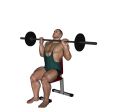 Shoulder Press - Bradford Rocky
Shoulder Press - Bradford Rocky
Benefits: The press is a highly effective compound upper-body exercise.
Purpose: The Military Press is a good exercise for building up and strengthening the shoulder region.
Intermediate Shoulders Triceps Chest Strength Barbell Push Compound Gym
General Info: The Deltoids is a fan-shaped muscle. The Anterior (Front) Deltoid raises the arm toward the front of the body and rotates the arm inward. The Lateral (Side) Deltoid raises the arm to the side. The Posterior (Rear) Deltoid raises the arm toward the rear and rotates the arm outward.
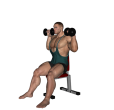 Shoulder Press - Dumbbell
Shoulder Press - Dumbbell
Benefits: The press is a highly effective compound upper-body exercise.
Purpose: The Shoulder Press is a good exercise for building up and strengthening the shoulder region.
Beginner Shoulders Triceps Chest Strength Dumbbell Military Press Chair Push Compound Gym
General Info: The Deltoids is a fan-shaped muscle. The Anterior (Front) Deltoid raises the arm toward the front of the body and rotates the arm inward. The Lateral (Side) Deltoid raises the arm to the side. The Posterior (Rear) Deltoid raises the arm toward the rear and rotates the arm outward.
 Shoulder Press - Dumbbell Single
Shoulder Press - Dumbbell Single
Benefits: The press is a highly effective compound upper-body exercise.
Purpose: The Barbell Shoulder Press (sometimes called the Military Press) is a good exercise for building up and strengthening the shoulder region.
Beginner Shoulders Triceps Chest Strength Dumbbell Military Press Chair Push Compound Gym
General Info: The Deltoids is a fan-shaped muscle. The Anterior (Front) Deltoid raises the arm toward the front of the body and rotates the arm inward. The Lateral (Side) Deltoid raises the arm to the side. The Posterior (Rear) Deltoid raises the arm toward the rear and rotates the arm outward.
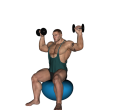 Shoulder Press - Fitness Ball Dublin
Shoulder Press - Fitness Ball Dublin
Benefits: The shoulder press is a highly effective compound upper-body exercise.
Purpose: The shoulder press is a good exercise for building up and strengthening the shoulder region.
Intermediate Shoulders Triceps Strength Dumbbell Fitness Ball Push Compound Gym
General Info: The Deltoids is a fan-shaped muscle. The Anterior (Front) Deltoid raises the arm toward the front of the body and rotates the arm inward. The Lateral (Side) Deltoid raises the arm to the side. The Posterior (Rear) Deltoid raises the arm toward the rear and rotates the arm outward.
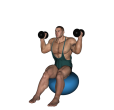 Shoulder Press - Fitness Ball Dumbbell Inwards
Shoulder Press - Fitness Ball Dumbbell Inwards
Benefits: The press is a highly effective compound upper-body exercise.
Purpose: The shoulder press is a good exercise for building up and strengthening the shoulder region.
Beginner Shoulders Triceps Chest Strength Dumbbell Fitness Ball Push Compound Gym
General Info: The Deltoids is a fan-shaped muscle. The Anterior (Front) Deltoid raises the arm toward the front of the body and rotates the arm inward. The Lateral (Side) Deltoid raises the arm to the side. The Posterior (Rear) Deltoid raises the arm toward the rear and rotates the arm outward.
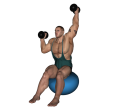 Shoulder Press - Fitness Ball Dumbbell Inwards Alternate
Shoulder Press - Fitness Ball Dumbbell Inwards Alternate
Benefits: The press is a highly effective compound upper-body exercise.
Purpose: The shoulder press is a good exercise for building up and strengthening the shoulder region.
Beginner Shoulders Triceps Chest Strength Dumbbell Fitness Ball Push Compound Gym
General Info: The Deltoids is a fan-shaped muscle. The Anterior (Front) Deltoid raises the arm toward the front of the body and rotates the arm inward. The Lateral (Side) Deltoid raises the arm to the side. The Posterior (Rear) Deltoid raises the arm toward the rear and rotates the arm outward.
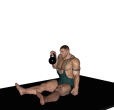 Shoulder Press - Kettlebell
Shoulder Press - Kettlebell
Benefits: The press is a highly effective compound upper-body exercise.
Purpose: The Shoulder Press is a good exercise for building up and strengthening the shoulder region.
Shoulders Triceps Chest Strength Kettlebell Push Compound Gym
General Info: The Deltoids is a fan-shaped muscle. The Anterior (Front) Deltoid raises the arm toward the front of the body and rotates the arm inward. The Lateral (Side) Deltoid raises the arm to the side. The Posterior (Rear) Deltoid raises the arm toward the rear and rotates the arm outward.
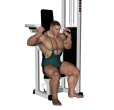 Shoulder Press - Machine
Shoulder Press - Machine
Benefits: The press is a highly effective compound upper-body exercise.
Purpose: The press is a good exercise for building up and strengthening the shoulder region.
Intermediate Shoulders Triceps Chest Strength Shoulder Press Machine Push Compound Gym
General Info: The Deltoids is a fan-shaped muscle. The Anterior (Front) Deltoid raises the arm toward the front of the body and rotates the arm inward. The Lateral (Side) Deltoid raises the arm to the side. The Posterior (Rear) Deltoid raises the arm toward the rear and rotates the arm outward.
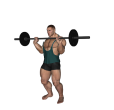 Shoulder Press - Push
Shoulder Press - Push
Benefits: The press is a highly effective compound upper-body exercise.
Purpose: The push press is a good exercise for building up and strengthening the shoulder region.
Intermediate Shoulders Triceps Chest Strength Barbell Push Compound Gym
General Info: The Deltoids is a fan-shaped muscle. The Anterior (Front) Deltoid raises the arm toward the front of the body and rotates the arm inward. The Lateral (Side) Deltoid raises the arm to the side. The Posterior (Rear) Deltoid raises the arm toward the rear and rotates the arm outward.
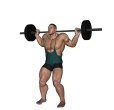 Shoulder Press - Push Behind The Neck
Shoulder Press - Push Behind The Neck
Benefits: The press is a highly effective compound upper-body exercise.
Purpose: The push press is a good exercise for building up and strengthening the shoulder region.
Intermediate Shoulders Triceps Chest Strength Barbell Push Compound Gym
General Info: The Deltoids is a fan-shaped muscle. The Anterior (Front) Deltoid raises the arm toward the front of the body and rotates the arm inward. The Lateral (Side) Deltoid raises the arm to the side. The Posterior (Rear) Deltoid raises the arm toward the rear and rotates the arm outward.
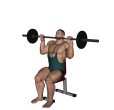 Shoulder Press - Seated Barbell Military
Shoulder Press - Seated Barbell Military
Benefits: The press is a highly effective compound upper-body exercise.
Purpose: The Military Press is a good exercise for building up and strengthening the shoulder region.
Intermediate Shoulders Triceps Chest Strength Barbell Military Press Chair Push Compound Gym
General Info: The deltoid is a fan-shaped muscle. The Anterior (Front) Deltoid raises the arm toward the front of the body and rotates the arm inward. The Lateral (Side) Deltoid raises the arm to the side. The Posterior (Rear) Deltoid raises the arm toward the rear and rotates the arm outward.
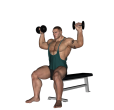 Shoulder Press - Seated Dublin
Shoulder Press - Seated Dublin
Benefits: The press is a highly effective compound upper-body exercise.
Purpose: The shoulder press is a good exercise for building up and strengthening the shoulder region.
Intermediate Shoulders Triceps Strength Dumbbell Flat Bench Push Compound Gym
General Info: The Deltoids is a fan-shaped muscle. The Anterior (Front) Deltoid raises the arm toward the front of the body and rotates the arm inward. The Lateral (Side) Deltoid raises the arm to the side. The Posterior (Rear) Deltoid raises the arm toward the rear and rotates the arm outward.
 Shoulder Press - Seated Dublin Water Bottle
Shoulder Press - Seated Dublin Water Bottle
Benefits: The press is a highly effective compound upper-body exercise.
Purpose: The Press is a good exercise for building up and strengthening the shoulder region.
Intermediate Shoulders Triceps Strength Water Bottle Chair Push Compound Home
General Info: The Deltoids is a fan-shaped muscle. The Anterior (Front) Deltoid raises the arm toward the front of the body and rotates the arm inward. The Lateral (Side) Deltoid raises the arm to the side. The Posterior (Rear) Deltoid raises the arm toward the rear and rotates the arm outward.
 Shoulder Press - Smith Machine Kneeling Front
Shoulder Press - Smith Machine Kneeling Front
Benefits: The press is a highly effective compound upper-body exercise.
Purpose: The shoulder press is a good exercise for building up and strengthening the shoulder region.
Intermediate Shoulders Triceps Chest Strength Smith Machine Push Compound Gym
General Info: The Deltoids is a fan-shaped muscle. The Anterior (Front) Deltoid raises the arm toward the front of the body and rotates the arm inward. The Lateral (Side) Deltoid raises the arm to the side. The Posterior (Rear) Deltoid raises the arm toward the rear and rotates the arm outward.
 Shoulder Press - Smith Machine Kneeling Rear
Shoulder Press - Smith Machine Kneeling Rear
Benefits: The press is a highly effective compound upper-body exercise.
Purpose: The shoulder press is a good exercise for building up and strengthening the shoulder region.
Intermediate Shoulders Triceps Chest Strength Smith Machine Push Compound Gym
General Info: The Deltoids is a fan-shaped muscle. The Anterior (Front) Deltoid raises the arm toward the front of the body and rotates the arm inward. The Lateral (Side) Deltoid raises the arm to the side. The Posterior (Rear) Deltoid raises the arm toward the rear and rotates the arm outward.
 Shoulder Press - Smith Machine Kneeling Reverse
Shoulder Press - Smith Machine Kneeling Reverse
Benefits: The press is a highly effective compound upper-body exercise.
Purpose: The shoulder press is a good exercise for building up and strengthening the shoulder region.
Intermediate Shoulders Triceps Chest Strength Smith Machine Push Compound Gym
General Info: The Deltoids is a fan-shaped muscle. The Anterior (Front) Deltoid raises the arm toward the front of the body and rotates the arm inward. The Lateral (Side) Deltoid raises the arm to the side. The Posterior (Rear) Deltoid raises the arm toward the rear and rotates the arm outward.
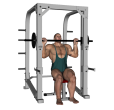 Shoulder Press - Smith Machine Overhead
Shoulder Press - Smith Machine Overhead
Benefits: The press is a highly effective compound upper-body exercise.
Purpose: The shoulder press is a good exercise for building up and strengthening the shoulder region.
Intermediate Shoulders Triceps Chest Strength Smith Machine Push Compound Gym
General Info: The Deltoids is a fan-shaped muscle. The Anterior (Front) Deltoid raises the arm toward the front of the body and rotates the arm inward. The Lateral (Side) Deltoid raises the arm to the side. The Posterior (Rear) Deltoid raises the arm toward the rear and rotates the arm outward.
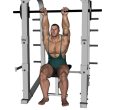 Shoulder Press - Smith Machine Seated
Shoulder Press - Smith Machine Seated
Benefits: The press is a highly effective compound upper-body exercise.
Purpose: The shoulder press is a good exercise for building up and strengthening the shoulder region.
Intermediate Shoulders Triceps Chest Strength Smith Machine Flat Bench Push Compound Gym
General Info: The Deltoids is a fan-shaped muscle. The Anterior (Front) Deltoid raises the arm toward the front of the body and rotates the arm inward. The Lateral (Side) Deltoid raises the arm to the side. The Posterior (Rear) Deltoid raises the arm toward the rear and rotates the arm outward.
 Shoulder Press - Smith Machine Seated Feet Up
Shoulder Press - Smith Machine Seated Feet Up
Benefits: The press is a highly effective compound upper-body exercise.
Purpose: The shoulder press is a good exercise for building up and strengthening the shoulder region.
Intermediate Shoulders Triceps Chest Strength Smith Machine Flat Bench Push Compound Gym
General Info: The Deltoids is a fan-shaped muscle. The Anterior (Front) Deltoid raises the arm toward the front of the body and rotates the arm inward. The Lateral (Side) Deltoid raises the arm to the side. The Posterior (Rear) Deltoid raises the arm toward the rear and rotates the arm outward.
 Shoulder Press - Smith Machine Seated Feet Up Rear
Shoulder Press - Smith Machine Seated Feet Up Rear
Benefits: The press is a highly effective compound upper-body exercise.
Purpose: The shoulder press is a good exercise for building up and strengthening the shoulder region.
Intermediate Shoulders Triceps Chest Strength Smith Machine Flat Bench Push Compound Gym
General Info: The Deltoids is a fan-shaped muscle. The Anterior (Front) Deltoid raises the arm toward the front of the body and rotates the arm inward. The Lateral (Side) Deltoid raises the arm to the side. The Posterior (Rear) Deltoid raises the arm toward the rear and rotates the arm outward.
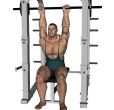 Shoulder Press - Smith Machine Seated Rear
Shoulder Press - Smith Machine Seated Rear
Benefits: The press is a highly effective compound upper-body exercise.
Purpose: The shoulder press is a good exercise for building up and strengthening the shoulder region.
Intermediate Shoulders Triceps Chest Strength Smith Machine Flat Bench Push Compound Gym
General Info: The Deltoids is a fan-shaped muscle. The Anterior (Front) Deltoid raises the arm toward the front of the body and rotates the arm inward. The Lateral (Side) Deltoid raises the arm to the side. The Posterior (Rear) Deltoid raises the arm toward the rear and rotates the arm outward.
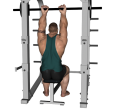 Shoulder Press - Smith Machine Seated Reverse
Shoulder Press - Smith Machine Seated Reverse
Benefits: The press is a highly effective compound upper-body exercise.
Purpose: The shoulder press is a good exercise for building up and strengthening the shoulder region.
Intermediate Shoulders Triceps Chest Strength Smith Machine Flat Bench Push Compound Gym
General Info: The Deltoids is a fan-shaped muscle. The Anterior (Front) Deltoid raises the arm toward the front of the body and rotates the arm inward. The Lateral (Side) Deltoid raises the arm to the side. The Posterior (Rear) Deltoid raises the arm toward the rear and rotates the arm outward.
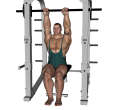 Shoulder Press - Smith Machine Seated Upright
Shoulder Press - Smith Machine Seated Upright
Benefits: The press is a highly effective compound upper-body exercise.
Purpose: The shoulder press is a good exercise for building up and strengthening the shoulder region.
Intermediate Shoulders Triceps Chest Strength Smith Machine Flat Bench Push Compound Gym
General Info: The Deltoids is a fan-shaped muscle. The Anterior (Front) Deltoid raises the arm toward the front of the body and rotates the arm inward. The Lateral (Side) Deltoid raises the arm to the side. The Posterior (Rear) Deltoid raises the arm toward the rear and rotates the arm outward.
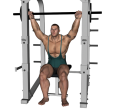 Shoulder Press - Smith Machine Seated Wide Grip
Shoulder Press - Smith Machine Seated Wide Grip
Benefits: The press is a highly effective compound upper-body exercise.
Purpose: The shoulder press is a good exercise for building up and strengthening the shoulder region.
Intermediate Shoulders Triceps Chest Strength Smith Machine Flat Bench Push Compound Gym
General Info: The Deltoids is a fan-shaped muscle. The Anterior (Front) Deltoid raises the arm toward the front of the body and rotates the arm inward. The Lateral (Side) Deltoid raises the arm to the side. The Posterior (Rear) Deltoid raises the arm toward the rear and rotates the arm outward.
 Shoulder Press - Smith Seated Feet On Bench Rear
Shoulder Press - Smith Seated Feet On Bench Rear
Benefits: The press is a highly effective compound upper-body exercise.
Purpose: The shoulder press is a good exercise for building up and strengthening the shoulder region.
Intermediate Shoulders Triceps Chest Strength Smith Machine Flat Bench Push Compound Gym
General Info: The Deltoids is a fan-shaped muscle. The Anterior (Front) Deltoid raises the arm toward the front of the body and rotates the arm inward. The Lateral (Side) Deltoid raises the arm to the side. The Posterior (Rear) Deltoid raises the arm toward the rear and rotates the arm outward.
 Shoulder Press - Smith Seated Feet Up Reverse
Shoulder Press - Smith Seated Feet Up Reverse
Benefits: The press is a highly effective compound upper-body exercise.
Purpose: The shoulder press is a good exercise for building up and strengthening the shoulder region.
Intermediate Shoulders Triceps Chest Strength Smith Machine Flat Bench Push Compound Gym
General Info: The Deltoids is a fan-shaped muscle. The Anterior (Front) Deltoid raises the arm toward the front of the body and rotates the arm inward. The Lateral (Side) Deltoid raises the arm to the side. The Posterior (Rear) Deltoid raises the arm toward the rear and rotates the arm outward.
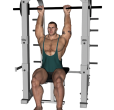 Shoulder Press - Smith Seated Rear Upright
Shoulder Press - Smith Seated Rear Upright
Benefits: The press is a highly effective compound upper-body exercise.
Purpose: The shoulder press is a good exercise for building up and strengthening the shoulder region.
Intermediate Shoulders Triceps Chest Strength Smith Machine Flat Bench Push Compound Gym
General Info: The Deltoids is a fan-shaped muscle. The Anterior (Front) Deltoid raises the arm toward the front of the body and rotates the arm inward. The Lateral (Side) Deltoid raises the arm to the side. The Posterior (Rear) Deltoid raises the arm toward the rear and rotates the arm outward.
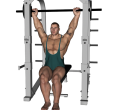 Shoulder Press - Smith Seated Rear Upright Wide
Shoulder Press - Smith Seated Rear Upright Wide
Benefits: The press is a highly effective compound upper-body exercise.
Purpose: The shoulder press is a good exercise for building up and strengthening the shoulder region.
Intermediate Shoulders Triceps Chest Strength Smith Machine Flat Bench Push Compound Gym
General Info: The Deltoids is a fan-shaped muscle. The Anterior (Front) Deltoid raises the arm toward the front of the body and rotates the arm inward. The Lateral (Side) Deltoid raises the arm to the side. The Posterior (Rear) Deltoid raises the arm toward the rear and rotates the arm outward.
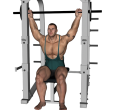 Shoulder Press - Smith Seated Rear Wide Grip
Shoulder Press - Smith Seated Rear Wide Grip
Benefits: The press is a highly effective compound upper-body exercise.
Purpose: The shoulder press is a good exercise for building up and strengthening the shoulder region.
Intermediate Shoulders Triceps Chest Strength Smith Machine Flat Bench Push Compound Gym
General Info: The Deltoids is a fan-shaped muscle. The Anterior (Front) Deltoid raises the arm toward the front of the body and rotates the arm inward. The Lateral (Side) Deltoid raises the arm to the side. The Posterior (Rear) Deltoid raises the arm toward the rear and rotates the arm outward.
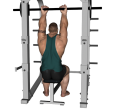 Shoulder Press - Smith Seated Reverse
Shoulder Press - Smith Seated Reverse
Benefits: The press is a highly effective compound upper-body exercise.
Purpose: The shoulder press is a good exercise for building up and strengthening the shoulder region.
Intermediate Shoulders Triceps Chest Strength Smith Machine Flat Bench Push Compound Gym
General Info: The Deltoids is a fan-shaped muscle. The Anterior (Front) Deltoid raises the arm toward the front of the body and rotates the arm inward. The Lateral (Side) Deltoid raises the arm to the side. The Posterior (Rear) Deltoid raises the arm toward the rear and rotates the arm outward.
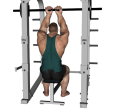 Shoulder Press - Smith Seated Reverse Close Grip
Shoulder Press - Smith Seated Reverse Close Grip
Benefits: The press is a highly effective compound upper-body exercise.
Purpose: The shoulder press is a good exercise for building up and strengthening the shoulder region.
Intermediate Shoulders Triceps Chest Strength Smith Machine Flat Bench Push Compound Gym
General Info: The Deltoids is a fan-shaped muscle. The Anterior (Front) Deltoid raises the arm toward the front of the body and rotates the arm inward. The Lateral (Side) Deltoid raises the arm to the side. The Posterior (Rear) Deltoid raises the arm toward the rear and rotates the arm outward.
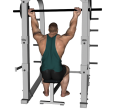 Shoulder Press - Smith Seated Reverse Wide
Shoulder Press - Smith Seated Reverse Wide
Benefits: The press is a highly effective compound upper-body exercise.
Purpose: The shoulder press is a good exercise for building up and strengthening the shoulder region.
Intermediate Shoulders Triceps Chest Strength Smith Machine Flat Bench Push Compound Gym
General Info: The Deltoids is a fan-shaped muscle. The Anterior (Front) Deltoid raises the arm toward the front of the body and rotates the arm inward. The Lateral (Side) Deltoid raises the arm to the side. The Posterior (Rear) Deltoid raises the arm toward the rear and rotates the arm outward.
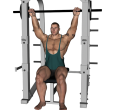 Shoulder Press - Smith Seated Upright Wide Grip
Shoulder Press - Smith Seated Upright Wide Grip
Benefits: The press is a highly effective compound upper-body exercise.
Purpose: The shoulder press is a good exercise for building up and strengthening the shoulder region.
Intermediate Shoulders Triceps Chest Strength Smith Machine Flat Bench Push Compound Gym
General Info: The Deltoids is a fan-shaped muscle. The Anterior (Front) Deltoid raises the arm toward the front of the body and rotates the arm inward. The Lateral (Side) Deltoid raises the arm to the side. The Posterior (Rear) Deltoid raises the arm toward the rear and rotates the arm outward.
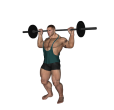 Shoulder Press - Standing Barbell Behind Neck
Shoulder Press - Standing Barbell Behind Neck
Benefits: The press is a highly effective compound upper-body exercise.
Purpose: The press is a good exercise for building up and strengthening the shoulder region.
Intermediate Shoulders Triceps Chest Strength Barbell Push Compound Gym
General Info: The Deltoids is a fan-shaped muscle. The Anterior (Front) Deltoid raises the arm toward the front of the body and rotates the arm inward. The Lateral (Side) Deltoid raises the arm to the side. The Posterior (Rear) Deltoid raises the arm toward the rear and rotates the arm outward.
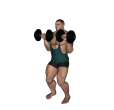 Shoulder Press - Standing Dumbbell
Shoulder Press - Standing Dumbbell
Benefits: The press is a highly effective compound upper-body exercise.
Purpose: The press is a good exercise for building up and strengthening the shoulder region.
Intermediate Shoulders Triceps Chest Strength Dumbbell Push Compound Gym
General Info: The Deltoids is a fan-shaped muscle. The Anterior (Front) Deltoid raises the arm toward the front of the body and rotates the arm inward. The Lateral (Side) Deltoid raises the arm to the side. The Posterior (Rear) Deltoid raises the arm toward the rear and rotates the arm outward.
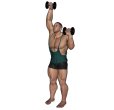 Shoulder Press - Standing Dumbbell Alternate
Shoulder Press - Standing Dumbbell Alternate
Benefits: The press is a highly effective compound upper-body exercise.
Purpose: The Military Press is a good exercise for building up and strengthening the shoulder region.
Intermediate Shoulders Triceps Chest Strength Dumbbell Push Compound Gym
General Info: The Deltoids is a fan-shaped muscle. The Anterior (Front) Deltoid raises the arm toward the front of the body and rotates the arm inward. The Lateral (Side) Deltoid raises the arm to the side. The Posterior (Rear) Deltoid raises the arm toward the rear and rotates the arm outward.
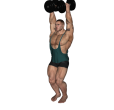 Shoulder Press - Standing Dumbbell Inwards Narrow
Shoulder Press - Standing Dumbbell Inwards Narrow
Benefits: The press is a highly effective compound upper-body exercise.
Purpose: The shoulder press is a good exercise for building up and strengthening the shoulder region.
Intermediate Shoulders Triceps Chest Strength Dumbbell Push Compound Gym
General Info: The Deltoids is a fan-shaped muscle. The Anterior (Front) Deltoid raises the arm toward the front of the body and rotates the arm inward. The Lateral (Side) Deltoid raises the arm to the side. The Posterior (Rear) Deltoid raises the arm toward the rear and rotates the arm outward.
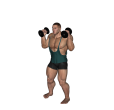 Shoulder Press - Standing Dumbbell Palms In
Shoulder Press - Standing Dumbbell Palms In
Benefits: The press is a highly effective compound upper-body exercise.
Purpose: The shoulder press is a good exercise for building up and strengthening the shoulder region.
Intermediate Shoulders Triceps Chest Strength Dumbbell Push Compound Gym
General Info: The Deltoids is a fan-shaped muscle. The Anterior (Front) Deltoid raises the arm toward the front of the body and rotates the arm inward. The Lateral (Side) Deltoid raises the arm to the side. The Posterior (Rear) Deltoid raises the arm toward the rear and rotates the arm outward.
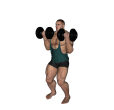 Shoulder Press - Standing Dumbbell Reverse
Shoulder Press - Standing Dumbbell Reverse
Benefits: The press is a highly effective compound upper-body exercise.
Purpose: The shoulder press is a good exercise for building up and strengthening the shoulder region.
Intermediate Shoulders Triceps Chest Strength Dumbbell Push Compound Gym
General Info: The Deltoids is a fan-shaped muscle. The Anterior (Front) Deltoid raises the arm toward the front of the body and rotates the arm inward. The Lateral (Side) Deltoid raises the arm to the side. The Posterior (Rear) Deltoid raises the arm toward the rear and rotates the arm outward.
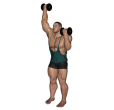 Shoulder Press - Standing Dumbbell Reverse Alternate
Shoulder Press - Standing Dumbbell Reverse Alternate
Benefits: The press is a highly effective compound upper-body exercise.
Purpose: The Military Press is a good exercise for building up and strengthening the shoulder region.
Intermediate Shoulders Triceps Chest Strength Dumbbell Push Compound Gym
General Info: The Deltoids is a fan-shaped muscle. The Anterior (Front) Deltoid raises the arm toward the front of the body and rotates the arm inward. The Lateral (Side) Deltoid raises the arm to the side. The Posterior (Rear) Deltoid raises the arm toward the rear and rotates the arm outward.
 Shoulder Press - Standing Dumbbell Single
Shoulder Press - Standing Dumbbell Single
Benefits: The press is a highly effective compound upper-body exercise.
Purpose: The Military Press is a good exercise for building up and strengthening the shoulder region.
Intermediate Shoulders Triceps Chest Strength Dumbbell Push Compound Gym
General Info: The Deltoids is a fan-shaped muscle. The Anterior (Front) Deltoid raises the arm toward the front of the body and rotates the arm inward. The Lateral (Side) Deltoid raises the arm to the side. The Posterior (Rear) Deltoid raises the arm toward the rear and rotates the arm outward.
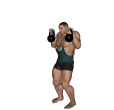 Shoulder Press - Standing Kettlebell
Shoulder Press - Standing Kettlebell
Benefits: The press is a highly effective compound upper-body exercise.
Purpose: The Military Press is a good exercise for building up and strengthening the shoulder region.
Shoulders Triceps Chest Strength Kettlebell Push Compound Gym
General Info: The Deltoids is a fan-shaped muscle. The Anterior (Front) Deltoid raises the arm toward the front of the body and rotates the arm inward. The Lateral (Side) Deltoid raises the arm to the side. The Posterior (Rear) Deltoid raises the arm toward the rear and rotates the arm outward.
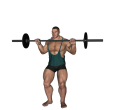 Shoulder Press - Standing Military
Shoulder Press - Standing Military
Benefits: The press is a highly effective compound upper-body exercise.
Purpose: The Military Press is a good exercise for building up and strengthening the shoulder region.
Intermediate Shoulders Triceps Chest Strength Barbell Push Compound Gym
General Info: The Deltoids is a fan-shaped muscle. The Anterior (Front) Deltoid raises the arm toward the front of the body and rotates the arm inward. The Lateral (Side) Deltoid raises the arm to the side. The Posterior (Rear) Deltoid raises the arm toward the rear and rotates the arm outward.
 Shoulder Press - Water Bottle
Shoulder Press - Water Bottle
Benefits: The press is a highly effective compound upper-body exercise.
Purpose: The Barbell Shoulder Press (sometimes called the Military Press) is a good exercise for building up and strengthening the shoulder region.
Beginner Shoulders Triceps Chest Strength Water Bottle Chair Push Compound Home
General Info: The Deltoids is a fan-shaped muscle. The Anterior (Front) Deltoid raises the arm toward the front of the body and rotates the arm inward. The Lateral (Side) Deltoid raises the arm to the side. The Posterior (Rear) Deltoid raises the arm toward the rear and rotates the arm outward.
 Shoulder Press - Water Bottle Single
Shoulder Press - Water Bottle Single
Benefits: The press is a highly effective compound upper-body exercise.
Purpose: The Barbell Shoulder Press (sometimes called the Military Press) is a good exercise for building up and strengthening the shoulder region.
Beginner Shoulders Triceps Chest Strength Water Bottle Chair Push Compound Home
General Info: The Deltoids is a fan-shaped muscle. The Anterior (Front) Deltoid raises the arm toward the front of the body and rotates the arm inward. The Lateral (Side) Deltoid raises the arm to the side. The Posterior (Rear) Deltoid raises the arm toward the rear and rotates the arm outward.
 Snatch - Balance
Snatch - Balance
Benefits: The press is a highly effective compound upper-body exercise.
Purpose: This exercise is a good exercise for building up and strengthening the shoulder region.
Intermediate Shoulders Triceps Traps Glutes Hamstrings Quads Strength Barbell Push Compound Gym
General Info: The Deltoids is a fan-shaped muscle. The Anterior (Front) Deltoid raises the arm toward the front of the body and rotates the arm inward. The Lateral (Side) Deltoid raises the arm to the side. The Posterior (Rear) Deltoid raises the arm toward the rear and rotates the arm outward.
 Snatch - Basic
Snatch - Basic
Benefits: The press is a highly effective compound upper-body exercise.
Purpose: This exercise is a good exercise for building up and strengthening the shoulder region.
Intermediate Shoulders Triceps Traps Strength Barbell Push Compound Gym
General Info: The Deltoids is a fan-shaped muscle. The Anterior (Front) Deltoid raises the arm toward the front of the body and rotates the arm inward. The Lateral (Side) Deltoid raises the arm to the side. The Posterior (Rear) Deltoid raises the arm toward the rear and rotates the arm outward.
 Snatch - From Blocks
Snatch - From Blocks
Benefits: The press is a highly effective compound upper-body exercise.
Purpose: This exercise is a good exercise for building up and strengthening the shoulder region.
Intermediate Shoulders Triceps Traps Strength Barbell Push Compound Gym
General Info: The Deltoids is a fan-shaped muscle. The Anterior (Front) Deltoid raises the arm toward the front of the body and rotates the arm inward. The Lateral (Side) Deltoid raises the arm to the side. The Posterior (Rear) Deltoid raises the arm toward the rear and rotates the arm outward.
 Snatch - Split
Snatch - Split
Benefits: The press is a highly effective compound upper-body exercise.
Purpose: This exercise is a good exercise for building up and strengthening the shoulder region.
Intermediate Shoulders Triceps Traps Strength Barbell Push Compound Gym
General Info: The Deltoids is a fan-shaped muscle. The Anterior (Front) Deltoid raises the arm toward the front of the body and rotates the arm inward. The Lateral (Side) Deltoid raises the arm to the side. The Posterior (Rear) Deltoid raises the arm toward the rear and rotates the arm outward.
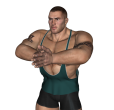 Squeeze - Iso Chest
Squeeze - Iso Chest
Benefits: This exercise contracts the chest muscles.
Purpose: This exercise is used to contract the chest muscles using isometrics.
Beginner Chest Triceps Anterior Shoulders Body Only Gym Home
General Info: The chest is composed of the Pectoralis Major and the Pectoralis Minor. The Pec Major attaches to the upper arm and pulls the upper arm across the chest. The Pec Minor lies mostly underneath the Pec Major and draws the shoulder blade down and forward.
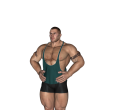 Stretch - Overhead
Stretch - Overhead
Benefits: This exercise is good after sitting at a desk or computer for any extended time. It is also good both before and after resistance exercising.
Purpose: This exercise loosens up and stretches the shoulder muscles. It also relieves tension in the chest and lats.
Intermediate Shoulders Chest Forearms Lats Triceps Stretching Body Only Gym Home
General Info: The shoulder muscles are a group of three muscles. The anterior (front) deltoid raises the arm toward the front and rotates the arm inward. The lateral (side) deltoid raises the arm to the side. The posterior (back) deltoid raises the arm toward the rear and rotates the arm outward.
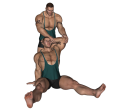 Stretch - Overhead Lat
Stretch - Overhead Lat
Benefits: This exercise is an effective for flexibility of the lats.
Purpose: This is a good exercise for flexibility in the upper back.
Lats Triceps Stretching Body Only Gym Home
General Info: There are a number of muscles in the back, although the two major muscles are the lats and traps. The lats pulls the arm back and down towards the spine. The traps pull the shoulder blades back and towards the spine.
 Stretch - Overhead Triceps
Stretch - Overhead Triceps
Benefits: This exercise works all heads of the triceps.
Purpose: This exercise is used to target the triceps muscle to develop size, definition, strength, endurance and power.
Triceps Lats Stretching Body Only Gym
General Info: The triceps muscles are straight muscles with three heads. All three heads straighten the elbow while the long head, crossing the shoulder joint also adducts the shoulder (pulls it down from the side) and extends the shoulder (pulls it down from the front).
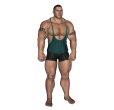 Stretch - Triceps
Stretch - Triceps
Benefits: This exercise helps to relax the triceps.
Purpose: This exercise focuses on stretching the three heads of the triceps and makes an excellent warm-up before any resistance or weight training involving the triceps.
Beginner Triceps Lats Stretching Body Only Gym Home
General Info: The triceps muscles are straight muscles with three heads. All three heads straighten the elbow while the long head, crossing the shoulder joint also adducts the shoulder (pulls it down from the side) and extends the shoulder (pulls it down from the front).
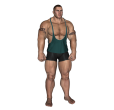 Stretch - Triceps Side
Stretch - Triceps Side
Benefits: This exercise helps to relax the triceps.
Purpose: This exercise focuses on stretching the three heads of the triceps and makes an excellent warm-up before any resistance or weight training involving the triceps.
Beginner Triceps Shoulders Stretching Body Only Gym Home
General Info: The triceps muscles are straight muscles with three heads. All three heads straighten the elbow while the long head, crossing the shoulder joint also adducts the shoulder (pulls it down from the side) and extends the shoulder (pulls it down from the front).
 Tire Flip - Basic
Tire Flip - Basic
Benefits: This exorcist will focus on the thighs, especially the quads.
Purpose: To prepare you for the tire flip portion of a strongman competition.
Quads Triceps Strength Tire Push Compound Gym
General Info: The quads are a set of four muscles in the upper front thigh. All four muscles work to straighten the knee. One of the four (rectus femoris) also helps to bend the hip. Squats are considered a vital exercise for increasing the strength and size of the legs and butt.
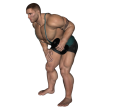 Triceps Extension - Bent Over Dumbbell Single
Triceps Extension - Bent Over Dumbbell Single
Benefits: This exercise works all heads of the triceps.
Purpose: This exercise is used to target the triceps muscle to develop size, definition, strength, endurance and power.
Beginner Triceps Strength Dumbbell Push Gym
General Info: The triceps muscles are straight muscles with three heads. All three heads straighten the elbow while the long head, crossing the shoulder joint also adducts the shoulder (pulls it down from the side) and extends the shoulder (pulls it down from the front).
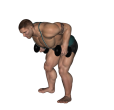 Triceps Extension - Bent Over Two Arm Dumbbell
Triceps Extension - Bent Over Two Arm Dumbbell
Benefits: This exercise works all heads of the triceps.
Purpose: This exercise is used to target the triceps muscle to develop size, definition, strength, endurance and power.
Beginner Triceps Strength Dumbbell Push Gym
General Info: The triceps muscles are straight muscles with three heads. All three heads straighten the elbow while the long head, crossing the shoulder joint also adducts the shoulder (pulls it down from the side) and extends the shoulder (pulls it down from the front).
 Triceps Extension - Bent Over Two Arm Water Bottle
Triceps Extension - Bent Over Two Arm Water Bottle
Benefits: This exercise works all heads of the triceps.
Purpose: This exercise is used to target the triceps muscle to develop size, definition, strength, endurance and power.
Beginner Triceps Strength Water Bottle Push Home
General Info: The triceps muscles are straight muscles with three heads. All three heads straighten the elbow while the long head, crossing the shoulder joint also adducts the shoulder (pulls it down from the side) and extends the shoulder (pulls it down from the front).
 Triceps Extension - Bent Over Water Bottle Single
Triceps Extension - Bent Over Water Bottle Single
Benefits: This exercise works all heads of the triceps.
Purpose: This exercise is used to target the triceps muscle to develop size, definition, strength, endurance and power.
Beginner Triceps Strength Water Bottle Push Home
General Info: The triceps muscles are straight muscles with three heads. All three heads straighten the elbow while the long head, crossing the shoulder joint also adducts the shoulder (pulls it down from the side) and extends the shoulder (pulls it down from the front).
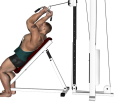 Triceps Extension - Cable Incline
Triceps Extension - Cable Incline
Benefits: This exercise works all heads of the triceps.
Purpose: This exercise is used to target the triceps muscle to develop size, definition, strength, endurance and power.
Beginner Triceps Strength High Low Cable Machine Incline Bench Push Gym
General Info: The triceps muscles are straight muscles with three heads. All three heads straighten the elbow while the long head, crossing the shoulder joint also adducts the shoulder (pulls it down from the side) and extends the shoulder (pulls it down from the front).
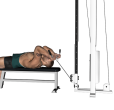 Triceps Extension - Cable Lying
Triceps Extension - Cable Lying
Benefits: This exercise works all heads of the triceps.
Purpose: This exercise is used to target the triceps muscle to develop size, definition, strength, endurance and power.
Beginner Triceps Strength High Low Cable Machine Flat Bench Push Gym
General Info: The triceps muscles are straight muscles with three heads. All three heads straighten the elbow while the long head, crossing the shoulder joint also adducts the shoulder (pulls it down from the side) and extends the shoulder (pulls it down from the front).
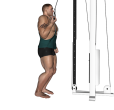 Triceps Extension - Cable One Arm Supinated
Triceps Extension - Cable One Arm Supinated
Benefits: This exercise works all heads of the triceps. The cable keeps tension on the muscle throughout the range of motion.
Purpose: This exercise is used to target the triceps muscle to develop size, definition, strength, endurance and power.
Beginner Triceps Strength High Low Cable Machine Pull Gym
General Info: The triceps muscles are straight muscles with three heads. All three heads straighten the elbow while the long head, crossing the shoulder joint also adducts the shoulder (pulls it down from the side) and extends the shoulder (pulls it down from the front).
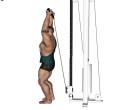 Triceps Extension - Cable Rope Overhead
Triceps Extension - Cable Rope Overhead
Benefits: This exercise works all heads of the triceps.
Purpose: This exercise is used to target the triceps muscle to develop size, definition, strength, endurance and power.
Beginner Triceps Strength Cable Machine Cable Rope Attachment Push Gym
General Info: The triceps muscles are straight muscles with three heads. All three heads straighten the elbow while the long head, crossing the shoulder joint also adducts the shoulder (pulls it down from the side) and extends the shoulder (pulls it down from the front).
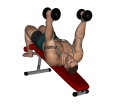 Triceps Extension - Decline Dumbbell
Triceps Extension - Decline Dumbbell
Benefits: This exercise works all heads of the triceps.
Purpose: This exercise is used to target the triceps muscle to develop size, definition, strength, endurance and power.
Beginner Triceps Strength Dumbbell Decline Bench Push Gym
General Info: The triceps muscles are straight muscles with three heads. All three heads straighten the elbow while the long head, crossing the shoulder joint also adducts the shoulder (pulls it down from the side) and extends the shoulder (pulls it down from the front).
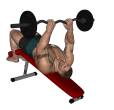 Triceps Extension - Decline EZ Bar
Triceps Extension - Decline EZ Bar
Benefits: This exercise works all heads of the triceps.
Purpose: This exercise is used to target the triceps muscle to develop size, definition, strength, endurance and power.
Beginner Triceps Strength EZ Bar Decline Bench Push Gym
General Info: The triceps muscles are straight muscles with three heads. All three heads straighten the elbow while the long head, crossing the shoulder joint also adducts the shoulder (pulls it down from the side) and extends the shoulder (pulls it down from the front).
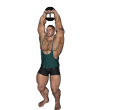 Triceps Extension - Dumbbell 2 Handed
Triceps Extension - Dumbbell 2 Handed
Benefits: This exercise works all heads of the triceps.
Purpose: This exercise is used to target the triceps muscle to develop size, definition, strength, endurance and power.
Beginner Triceps Strength Dumbbell Push Gym
General Info: The triceps muscle group are straight muscles with three heads. All three heads straighten the elbow while the long head, crossing the shoulder joint also adducts the shoulder (pulls it down from the side) and extends the shoulder (pulls it down from the front).
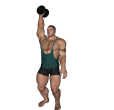 Triceps Extension - Dumbbell Single
Triceps Extension - Dumbbell Single
Benefits: This exercise works all heads of the triceps.
Purpose: This exercise is used to target the triceps muscle to develop size, definition, strength, endurance and power.
Beginner Triceps Strength Dumbbell Push Gym
General Info: The triceps muscle group are straight muscles with three heads. All three heads straighten the elbow while the long head, crossing the shoulder joint also adducts the shoulder (pulls it down from the side) and extends the shoulder (pulls it down from the front).
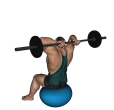 Triceps Extension - Fit Ball Reverse Barbell Close
Triceps Extension - Fit Ball Reverse Barbell Close
Benefits: The exercise eliminates isolates the triceps.
Purpose: This exercise works primarily the triceps.
Beginner Triceps Strength Barbell Fitness Ball Push Gym
General Info: The triceps is a straight muscle with three heads. The long head straightens the elbow, adducts the shoulder (brings it from a side position to the body) and extends the shoulder (brings the arm from a front position down to the body). The lateral head (outer head) straightens the elbow. The medial head also straightens the elbow.
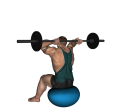 Triceps Extension - Fitness Ball Barbell
Triceps Extension - Fitness Ball Barbell
Benefits: This exercise works all heads of the triceps.
Purpose: This exercise is used to target the triceps muscle to develop size, definition, strength, endurance and power.
Beginner Triceps Strength Barbell Fitness Ball Push Gym
General Info: The triceps muscles are straight muscles with three heads. All three heads straighten the elbow while the long head, crossing the shoulder joint also adducts the shoulder (pulls it down from the side) and extends the shoulder (pulls it down from the front).
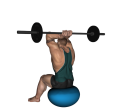 Triceps Extension - Fitness Ball Barbell Close Grip
Triceps Extension - Fitness Ball Barbell Close Grip
Benefits: This exercise works all heads of the triceps.
Purpose: This exercise is used to target the triceps muscle to develop size, definition, strength, endurance and power.
Beginner Triceps Strength Barbell Fitness Ball Push Gym
General Info: The triceps muscles are straight muscles with three heads. All three heads straighten the elbow while the long head, crossing the shoulder joint also adducts the shoulder (pulls it down from the side) and extends the shoulder (pulls it down from the front).
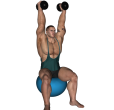 Triceps Extension - Fitness Ball Dumbbell
Triceps Extension - Fitness Ball Dumbbell
Benefits: This exercise works all heads of the triceps.
Purpose: This exercise is used to target the triceps muscle to develop size, definition, strength, endurance and power.
Beginner Triceps Strength Dumbbell Fitness Ball Push Gym
General Info: The triceps muscles are straight muscles with three heads. All three heads straighten the elbow while the long head, crossing the shoulder joint also adducts the shoulder (pulls it down from the side) and extends the shoulder (pulls it down from the front).
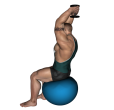 Triceps Extension - Fitness Ball Dumbbell 2 Handed
Triceps Extension - Fitness Ball Dumbbell 2 Handed
Benefits: This exercise works all heads of the triceps.
Purpose: This exercise is used to target the triceps muscle to develop size, definition, strength, endurance and power.
Beginner Triceps Strength Dumbbell Fitness Ball Push Gym
General Info: The triceps muscle group are straight muscles with three heads. All three heads straighten the elbow while the long head, crossing the shoulder joint also adducts the shoulder (pulls it down from the side) and extends the shoulder (pulls it down from the front).
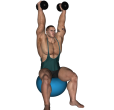 Triceps Extension - Fitness Ball Dumbbell Alternate
Triceps Extension - Fitness Ball Dumbbell Alternate
Benefits: This exercise works all heads of the triceps.
Purpose: This exercise is used to target the triceps muscle to develop size, definition, strength, endurance and power.
Beginner Triceps Strength Dumbbell Fitness Ball Push Gym
General Info: The triceps muscle group are straight muscles with three heads. All three heads straighten the elbow while the long head, crossing the shoulder joint also adducts the shoulder (pulls it down from the side) and extends the shoulder (pulls it down from the front).
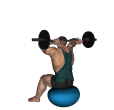 Triceps Extension - Fitness Ball EZ Bar
Triceps Extension - Fitness Ball EZ Bar
Benefits: This exercise works all heads of the triceps.
Purpose: This exercise is used to target the triceps muscle to develop size, definition, strength, endurance and power.
Beginner Triceps Strength EZ Bar Fitness Ball Push Gym
General Info: The triceps muscles are straight muscles with three heads. All three heads straighten the elbow while the long head, crossing the shoulder joint also adducts the shoulder (pulls it down from the side) and extends the shoulder (pulls it down from the front).
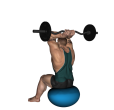 Triceps Extension - Fitness Ball EZ Bar Close Grip
Triceps Extension - Fitness Ball EZ Bar Close Grip
Benefits: This exercise works all heads of the triceps.
Purpose: This exercise is used to target the triceps muscle to develop size, definition, strength, endurance and power.
Beginner Triceps Strength EZ Bar Fitness Ball Push Gym
General Info: The triceps muscles are straight muscles with three heads. All three heads straighten the elbow while the long head, crossing the shoulder joint also adducts the shoulder (pulls it down from the side) and extends the shoulder (pulls it down from the front).
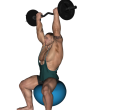 Triceps Extension - Fitness Ball EZ Bar Reverse
Triceps Extension - Fitness Ball EZ Bar Reverse
Benefits: The exercise eliminates isolates the triceps.
Purpose: This exercise works primarily the triceps.
Beginner Triceps Strength EZ Bar Fitness Ball Push Gym
General Info: The triceps is a straight muscle with three heads. The long head straightens the elbow, adducts the shoulder (brings it from a side position to the body) and extends the shoulder (brings the arm from a front position down to the body). The lateral head (outer head) straightens the elbow. The medial head also straightens the elbow.
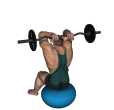 Triceps Extension - Fitness Ball EZ Reverse Close
Triceps Extension - Fitness Ball EZ Reverse Close
Benefits: The exercise eliminates isolates the triceps.
Purpose: This exercise works primarily the triceps.
Beginner Triceps Strength EZ Bar Fitness Ball Push Gym
General Info: The triceps is a straight muscle with three heads. The long head straightens the elbow, adducts the shoulder (brings it from a side position to the body) and extends the shoulder (brings the arm from a front position down to the body). The lateral head (outer head) straightens the elbow. The medial head also straightens the elbow.
 Triceps Extension - Fitness Ball Plate
Triceps Extension - Fitness Ball Plate
Benefits: This exercise works all heads of the triceps.
Purpose: This exercise is used to target the triceps muscle to develop size, definition, strength, endurance and power.
Beginner Triceps Strength Plate Fitness Ball Push Gym
General Info: The triceps muscles are straight muscles with three heads. All three heads straighten the elbow while the long head, crossing the shoulder joint also adducts the shoulder (pulls it down from the side) and extends the shoulder (pulls it down from the front).
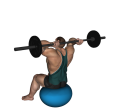 Triceps Extension - Fitness Ball Reverse Barbell
Triceps Extension - Fitness Ball Reverse Barbell
Benefits: The exercise eliminates isolates the triceps.
Purpose: This exercise works primarily the triceps.
Beginner Triceps Strength Barbell Fitness Ball Push Gym
General Info: The triceps is a straight muscle with three heads. The long head straightens the elbow, adducts the shoulder (brings it from a side position to the body) and extends the shoulder (brings the arm from a front position down to the body). The lateral head (outer head) straightens the elbow. The medial head also straightens the elbow.
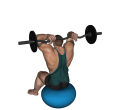 Triceps Extension - Fitness Ball Reverse EZ Bar
Triceps Extension - Fitness Ball Reverse EZ Bar
Benefits: The exercise eliminates isolates the triceps.
Purpose: This exercise works primarily the triceps.
Beginner Triceps Strength EZ Bar Fitness Ball Push Gym
General Info: The triceps is a straight muscle with three heads. The long head straightens the elbow, adducts the shoulder (brings it from a side position to the body) and extends the shoulder (brings the arm from a front position down to the body). The lateral head (outer head) straightens the elbow. The medial head also straightens the elbow.
 Triceps Extension - Fitness Ball Single Dumbbell
Triceps Extension - Fitness Ball Single Dumbbell
Benefits: This exercise works all heads of the triceps.
Purpose: This exercise is used to target the triceps muscle to develop size, definition, strength, endurance and power.
Beginner Triceps Strength Dumbbell Fitness Ball Push Gym
General Info: The triceps muscle group are straight muscles with three heads. All three heads straighten the elbow while the long head, crossing the shoulder joint also adducts the shoulder (pulls it down from the side) and extends the shoulder (pulls it down from the front).
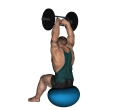 Triceps Extension - Fitness Ball Tricep Barbell
Triceps Extension - Fitness Ball Tricep Barbell
Benefits: This exercise works all heads of the triceps.
Purpose: This exercise is used to target the triceps muscle to develop size, definition, strength, endurance and power.
Beginner Triceps Strength Tricep Barbell Fitness Ball Push Gym
General Info: The triceps muscles are straight muscles with three heads. All three heads straighten the elbow while the long head, crossing the shoulder joint also adducts the shoulder (pulls it down from the side) and extends the shoulder (pulls it down from the front).
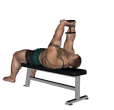 Triceps Extension - Flat Bench Dumbbell 2 Handed
Triceps Extension - Flat Bench Dumbbell 2 Handed
Benefits: This exercise works all heads of the triceps.
Purpose: This exercise is used to target the triceps muscle to develop size, definition, strength, endurance and power.
Beginner Triceps Strength Dumbbell Flat Bench Push Gym
General Info: The triceps muscles are straight muscles with three heads. All three heads straighten the elbow while the long head, crossing the shoulder joint also adducts the shoulder (pulls it down from the side) and extends the shoulder (pulls it down from the front).
 Triceps Extension - Flat Single Dumbbell
Triceps Extension - Flat Single Dumbbell
Benefits: This exercise works all heads of the triceps.
Purpose: This exercise is used to target the triceps muscle to develop size, definition, strength, endurance and power.
Beginner Triceps Strength Dumbbell Flat Bench Push Gym
General Info: The triceps muscle group are straight muscles with three heads. All three heads straighten the elbow while the long head, crossing the shoulder joint also adducts the shoulder (pulls it down from the side) and extends the shoulder (pulls it down from the front).
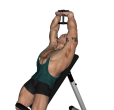 Triceps Extension - Incline 2 Handed Dumbbell
Triceps Extension - Incline 2 Handed Dumbbell
Benefits: This exercise works all heads of the triceps.
Purpose: This exercise is used to target the triceps muscle to develop size, definition, strength, endurance and power.
Beginner Triceps Strength Dumbbell Incline Bench Push Gym
General Info: The triceps muscle group are straight muscles with three heads. All three heads straighten the elbow while the long head, crossing the shoulder joint also adducts the shoulder (pulls it down from the side) and extends the shoulder (pulls it down from the front).
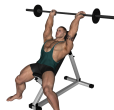 Triceps Extension - Incline Barbell
Triceps Extension - Incline Barbell
Benefits: The exercise eliminates isolates the triceps.
Purpose: This exercise works primarily the triceps.
Beginner Triceps Strength Barbell Incline Bench Pull Gym
General Info: The triceps is a straight muscle with three heads. The long head straightens the elbow, adducts the shoulder (brings it from a side position to the body) and extends the shoulder (brings the arm from a front position down to the body). The lateral head (outer head) straightens the elbow. The medial head also straightens the elbow.
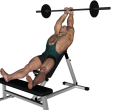 Triceps Extension - Incline Barbell Close Feet Up
Triceps Extension - Incline Barbell Close Feet Up
Benefits: The exercise eliminates isolates the triceps.
Purpose: This exercise works primarily the triceps.
Beginner Triceps Strength Barbell Incline Bench Pull Gym
General Info: The triceps is a straight muscle with three heads. The long head straightens the elbow, adducts the shoulder (brings it from a side position to the body) and extends the shoulder (brings the arm from a front position down to the body). The lateral head (outer head) straightens the elbow. The medial head also straightens the elbow.
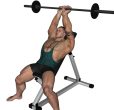 Triceps Extension - Incline Barbell Close Grip
Triceps Extension - Incline Barbell Close Grip
Benefits: The exercise eliminates isolates the triceps.
Purpose: This exercise works primarily the triceps.
Beginner Triceps Strength Barbell Incline Bench Pull Gym
General Info: The triceps is a straight muscle with three heads. The long head straightens the elbow, adducts the shoulder (brings it from a side position to the body) and extends the shoulder (brings the arm from a front position down to the body). The lateral head (outer head) straightens the elbow. The medial head also straightens the elbow.
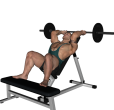 Triceps Extension - Incline Barbell Feet Up
Triceps Extension - Incline Barbell Feet Up
Benefits: The exercise eliminates isolates the triceps.
Purpose: This exercise works primarily the triceps.
Beginner Triceps Strength Barbell Incline Bench Pull Gym
General Info: The triceps is a straight muscle with three heads. The long head straightens the elbow, adducts the shoulder (brings it from a side position to the body) and extends the shoulder (brings the arm from a front position down to the body). The lateral head (outer head) straightens the elbow. The medial head also straightens the elbow.
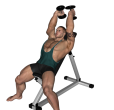 Triceps Extension - Incline Dumbbell
Triceps Extension - Incline Dumbbell
Benefits: The exercise eliminates isolates the triceps.
Purpose: This exercise works primarily the triceps.
Beginner Triceps Strength Dumbbell Incline Bench Pull Gym
General Info: The triceps is a straight muscle with three heads. The long head straightens the elbow, adducts the shoulder (brings it from a side position to the body) and extends the shoulder (brings the arm from a front position down to the body). The lateral head (outer head) straightens the elbow. The medial head also straightens the elbow.
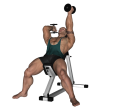 Triceps Extension - Incline Dumbbell Alternate
Triceps Extension - Incline Dumbbell Alternate
Benefits: The exercise eliminates isolates the triceps.
Purpose: This exercise works primarily the triceps.
Beginner Triceps Strength Dumbbell Incline Bench Pull Gym
General Info: The triceps is a straight muscle with three heads. The long head straightens the elbow, adducts the shoulder (brings it from a side position to the body) and extends the shoulder (brings the arm from a front position down to the body). The lateral head (outer head) straightens the elbow. The medial head also straightens the elbow.
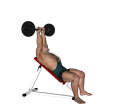 Triceps Extension - Incline EZ Bar
Triceps Extension - Incline EZ Bar
Benefits: This exercise works all heads of the triceps.
Purpose: This exercise is used to target the triceps muscle to develop size, definition, strength, endurance and power.
Beginner Triceps Strength EZ Bar Incline Bench Push Gym
General Info: The triceps muscles are straight muscles with three heads. All three heads straighten the elbow while the long head, crossing the shoulder joint also adducts the shoulder (pulls it down from the side) and extends the shoulder (pulls it down from the front).
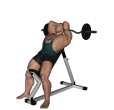 Triceps Extension - Incline EZ Bar Close Grip
Triceps Extension - Incline EZ Bar Close Grip
Benefits: This exercise works all heads of the triceps.
Purpose: This exercise is used to target the triceps muscle to develop size, definition, strength, endurance and power.
Beginner Triceps Strength EZ Bar Incline Bench Push Gym
General Info: The triceps muscles are straight muscles with three heads. All three heads straighten the elbow while the long head, crossing the shoulder joint also adducts the shoulder (pulls it down from the side) and extends the shoulder (pulls it down from the front).
 Triceps Extension - Incline Plate
Triceps Extension - Incline Plate
Benefits: The exercise eliminates isolates the triceps.
Purpose: This exercise works primarily the triceps.
Beginner Triceps Strength Plate Incline Bench Pull Gym
General Info: The triceps is a straight muscle with three heads. The long head straightens the elbow, adducts the shoulder (brings it from a side position to the body) and extends the shoulder (brings the arm from a front position down to the body). The lateral head (outer head) straightens the elbow. The medial head also straightens the elbow.
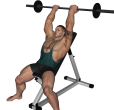 Triceps Extension - Incline Reverse Barbell
Triceps Extension - Incline Reverse Barbell
Benefits: The exercise eliminates isolates the triceps.
Purpose: This exercise works primarily the triceps.
Beginner Triceps Strength Barbell Incline Bench Pull Gym
General Info: The triceps is a straight muscle with three heads. The long head straightens the elbow, adducts the shoulder (brings it from a side position to the body) and extends the shoulder (brings the arm from a front position down to the body). The lateral head (outer head) straightens the elbow. The medial head also straightens the elbow.
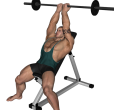 Triceps Extension - Incline Reverse Barbell Close Grip
Triceps Extension - Incline Reverse Barbell Close Grip
Benefits: The exercise eliminates isolates the triceps.
Purpose: This exercise works primarily the triceps.
Beginner Triceps Strength Barbell Incline Bench Pull Gym
General Info: The triceps is a straight muscle with three heads. The long head straightens the elbow, adducts the shoulder (brings it from a side position to the body) and extends the shoulder (brings the arm from a front position down to the body). The lateral head (outer head) straightens the elbow. The medial head also straightens the elbow.
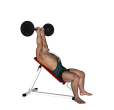 Triceps Extension - Incline Reverse EZ Bar
Triceps Extension - Incline Reverse EZ Bar
Benefits: The exercise eliminates isolates the triceps.
Purpose: This exercise works primarily the triceps.
Beginner Triceps Strength EZ Bar Incline Bench Pull Gym
General Info: The triceps is a straight muscle with three heads. The long head straightens the elbow, adducts the shoulder (brings it from a side position to the body) and extends the shoulder (brings the arm from a front position down to the body). The lateral head (outer head) straightens the elbow. The medial head also straightens the elbow.
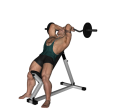 Triceps Extension - Incline Reverse EZ Bar Close Grip
Triceps Extension - Incline Reverse EZ Bar Close Grip
Benefits: The exercise eliminates isolates the triceps.
Purpose: This exercise works primarily the triceps.
Beginner Triceps Strength EZ Bar Incline Bench Pull Gym
General Info: The triceps is a straight muscle with three heads. The long head straightens the elbow, adducts the shoulder (brings it from a side position to the body) and extends the shoulder (brings the arm from a front position down to the body). The lateral head (outer head) straightens the elbow. The medial head also straightens the elbow.
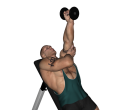 Triceps Extension - Incline Single Dumbbell
Triceps Extension - Incline Single Dumbbell
Benefits: This exercise works all heads of the triceps.
Purpose: This exercise is used to target the triceps muscle to develop size, definition, strength, endurance and power.
Beginner Triceps Strength Dumbbell Incline Bench Push Gym
General Info: The triceps muscle group are straight muscles with three heads. All three heads straighten the elbow while the long head, crossing the shoulder joint also adducts the shoulder (pulls it down from the side) and extends the shoulder (pulls it down from the front).
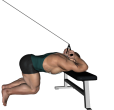 Triceps Extension - Kneeling Cable
Triceps Extension - Kneeling Cable
Benefits: This exercise works all heads of the triceps. The cable keeps tension on the muscles throughout the range of motion.
Purpose: This exercise is used to target the triceps muscle to develop size, definition, strength, endurance and power.
Beginner Triceps Strength Cable Machine Cable Rope Attachment Push Gym
General Info: The triceps muscles are straight muscles with three heads. All three heads straighten the elbow while the long head, crossing the shoulder joint also adducts the shoulder (pulls it down from the side) and extends the shoulder (pulls it down from the front).
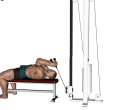 Triceps Extension - Low Cable
Triceps Extension - Low Cable
Benefits: This exercise works all heads of the triceps.
Purpose: This exercise is used to target the triceps muscle to develop size, definition, strength, endurance and power.
Beginner Triceps Strength Cable Machine Cable Rope Attachment Flat Bench Push Gym
General Info: The triceps muscles are straight muscles with three heads. All three heads straighten the elbow while the long head, crossing the shoulder joint also adducts the shoulder (pulls it down from the side) and extends the shoulder (pulls it down from the front).
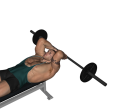 Triceps Extension - Lying Close Grip Bar Behind Head
Triceps Extension - Lying Close Grip Bar Behind Head
Benefits: The exercise eliminates isolates the triceps.
Purpose: This exercise works primarily the triceps.
Beginner Triceps Strength Barbell Flat Bench Pull Gym
General Info: The triceps is a straight muscle with three heads. The long head straightens the elbow, adducts the shoulder (brings it from a side position to the body) and extends the shoulder (brings the arm from a front position down to the body). The lateral head (outer head) straightens the elbow. The medial head also straightens the elbow.
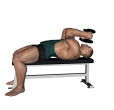 Triceps Extension - Lying Dumbbell
Triceps Extension - Lying Dumbbell
Benefits: This exercise works all heads of the triceps.
Purpose: This exercise is used to target the triceps muscle to develop size, definition, strength, endurance and power.
Beginner Triceps Strength Dumbbell Flat Bench Push Gym
General Info: The triceps muscles are straight muscles with three heads. All three heads straighten the elbow while the long head, crossing the shoulder joint also adducts the shoulder (pulls it down from the side) and extends the shoulder (pulls it down from the front).
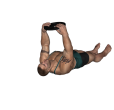 Triceps Extension - Lying Floor Plate
Triceps Extension - Lying Floor Plate
Benefits: The exercise eliminates isolates the triceps.
Purpose: This exercise works primarily the triceps.
Beginner Triceps Strength Plate Push Gym
General Info: The triceps is a straight muscle with three heads. The long head straightens the elbow, adducts the shoulder (brings it from a side position to the body) and extends the shoulder (brings the arm from a front position down to the body). The lateral head (outer head) straightens the elbow. The medial head also straightens the elbow.
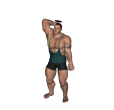 Triceps Extension - One Arm Dumbbell
Triceps Extension - One Arm Dumbbell
Benefits: This exercise works all heads of the triceps.
Purpose: This exercise is used to target the triceps muscle to develop size, definition, strength, endurance and power.
Beginner Triceps Strength Dumbbell Push Gym
General Info: The triceps muscle group are straight muscles with three heads. All three heads straighten the elbow while the long head, crossing the shoulder joint also adducts the shoulder (pulls it down from the side) and extends the shoulder (pulls it down from the front).
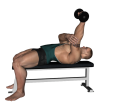 Triceps Extension - One Arm Pronated Dumbbell
Triceps Extension - One Arm Pronated Dumbbell
Benefits: This exercise works all heads of the triceps.
Purpose: This exercise is used to target the triceps muscle to develop size, definition, strength, endurance and power.
Beginner Triceps Strength Dumbbell Flat Bench Push Gym
General Info: The triceps muscles are straight muscles with three heads. All three heads straighten the elbow while the long head, crossing the shoulder joint also adducts the shoulder (pulls it down from the side) and extends the shoulder (pulls it down from the front).
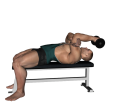 Triceps Extension - One Arm Supinated Dumbbell
Triceps Extension - One Arm Supinated Dumbbell
Benefits: This exercise works all heads of the triceps.
Purpose: This exercise is used to target the triceps muscle to develop size, definition, strength, endurance and power.
Beginner Triceps Strength Dumbbell Flat Bench Push Gym
General Info: The triceps muscle group are straight muscles with three heads. All three heads straighten the elbow while the long head, crossing the shoulder joint also adducts the shoulder (pulls it down from the side) and extends the shoulder (pulls it down from the front).
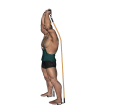 Triceps Extension - Resistance Tube
Triceps Extension - Resistance Tube
Benefits: This exercise works all heads of the triceps.
Purpose: This exercise is used to target the triceps muscle to develop size, definition, strength, endurance and power.
Beginner Triceps Strength Resistance Tube Push Gym
General Info: The triceps muscle group are straight muscles with three heads. All three heads straighten the elbow while the long head, crossing the shoulder joint also adducts the shoulder (pulls it down from the side) and extends the shoulder (pulls it down from the front).
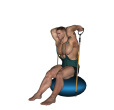 Triceps Extension - Resistance Tube Ball
Triceps Extension - Resistance Tube Ball
Benefits: This exercise works all heads of the triceps.
Purpose: This exercise is used to target the triceps muscle to develop size, definition, strength, endurance and power.
Beginner Triceps Strength Resistance Tube Fitness Ball Push Gym
General Info: The triceps muscle group are straight muscles with three heads. All three heads straighten the elbow while the long head, crossing the shoulder joint also adducts the shoulder (pulls it down from the side) and extends the shoulder (pulls it down from the front).
 Triceps Extension - Resistance Tube Ball Reverse
Triceps Extension - Resistance Tube Ball Reverse
Benefits: This exercise works all heads of the triceps.
Purpose: This exercise is used to target the triceps muscle to develop size, definition, strength, endurance and power.
Beginner Triceps Strength Resistance Tube Fitness Ball Push Gym
General Info: The triceps muscle group are straight muscles with three heads. All three heads straighten the elbow while the long head, crossing the shoulder joint also adducts the shoulder (pulls it down from the side) and extends the shoulder (pulls it down from the front).
 Triceps Extension - Resistance Tube Ball Single
Triceps Extension - Resistance Tube Ball Single
Benefits: This exercise works all heads of the triceps.
Purpose: This exercise is used to target the triceps muscle to develop size, definition, strength, endurance and power.
Beginner Triceps Strength Resistance Tube Fitness Ball Push Gym
General Info: The triceps muscle group are straight muscles with three heads. All three heads straighten the elbow while the long head, crossing the shoulder joint also adducts the shoulder (pulls it down from the side) and extends the shoulder (pulls it down from the front).
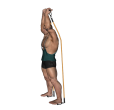 Triceps Extension - Resistance Tube Reverse
Triceps Extension - Resistance Tube Reverse
Benefits: This exercise works all heads of the triceps.
Purpose: This exercise is used to target the triceps muscle to develop size, definition, strength, endurance and power.
Beginner Triceps Strength Resistance Tube Push Gym
General Info: The triceps muscle group are straight muscles with three heads. All three heads straighten the elbow while the long head, crossing the shoulder joint also adducts the shoulder (pulls it down from the side) and extends the shoulder (pulls it down from the front).
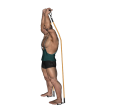 Triceps Extension - Resistance Tube Reverse Alternate
Triceps Extension - Resistance Tube Reverse Alternate
Benefits: This exercise works all heads of the triceps.
Purpose: This exercise is used to target the triceps muscle to develop size, definition, strength, endurance and power.
Beginner Triceps Strength Resistance Tube Push Gym
General Info: The triceps muscle group are straight muscles with three heads. All three heads straighten the elbow while the long head, crossing the shoulder joint also adducts the shoulder (pulls it down from the side) and extends the shoulder (pulls it down from the front).
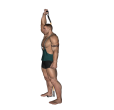 Triceps Extension - Resistance Tube Single
Triceps Extension - Resistance Tube Single
Benefits: This exercise works all heads of the triceps.
Purpose: This exercise is used to target the triceps muscle to develop size, definition, strength, endurance and power.
Beginner Triceps Strength Resistance Tube Push Gym
General Info: The triceps muscle group are straight muscles with three heads. All three heads straighten the elbow while the long head, crossing the shoulder joint also adducts the shoulder (pulls it down from the side) and extends the shoulder (pulls it down from the front).
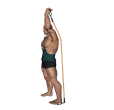 Triceps Extension - Resistance Tube Single Reverse
Triceps Extension - Resistance Tube Single Reverse
Benefits: This exercise works all heads of the triceps.
Purpose: This exercise is used to target the triceps muscle to develop size, definition, strength, endurance and power.
Beginner Triceps Strength Resistance Tube Push Gym
General Info: The triceps muscle group are straight muscles with three heads. All three heads straighten the elbow while the long head, crossing the shoulder joint also adducts the shoulder (pulls it down from the side) and extends the shoulder (pulls it down from the front).
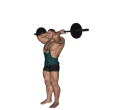 Triceps Extension - Reverse Barbell
Triceps Extension - Reverse Barbell
Benefits: The exercise eliminates isolates the triceps.
Purpose: This exercise works primarily the triceps.
Beginner Triceps Strength Barbell Push Gym
General Info: The triceps is a straight muscle with three heads. The long head straightens the elbow, adducts the shoulder (brings it from a side position to the body) and extends the shoulder (brings the arm from a front position down to the body). The lateral head (outer head) straightens the elbow. The medial head also straightens the elbow.
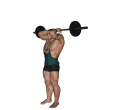 Triceps Extension - Reverse Barbell Close Grip
Triceps Extension - Reverse Barbell Close Grip
Benefits: The exercise eliminates isolates the triceps.
Purpose: This exercise works primarily the triceps.
Beginner Triceps Strength Barbell Push Gym
General Info: The triceps is a straight muscle with three heads. The long head straightens the elbow, adducts the shoulder (brings it from a side position to the body) and extends the shoulder (brings the arm from a front position down to the body). The lateral head (outer head) straightens the elbow. The medial head also straightens the elbow.
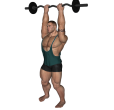 Triceps Extension - Reverse EZ Bar
Triceps Extension - Reverse EZ Bar
Benefits: This exercise works all heads of the triceps.
Purpose: This exercise is used to target the triceps muscle to develop size, definition, strength, endurance and power.
Beginner Triceps Strength EZ Bar Push Gym
General Info: The triceps muscles are straight muscles with three heads. All three heads straighten the elbow while the long head, crossing the shoulder joint also adducts the shoulder (pulls it down from the side) and extends the shoulder (pulls it down from the front).
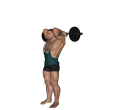 Triceps Extension - Reverse EZ Bar Close Grip
Triceps Extension - Reverse EZ Bar Close Grip
Benefits: This exercise works all heads of the triceps.
Purpose: This exercise is used to target the triceps muscle to develop size, definition, strength, endurance and power.
Beginner Triceps Strength EZ Bar Push Gym
General Info: The triceps muscles are straight muscles with three heads. All three heads straighten the elbow while the long head, crossing the shoulder joint also adducts the shoulder (pulls it down from the side) and extends the shoulder (pulls it down from the front).
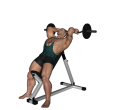 Triceps Extension - Reverse Incline EZ Bar
Triceps Extension - Reverse Incline EZ Bar
Benefits: This exercise works all heads of the triceps.
Purpose: This exercise is used to target the triceps muscle to develop size, definition, strength, endurance and power.
Beginner Triceps Strength EZ Bar Incline Bench Push Gym
General Info: The triceps muscles are straight muscles with three heads. All three heads straighten the elbow while the long head, crossing the shoulder joint also adducts the shoulder (pulls it down from the side) and extends the shoulder (pulls it down from the front).
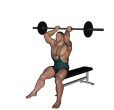 Triceps Extension - Reverse Seated Barbell
Triceps Extension - Reverse Seated Barbell
Benefits: The exercise eliminates isolates the triceps.
Purpose: This exercise works primarily the triceps.
Beginner Triceps Strength Barbell Flat Bench Push Gym
General Info: The triceps is a straight muscle with three heads. The long head straightens the elbow, adducts the shoulder (brings it from a side position to the body) and extends the shoulder (brings the arm from a front position down to the body). The lateral head (outer head) straightens the elbow. The medial head also straightens the elbow.
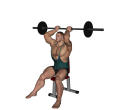 Triceps Extension - Reverse Seated Barbell Close Grip
Triceps Extension - Reverse Seated Barbell Close Grip
Benefits: The exercise eliminates isolates the triceps.
Purpose: This exercise works primarily the triceps.
Beginner Triceps Strength Barbell Flat Bench Push Gym
General Info: The triceps is a straight muscle with three heads. The long head straightens the elbow, adducts the shoulder (brings it from a side position to the body) and extends the shoulder (brings the arm from a front position down to the body). The lateral head (outer head) straightens the elbow. The medial head also straightens the elbow.
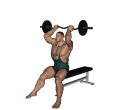 Triceps Extension - Reverse Seated EZ Bar
Triceps Extension - Reverse Seated EZ Bar
Benefits: This exercise works all heads of the triceps.
Purpose: This exercise is used to target the triceps muscle to develop size, definition, strength, endurance and power.
Beginner Triceps Strength EZ Bar Flat Bench Push Gym
General Info: The triceps muscles are straight muscles with three heads. All three heads straighten the elbow while the long head, crossing the shoulder joint also adducts the shoulder (pulls it down from the side) and extends the shoulder (pulls it down from the front).
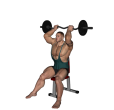 Triceps Extension - Reverse Seated EZ Bar Close Grip
Triceps Extension - Reverse Seated EZ Bar Close Grip
Benefits: This exercise works all heads of the triceps.
Purpose: This exercise is used to target the triceps muscle to develop size, definition, strength, endurance and power.
Beginner Triceps Strength EZ Bar Flat Bench Push Gym
General Info: The triceps muscles are straight muscles with three heads. All three heads straighten the elbow while the long head, crossing the shoulder joint also adducts the shoulder (pulls it down from the side) and extends the shoulder (pulls it down from the front).
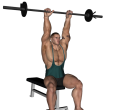 Triceps Extension - Seated Barbell
Triceps Extension - Seated Barbell
Benefits: This exercise works all heads of the triceps.
Purpose: This exercise is used to target the triceps muscle to develop size, definition, strength, endurance and power.
Beginner Triceps Strength Barbell Flat Bench Push Gym
General Info: The triceps muscle group are straight muscles with three heads. All three heads straighten the elbow while the long head, crossing the shoulder joint also adducts the shoulder (pulls it down from the side) and extends the shoulder (pulls it down from the front).
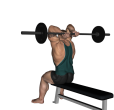 Triceps Extension - Seated Barbell Close Grip
Triceps Extension - Seated Barbell Close Grip
Benefits: This exercise works all heads of the triceps.
Purpose: This exercise is used to target the triceps muscle to develop size, definition, strength, endurance and power.
Beginner Triceps Strength Barbell Flat Bench Push Gym
General Info: The triceps muscle group are straight muscles with three heads. All three heads straighten the elbow while the long head, crossing the shoulder joint also adducts the shoulder (pulls it down from the side) and extends the shoulder (pulls it down from the front).
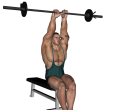 Triceps Extension - Seated Barbell Close Narrow
Triceps Extension - Seated Barbell Close Narrow
Benefits: This exercise works all heads of the triceps.
Purpose: This exercise is used to target the triceps muscle to develop size, definition, strength, endurance and power.
Beginner Triceps Strength Barbell Flat Bench Push Gym
General Info: The triceps muscle group are straight muscles with three heads. All three heads straighten the elbow while the long head, crossing the shoulder joint also adducts the shoulder (pulls it down from the side) and extends the shoulder (pulls it down from the front).
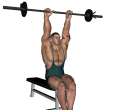 Triceps Extension - Seated Barbell Narrow
Triceps Extension - Seated Barbell Narrow
Benefits: This exercise works all heads of the triceps.
Purpose: This exercise is used to target the triceps muscle to develop size, definition, strength, endurance and power.
Beginner Triceps Strength Barbell Flat Bench Push Gym
General Info: The triceps muscle group are straight muscles with three heads. All three heads straighten the elbow while the long head, crossing the shoulder joint also adducts the shoulder (pulls it down from the side) and extends the shoulder (pulls it down from the front).
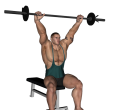 Triceps Extension - Seated Barbell Wide Grip
Triceps Extension - Seated Barbell Wide Grip
Benefits: This exercise works all heads of the triceps.
Purpose: This exercise is used to target the triceps muscle to develop size, definition, strength, endurance and power.
Beginner Triceps Strength Barbell Flat Bench Push Gym
General Info: The triceps muscle group are straight muscles with three heads. All three heads straighten the elbow while the long head, crossing the shoulder joint also adducts the shoulder (pulls it down from the side) and extends the shoulder (pulls it down from the front).
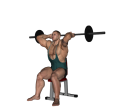 Triceps Extension - Seated Barbell Wide Narrow
Triceps Extension - Seated Barbell Wide Narrow
Benefits: This exercise works all heads of the triceps.
Purpose: This exercise is used to target the triceps muscle to develop size, definition, strength, endurance and power.
Beginner Triceps Strength Barbell Flat Bench Push Gym
General Info: The triceps muscle group are straight muscles with three heads. All three heads straighten the elbow while the long head, crossing the shoulder joint also adducts the shoulder (pulls it down from the side) and extends the shoulder (pulls it down from the front).
 Triceps Extension - Seated Bent 1 Arm Water Bottle
Triceps Extension - Seated Bent 1 Arm Water Bottle
Benefits: This exercise works all heads of the triceps.
Purpose: This exercise is used to target the triceps muscle to develop size, definition, strength, endurance and power.
Beginner Triceps Strength Water Bottle Chair Push Home
General Info: The triceps muscles are straight muscles with three heads. All three heads straighten the elbow while the long head, crossing the shoulder joint also adducts the shoulder (pulls it down from the side) and extends the shoulder (pulls it down from the front).
 Triceps Extension - Seated Bent 2 Arm Water Bottle
Triceps Extension - Seated Bent 2 Arm Water Bottle
Benefits: This exercise works all heads of the triceps.
Purpose: This exercise is used to target the triceps muscle to develop size, definition, strength, endurance and power.
Beginner Triceps Strength Water Bottle Chair Push Home
General Info: The triceps muscles are straight muscles with three heads. All three heads straighten the elbow while the long head, crossing the shoulder joint also adducts the shoulder (pulls it down from the side) and extends the shoulder (pulls it down from the front).
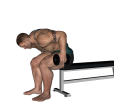 Triceps Extension - Seated Bent Over One Arm Dumbbell
Triceps Extension - Seated Bent Over One Arm Dumbbell
Benefits: This exercise works all heads of the triceps.
Purpose: This exercise is used to target the triceps muscle to develop size, definition, strength, endurance and power.
Beginner Triceps Strength Dumbbell Flat Bench Push Gym
General Info: The triceps muscles are straight muscles with three heads. All three heads straighten the elbow while the long head, crossing the shoulder joint also adducts the shoulder (pulls it down from the side) and extends the shoulder (pulls it down from the front).
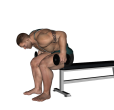 Triceps Extension - Seated Bent Over Two Arm Dumbbell
Triceps Extension - Seated Bent Over Two Arm Dumbbell
Benefits: This exercise works all heads of the triceps.
Purpose: This exercise is used to target the triceps muscle to develop size, definition, strength, endurance and power.
Beginner Triceps Strength Dumbbell Flat Bench Push Gym
General Info: The triceps muscles are straight muscles with three heads. All three heads straighten the elbow while the long head, crossing the shoulder joint also adducts the shoulder (pulls it down from the side) and extends the shoulder (pulls it down from the front).
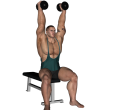 Triceps Extension - Seated Dumbbell
Triceps Extension - Seated Dumbbell
Benefits: This exercise works all heads of the triceps.
Purpose: This exercise is used to target the triceps muscle to develop size, definition, strength, endurance and power.
Beginner Triceps Strength Dumbbell Flat Bench Push Gym
General Info: The triceps muscle group are straight muscles with three heads. All three heads straighten the elbow while the long head, crossing the shoulder joint also adducts the shoulder (pulls it down from the side) and extends the shoulder (pulls it down from the front).
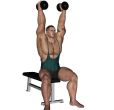 Triceps Extension - Seated Dumbbell Alternate
Triceps Extension - Seated Dumbbell Alternate
Benefits: This exercise works all heads of the triceps.
Purpose: This exercise is used to target the triceps muscle to develop size, definition, strength, endurance and power.
Beginner Triceps Strength Dumbbell Flat Bench Push Gym
General Info: The triceps muscle group are straight muscles with three heads. All three heads straighten the elbow while the long head, crossing the shoulder joint also adducts the shoulder (pulls it down from the side) and extends the shoulder (pulls it down from the front).
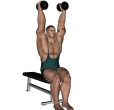 Triceps Extension - Seated Dumbbell Narrow
Triceps Extension - Seated Dumbbell Narrow
Benefits: This exercise works all heads of the triceps.
Purpose: This exercise is used to target the triceps muscle to develop size, definition, strength, endurance and power.
Beginner Triceps Strength Dumbbell Flat Bench Push Gym
General Info: The triceps muscle group are straight muscles with three heads. All three heads straighten the elbow while the long head, crossing the shoulder joint also adducts the shoulder (pulls it down from the side) and extends the shoulder (pulls it down from the front).
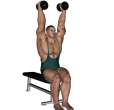 Triceps Extension - Seated Dumbbell Narrow Alternate
Triceps Extension - Seated Dumbbell Narrow Alternate
Benefits: This exercise works all heads of the triceps.
Purpose: This exercise is used to target the triceps muscle to develop size, definition, strength, endurance and power.
Beginner Triceps Strength Dumbbell Flat Bench Push Gym
General Info: The triceps muscle group are straight muscles with three heads. All three heads straighten the elbow while the long head, crossing the shoulder joint also adducts the shoulder (pulls it down from the side) and extends the shoulder (pulls it down from the front).
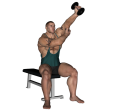 Triceps Extension - Seated Dumbbell Single
Triceps Extension - Seated Dumbbell Single
Benefits: This exercise works all heads of the triceps.
Purpose: This exercise is used to target the triceps muscle to develop size, definition, strength, endurance and power.
Beginner Triceps Strength Dumbbell Flat Bench Push Gym
General Info: The triceps muscle group are straight muscles with three heads. All three heads straighten the elbow while the long head, crossing the shoulder joint also adducts the shoulder (pulls it down from the side) and extends the shoulder (pulls it down from the front).
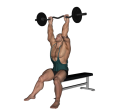 Triceps Extension - Seated EZ Bar
Triceps Extension - Seated EZ Bar
Benefits: This exercise works all heads of the triceps.
Purpose: This exercise is used to target the triceps muscle to develop size, definition, strength, endurance and power.
Beginner Triceps Strength EZ Bar Flat Bench Push Gym
General Info: The triceps muscle group are straight muscles with three heads. All three heads straighten the elbow while the long head, crossing the shoulder joint also adducts the shoulder (pulls it down from the side) and extends the shoulder (pulls it down from the front).
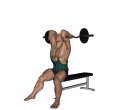 Triceps Extension - Seated EZ Bar Close Grip
Triceps Extension - Seated EZ Bar Close Grip
Benefits: This exercise works all heads of the triceps.
Purpose: This exercise is used to target the triceps muscle to develop size, definition, strength, endurance and power.
Beginner Triceps Strength EZ Bar Flat Bench Push Gym
General Info: The triceps muscle group are straight muscles with three heads. All three heads straighten the elbow while the long head, crossing the shoulder joint also adducts the shoulder (pulls it down from the side) and extends the shoulder (pulls it down from the front).
 Triceps Extension - Seated EZ Bar Close Narrow
Triceps Extension - Seated EZ Bar Close Narrow
Benefits: This exercise works all heads of the triceps.
Purpose: This exercise is used to target the triceps muscle to develop size, definition, strength, endurance and power.
Beginner Triceps Strength EZ Bar Flat Bench Push Gym
General Info: The triceps muscle group are straight muscles with three heads. All three heads straighten the elbow while the long head, crossing the shoulder joint also adducts the shoulder (pulls it down from the side) and extends the shoulder (pulls it down from the front).
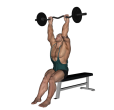 Triceps Extension - Seated EZ Bar Narrow
Triceps Extension - Seated EZ Bar Narrow
Benefits: This exercise works all heads of the triceps.
Purpose: This exercise is used to target the triceps muscle to develop size, definition, strength, endurance and power.
Beginner Triceps Strength EZ Bar Flat Bench Push Gym
General Info: The triceps muscle group are straight muscles with three heads. All three heads straighten the elbow while the long head, crossing the shoulder joint also adducts the shoulder (pulls it down from the side) and extends the shoulder (pulls it down from the front).
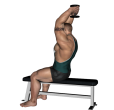 Triceps Extension - Seated One Dumbbell
Triceps Extension - Seated One Dumbbell
Benefits: This exercise works all heads of the triceps.
Purpose: This exercise is used to target the triceps muscle to develop size, definition, strength, endurance and power.
Beginner Triceps Strength Dumbbell Flat Bench Push Gym
General Info: The triceps muscle group are straight muscles with three heads. All three heads straighten the elbow while the long head, crossing the shoulder joint also adducts the shoulder (pulls it down from the side) and extends the shoulder (pulls it down from the front).
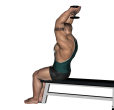 Triceps Extension - Seated One Dumbbell Narrow
Triceps Extension - Seated One Dumbbell Narrow
Benefits: This exercise works all heads of the triceps.
Purpose: This exercise is used to target the triceps muscle to develop size, definition, strength, endurance and power.
Beginner Triceps Strength Dumbbell Flat Bench Push Gym
General Info: The triceps muscle group are straight muscles with three heads. All three heads straighten the elbow while the long head, crossing the shoulder joint also adducts the shoulder (pulls it down from the side) and extends the shoulder (pulls it down from the front).
 Triceps Extension - Seated One Water Bottle
Triceps Extension - Seated One Water Bottle
Benefits: This exercise works all heads of the triceps.
Purpose: This exercise is used to target the triceps muscle to develop size, definition, strength, endurance and power.
Beginner Triceps Strength Water Bottle Chair Push Home
General Info: The triceps muscle group are straight muscles with three heads. All three heads straighten the elbow while the long head, crossing the shoulder joint also adducts the shoulder (pulls it down from the side) and extends the shoulder (pulls it down from the front).
 Triceps Extension - Seated One Water Bottle Narrow
Triceps Extension - Seated One Water Bottle Narrow
Benefits: This exercise works all heads of the triceps.
Purpose: This exercise is used to target the triceps muscle to develop size, definition, strength, endurance and power.
Beginner Triceps Strength Water Bottle Chair Push Home
General Info: The triceps muscle group are straight muscles with three heads. All three heads straighten the elbow while the long head, crossing the shoulder joint also adducts the shoulder (pulls it down from the side) and extends the shoulder (pulls it down from the front).
 Triceps Extension - Seated Plate
Triceps Extension - Seated Plate
Benefits: This exercise works all heads of the triceps.
Purpose: This exercise is used to target the triceps muscle to develop size, definition, strength, endurance and power.
Beginner Triceps Strength Plate Flat Bench Push Gym
General Info: The triceps muscle group are straight muscles with three heads. All three heads straighten the elbow while the long head, crossing the shoulder joint also adducts the shoulder (pulls it down from the side) and extends the shoulder (pulls it down from the front).
 Triceps Extension - Seated Plate Close Grip
Triceps Extension - Seated Plate Close Grip
Benefits: This exercise works all heads of the triceps.
Purpose: This exercise is used to target the triceps muscle to develop size, definition, strength, endurance and power.
Beginner Triceps Strength Plate Flat Bench Push Gym
General Info: The triceps muscle group are straight muscles with three heads. All three heads straighten the elbow while the long head, crossing the shoulder joint also adducts the shoulder (pulls it down from the side) and extends the shoulder (pulls it down from the front).
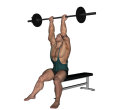 Triceps Extension - Seated Reverse Barbell
Triceps Extension - Seated Reverse Barbell
Benefits: The exercise eliminates isolates the triceps.
Purpose: This exercise works primarily the triceps.
Beginner Triceps Strength Barbell Flat Bench Pull Gym
General Info: The triceps is a straight muscle with three heads. The long head straightens the elbow, adducts the shoulder (brings it from a side position to the body) and extends the shoulder (brings the arm from a front position down to the body). The lateral head (outer head) straightens the elbow. The medial head also straightens the elbow.
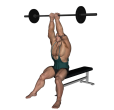 Triceps Extension - Seated Reverse Barbell Close Grip
Triceps Extension - Seated Reverse Barbell Close Grip
Benefits: The exercise eliminates isolates the triceps.
Purpose: This exercise works primarily the triceps.
Beginner Triceps Strength Barbell Flat Bench Pull Gym
General Info: The triceps is a straight muscle with three heads. The long head straightens the elbow, adducts the shoulder (brings it from a side position to the body) and extends the shoulder (brings the arm from a front position down to the body). The lateral head (outer head) straightens the elbow. The medial head also straightens the elbow.
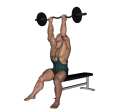 Triceps Extension - Seated Reverse EZ Bar
Triceps Extension - Seated Reverse EZ Bar
Benefits: The exercise eliminates isolates the triceps.
Purpose: This exercise works primarily the triceps.
Beginner Triceps Strength EZ Bar Flat Bench Pull Gym
General Info: The triceps is a straight muscle with three heads. The long head straightens the elbow, adducts the shoulder (brings it from a side position to the body) and extends the shoulder (brings the arm from a front position down to the body). The lateral head (outer head) straightens the elbow. The medial head also straightens the elbow.
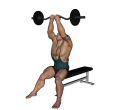 Triceps Extension - Seated Reverse EZ Bar Close Grip
Triceps Extension - Seated Reverse EZ Bar Close Grip
Benefits: The exercise eliminates isolates the triceps.
Purpose: This exercise works primarily the triceps.
Beginner Triceps Strength EZ Bar Flat Bench Pull Gym
General Info: The triceps is a straight muscle with three heads. The long head straightens the elbow, adducts the shoulder (brings it from a side position to the body) and extends the shoulder (brings the arm from a front position down to the body). The lateral head (outer head) straightens the elbow. The medial head also straightens the elbow.
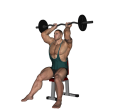 Triceps Extension - Seated Reverse EZ Bar Wide Grip
Triceps Extension - Seated Reverse EZ Bar Wide Grip
Benefits: The exercise eliminates isolates the triceps.
Purpose: This exercise works primarily the triceps.
Beginner Triceps Strength EZ Bar Flat Bench Pull Gym
General Info: The triceps is a straight muscle with three heads. The long head straightens the elbow, adducts the shoulder (brings it from a side position to the body) and extends the shoulder (brings the arm from a front position down to the body). The lateral head (outer head) straightens the elbow. The medial head also straightens the elbow.
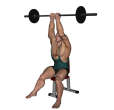 Triceps Extension - Seated Upright Reverse Bar Close
Triceps Extension - Seated Upright Reverse Bar Close
Benefits: The exercise eliminates isolates the triceps.
Purpose: This exercise works primarily the triceps.
Beginner Triceps Strength Barbell Flat Bench Pull Gym
General Info: The triceps is a straight muscle with three heads. The long head straightens the elbow, adducts the shoulder (brings it from a side position to the body) and extends the shoulder (brings the arm from a front position down to the body). The lateral head (outer head) straightens the elbow. The medial head also straightens the elbow.
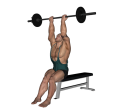 Triceps Extension - Seated Upright Reverse Barbell
Triceps Extension - Seated Upright Reverse Barbell
Benefits: The exercise eliminates isolates the triceps.
Purpose: This exercise works primarily the triceps.
Beginner Triceps Strength Barbell Flat Bench Pull Gym
General Info: The triceps is a straight muscle with three heads. The long head straightens the elbow, adducts the shoulder (brings it from a side position to the body) and extends the shoulder (brings the arm from a front position down to the body). The lateral head (outer head) straightens the elbow. The medial head also straightens the elbow.
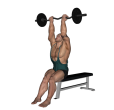 Triceps Extension - Seated Upright Reverse EZ Bar
Triceps Extension - Seated Upright Reverse EZ Bar
Benefits: The exercise eliminates isolates the triceps.
Purpose: This exercise works primarily the triceps.
Beginner Triceps Strength EZ Bar Flat Bench Pull Gym
General Info: The triceps is a straight muscle with three heads. The long head straightens the elbow, adducts the shoulder (brings it from a side position to the body) and extends the shoulder (brings the arm from a front position down to the body). The lateral head (outer head) straightens the elbow. The medial head also straightens the elbow.
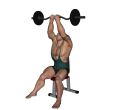 Triceps Extension - Seated Upright Reverse EZ Close
Triceps Extension - Seated Upright Reverse EZ Close
Benefits: The exercise eliminates isolates the triceps.
Purpose: This exercise works primarily the triceps.
Beginner Triceps Strength EZ Bar Flat Bench Pull Gym
General Info: The triceps is a straight muscle with three heads. The long head straightens the elbow, adducts the shoulder (brings it from a side position to the body) and extends the shoulder (brings the arm from a front position down to the body). The lateral head (outer head) straightens the elbow. The medial head also straightens the elbow.
 Triceps Extension - Seated Water Bottle
Triceps Extension - Seated Water Bottle
Benefits: This exercise works all heads of the triceps.
Purpose: This exercise is used to target the triceps muscle to develop size, definition, strength, endurance and power.
Beginner Triceps Strength Water Bottle Chair Push Home
General Info: The triceps muscle group are straight muscles with three heads. All three heads straighten the elbow while the long head, crossing the shoulder joint also adducts the shoulder (pulls it down from the side) and extends the shoulder (pulls it down from the front).
 Triceps Extension - Seated Water Bottle Alternate
Triceps Extension - Seated Water Bottle Alternate
Benefits: This exercise works all heads of the triceps.
Purpose: This exercise is used to target the triceps muscle to develop size, definition, strength, endurance and power.
Beginner Triceps Strength Water Bottle Chair Push Home
General Info: The triceps muscle group are straight muscles with three heads. All three heads straighten the elbow while the long head, crossing the shoulder joint also adducts the shoulder (pulls it down from the side) and extends the shoulder (pulls it down from the front).
 Triceps Extension - Seated Water Bottle Narrow
Triceps Extension - Seated Water Bottle Narrow
Benefits: This exercise works all heads of the triceps.
Purpose: This exercise is used to target the triceps muscle to develop size, definition, strength, endurance and power.
Beginner Triceps Strength Water Bottle Chair Push Home
General Info: The triceps muscle group are straight muscles with three heads. All three heads straighten the elbow while the long head, crossing the shoulder joint also adducts the shoulder (pulls it down from the side) and extends the shoulder (pulls it down from the front).
 Triceps Extension - Seated Water Bottle Narrow Alternate
Triceps Extension - Seated Water Bottle Narrow Alternate
Benefits: This exercise works all heads of the triceps.
Purpose: This exercise is used to target the triceps muscle to develop size, definition, strength, endurance and power.
Beginner Triceps Strength Water Bottle Chair Push Home
General Info: The triceps muscle group are straight muscles with three heads. All three heads straighten the elbow while the long head, crossing the shoulder joint also adducts the shoulder (pulls it down from the side) and extends the shoulder (pulls it down from the front).
 Triceps Extension - Seated Water Bottle Single
Triceps Extension - Seated Water Bottle Single
Benefits: This exercise works all heads of the triceps.
Purpose: This exercise is used to target the triceps muscle to develop size, definition, strength, endurance and power.
Beginner Triceps Strength Water Bottle Chair Push Home
General Info: The triceps muscle group are straight muscles with three heads. All three heads straighten the elbow while the long head, crossing the shoulder joint also adducts the shoulder (pulls it down from the side) and extends the shoulder (pulls it down from the front).
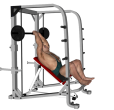 Triceps Extension - Smith Incline Close Grip Reverse
Triceps Extension - Smith Incline Close Grip Reverse
Benefits: The exercise eliminates isolates the triceps.
Purpose: This exercise works primarily the triceps.
Intermediate Triceps Strength Smith Machine Incline Bench Pull Gym
General Info: The triceps is a straight muscle with three heads. The long head straightens the elbow, adducts the shoulder (brings it from a side position to the body) and extends the shoulder (brings the arm from a front position down to the body). The lateral head (outer head) straightens the elbow. The medial head also straightens the elbow.
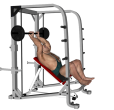 Triceps Extension - Smith Machine Incline
Triceps Extension - Smith Machine Incline
Benefits: The exercise eliminates isolates the triceps.
Purpose: This exercise works primarily the triceps.
Intermediate Triceps Strength Smith Machine Incline Bench Pull Gym
General Info: The triceps is a straight muscle with three heads. The long head straightens the elbow, adducts the shoulder (brings it from a side position to the body) and extends the shoulder (brings the arm from a front position down to the body). The lateral head (outer head) straightens the elbow. The medial head also straightens the elbow.
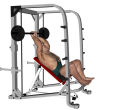 Triceps Extension - Smith Machine Incline Close Grip
Triceps Extension - Smith Machine Incline Close Grip
Benefits: The exercise eliminates isolates the triceps.
Purpose: This exercise works primarily the triceps.
Intermediate Triceps Strength Smith Machine Incline Bench Pull Gym
General Info: The triceps is a straight muscle with three heads. The long head straightens the elbow, adducts the shoulder (brings it from a side position to the body) and extends the shoulder (brings the arm from a front position down to the body). The lateral head (outer head) straightens the elbow. The medial head also straightens the elbow.
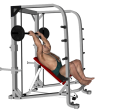 Triceps Extension - Smith Machine Incline Reverse
Triceps Extension - Smith Machine Incline Reverse
Benefits: The exercise eliminates isolates the triceps.
Purpose: This exercise works primarily the triceps.
Intermediate Triceps Strength Smith Machine Incline Bench Pull Gym
General Info: The triceps is a straight muscle with three heads. The long head straightens the elbow, adducts the shoulder (brings it from a side position to the body) and extends the shoulder (brings the arm from a front position down to the body). The lateral head (outer head) straightens the elbow. The medial head also straightens the elbow.
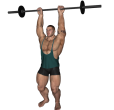 Triceps Extension - Standing Barbell
Triceps Extension - Standing Barbell
Benefits: This exercise works all heads of the triceps.
Purpose: This exercise is used to target the triceps muscle to develop size, definition, strength, endurance and power.
Beginner Triceps Strength Barbell Push Gym
General Info: The triceps muscles are straight muscles with three heads. All three heads straighten the elbow while the long head, crossing the shoulder joint also adducts the shoulder (pulls it down from the side) and extends the shoulder (pulls it down from the front).
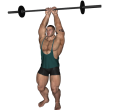 Triceps Extension - Standing Barbell Close Grip
Triceps Extension - Standing Barbell Close Grip
Benefits: This exercise works all heads of the triceps.
Purpose: This exercise is used to target the triceps muscle to develop size, definition, strength, endurance and power.
Beginner Triceps Strength Barbell Push Gym
General Info: The triceps muscles are straight muscles with three heads. All three heads straighten the elbow while the long head, crossing the shoulder joint also adducts the shoulder (pulls it down from the side) and extends the shoulder (pulls it down from the front).
 Triceps Extension - Standing Chain
Triceps Extension - Standing Chain
Benefits: This exercise is done with the addition of chains. The primary function of chains is to accommodate resistance. Chains are also a great means of weight loading (adding more weight to an exercise). Chains are also a great way for working the stabilizers.
Purpose: Benefits This exercise works all heads of the triceps.
Intermediate Triceps Strength Chains Push Gym
General Info: The triceps muscle group are straight muscles with three heads. All three heads straighten the elbow while the long head, crossing the shoulder joint also adducts the shoulder (pulls it down from the side) and extends the shoulder (pulls it down from the front).
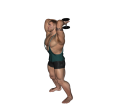 Triceps Extension - Standing Dumbbell
Triceps Extension - Standing Dumbbell
Benefits: This exercise works all heads of the triceps.
Purpose: This exercise is used to target the triceps muscle to develop size, definition, strength, endurance and power.
Beginner Triceps Strength Dumbbell Push Gym
General Info: The triceps muscle group are straight muscles with three heads. All three heads straighten the elbow while the long head, crossing the shoulder joint also adducts the shoulder (pulls it down from the side) and extends the shoulder (pulls it down from the front).
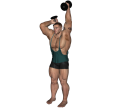 Triceps Extension - Standing Dumbbell Alternate
Triceps Extension - Standing Dumbbell Alternate
Benefits: This exercise works all heads of the triceps.
Purpose: This exercise is used to target the triceps muscle to develop size, definition, strength, endurance and power.
Beginner Triceps Strength Dumbbell Push Gym
General Info: The triceps muscle group are straight muscles with three heads. All three heads straighten the elbow while the long head, crossing the shoulder joint also adducts the shoulder (pulls it down from the side) and extends the shoulder (pulls it down from the front).
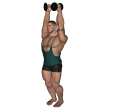 Triceps Extension - Standing Dumbbell Narrow Stance
Triceps Extension - Standing Dumbbell Narrow Stance
Benefits: This exercise works all heads of the triceps.
Purpose: This exercise is used to target the triceps muscle to develop size, definition, strength, endurance and power.
Beginner Triceps Strength Dumbbell Push Gym
General Info: The triceps muscle group are straight muscles with three heads. All three heads straighten the elbow while the long head, crossing the shoulder joint also adducts the shoulder (pulls it down from the side) and extends the shoulder (pulls it down from the front).
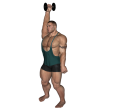 Triceps Extension - Standing Dumbbell Single
Triceps Extension - Standing Dumbbell Single
Benefits: This exercise works all heads of the triceps.
Purpose: This exercise is used to target the triceps muscle to develop size, definition, strength, endurance and power.
Beginner Triceps Strength Dumbbell Push Gym
General Info: The triceps muscle group are straight muscles with three heads. All three heads straighten the elbow while the long head, crossing the shoulder joint also adducts the shoulder (pulls it down from the side) and extends the shoulder (pulls it down from the front).
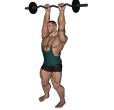 Triceps Extension - Standing EZ Bar
Triceps Extension - Standing EZ Bar
Benefits: This exercise works all heads of the triceps.
Purpose: This exercise is used to target the triceps muscle to develop size, definition, strength, endurance and power.
Beginner Triceps Strength EZ Bar Push Gym
General Info: The triceps muscles are straight muscles with three heads. All three heads straighten the elbow while the long head, crossing the shoulder joint also adducts the shoulder (pulls it down from the side) and extends the shoulder (pulls it down from the front).
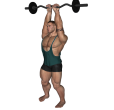 Triceps Extension - Standing EZ Bar Close Grip
Triceps Extension - Standing EZ Bar Close Grip
Benefits: This exercise works all heads of the triceps.
Purpose: This exercise is used to target the triceps muscle to develop size, definition, strength, endurance and power.
Beginner Triceps Strength EZ Bar Push Gym
General Info: The triceps muscles are straight muscles with three heads. All three heads straighten the elbow while the long head, crossing the shoulder joint also adducts the shoulder (pulls it down from the side) and extends the shoulder (pulls it down from the front).
 Triceps Extension - Standing Low Pulley One Arm
Triceps Extension - Standing Low Pulley One Arm
Benefits: This exercise works all heads of the triceps.
Purpose: This exercise is used to target the triceps muscle to develop size, definition, strength, endurance and power.
Intermediate Triceps Shoulders Strength High Low Cable Machine Push Gym
General Info: The triceps muscle group are straight muscles with three heads. All three heads straighten the elbow while the long head, crossing the shoulder joint also adducts the shoulder (pulls it down from the side) and extends the shoulder (pulls it down from the front).
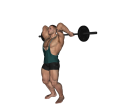 Triceps Extension - Standing Overhead Barbell
Triceps Extension - Standing Overhead Barbell
Benefits: This exercise works all heads of the triceps.
Purpose: This exercise is used to target the triceps muscle to develop size, definition, strength, endurance and power.
Beginner Triceps Strength Barbell Push Gym
General Info: The triceps muscles are straight muscles with three heads. All three heads straighten the elbow while the long head, crossing the shoulder joint also adducts the shoulder (pulls it down from the side) and extends the shoulder (pulls it down from the front).
 Triceps Extension - Standing Plate
Triceps Extension - Standing Plate
Benefits: This exercise works all heads of the triceps.
Purpose: This exercise is used to target the triceps muscle to develop size, definition, strength, endurance and power.
Beginner Triceps Strength Plate Push Gym
General Info: The triceps muscle group are straight muscles with three heads. All three heads straighten the elbow while the long head, crossing the shoulder joint also adducts the shoulder (pulls it down from the side) and extends the shoulder (pulls it down from the front).
 Triceps Extension - Standing Water Bottle
Triceps Extension - Standing Water Bottle
Benefits: This exercise works all heads of the triceps.
Purpose: This exercise is used to target the triceps muscle to develop size, definition, strength, endurance and power.
Beginner Triceps Strength Water Bottle Push Home
General Info: The triceps muscle group are straight muscles with three heads. All three heads straighten the elbow while the long head, crossing the shoulder joint also adducts the shoulder (pulls it down from the side) and extends the shoulder (pulls it down from the front).
 Triceps Extension - Standing Water Bottle Alternate
Triceps Extension - Standing Water Bottle Alternate
Benefits: This exercise works all heads of the triceps.
Purpose: This exercise is used to target the triceps muscle to develop size, definition, strength, endurance and power.
Beginner Triceps Strength Water Bottle Push Home
General Info: The triceps muscle group are straight muscles with three heads. All three heads straighten the elbow while the long head, crossing the shoulder joint also adducts the shoulder (pulls it down from the side) and extends the shoulder (pulls it down from the front).
 Triceps Extension - Standing Water Bottle Narrow
Triceps Extension - Standing Water Bottle Narrow
Benefits: This exercise works all heads of the triceps.
Purpose: This exercise is used to target the triceps muscle to develop size, definition, strength, endurance and power.
Beginner Triceps Strength Water Bottle Push Home
General Info: The triceps muscle group are straight muscles with three heads. All three heads straighten the elbow while the long head, crossing the shoulder joint also adducts the shoulder (pulls it down from the side) and extends the shoulder (pulls it down from the front).
 Triceps Extension - Standing Water Bottle Single
Triceps Extension - Standing Water Bottle Single
Benefits: This exercise works all heads of the triceps.
Purpose: This exercise is used to target the triceps muscle to develop size, definition, strength, endurance and power.
Beginner Triceps Strength Water Bottle Push Home
General Info: The triceps muscle group are straight muscles with three heads. All three heads straighten the elbow while the long head, crossing the shoulder joint also adducts the shoulder (pulls it down from the side) and extends the shoulder (pulls it down from the front).
 Triceps Extension - Suspended Chains
Triceps Extension - Suspended Chains
Benefits: This exercise is done with the addition of chains. The primary function of chains is to accommodate resistance. Chains are also a great means of weight loading (adding more weight to an exercise). Chains are also a great way for working the stabilizers.
Purpose: Benefits This exercise works all heads of the triceps.
Beginner Triceps Strength Chains Push Gym
General Info: The triceps muscle group are straight muscles with three heads. All three heads straighten the elbow while the long head, crossing the shoulder joint also adducts the shoulder (pulls it down from the side) and extends the shoulder (pulls it down from the front).
 Triceps Extension - Tube Ball Single Reverse
Triceps Extension - Tube Ball Single Reverse
Benefits: This exercise works all heads of the triceps.
Purpose: This exercise is used to target the triceps muscle to develop size, definition, strength, endurance and power.
Beginner Triceps Strength Resistance Tube Fitness Ball Push Gym
General Info: The triceps muscle group are straight muscles with three heads. All three heads straighten the elbow while the long head, crossing the shoulder joint also adducts the shoulder (pulls it down from the side) and extends the shoulder (pulls it down from the front).
 Triceps Extension - Water Bottle 2 Handed
Triceps Extension - Water Bottle 2 Handed
Benefits: This exercise works all heads of the triceps.
Purpose: This exercise is used to target the triceps muscle to develop size, definition, strength, endurance and power.
Beginner Triceps Strength Water Bottle Push Home
General Info: The triceps muscle group are straight muscles with three heads. All three heads straighten the elbow while the long head, crossing the shoulder joint also adducts the shoulder (pulls it down from the side) and extends the shoulder (pulls it down from the front).
 Triceps Extension - Water Bottle Single
Triceps Extension - Water Bottle Single
Benefits: This exercise works all heads of the triceps.
Purpose: This exercise is used to target the triceps muscle to develop size, definition, strength, endurance and power.
Beginner Triceps Strength Water Bottle Push Home
General Info: The triceps muscle group are straight muscles with three heads. All three heads straighten the elbow while the long head, crossing the shoulder joint also adducts the shoulder (pulls it down from the side) and extends the shoulder (pulls it down from the front).
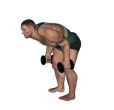 Triceps Kickback - Bent Over Dumbbell
Triceps Kickback - Bent Over Dumbbell
Benefits: This exercise works all heads of the triceps.
Purpose: This exercise is used to target the triceps muscle to develop size, definition, strength, endurance and power.
Beginner Triceps Strength Dumbbell Push Gym
General Info: The triceps muscles are straight muscles with three heads. All three heads straighten the elbow while the long head, crossing the shoulder joint also adducts the shoulder (pulls it down from the side) and extends the shoulder (pulls it down from the front).
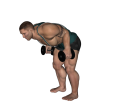 Triceps Kickback - Bent Over Dumbbell Alternate
Triceps Kickback - Bent Over Dumbbell Alternate
Benefits: This exercise works all heads of the triceps.
Purpose: This exercise is used to target the triceps muscle to develop size, definition, strength, endurance and power.
Beginner Triceps Strength Dumbbell Push Gym
General Info: The triceps muscles are straight muscles with three heads. All three heads straighten the elbow while the long head, crossing the shoulder joint also adducts the shoulder (pulls it down from the side) and extends the shoulder (pulls it down from the front).
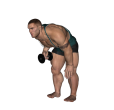 Triceps Kickback - Bent Over Dumbbell Single
Triceps Kickback - Bent Over Dumbbell Single
Benefits: This exercise works all heads of the triceps.
Purpose: This exercise is used to target the triceps muscle to develop size, definition, strength, endurance and power.
Beginner Triceps Strength Dumbbell Push Gym
General Info: The triceps muscles are straight muscles with three heads. All three heads straighten the elbow while the long head, crossing the shoulder joint also adducts the shoulder (pulls it down from the side) and extends the shoulder (pulls it down from the front).
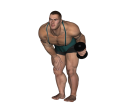 Triceps Kickback - Bent Over Single Dumbbell Narrow
Triceps Kickback - Bent Over Single Dumbbell Narrow
Benefits: This exercise works all heads of the triceps.
Purpose: This exercise is used to target the triceps muscle to develop size, definition, strength, endurance and power.
Beginner Triceps Strength Dumbbell Push Gym
General Info: The triceps muscles are straight muscles with three heads. All three heads straighten the elbow while the long head, crossing the shoulder joint also adducts the shoulder (pulls it down from the side) and extends the shoulder (pulls it down from the front).
 Triceps Kickback - Bent Over Water Bottle
Triceps Kickback - Bent Over Water Bottle
Benefits: This exercise works all heads of the triceps.
Purpose: This exercise is used to target the triceps muscle to develop size, definition, strength, endurance and power.
Beginner Triceps Strength Water Bottle Push Home
General Info: The triceps muscles are straight muscles with three heads. All three heads straighten the elbow while the long head, crossing the shoulder joint also adducts the shoulder (pulls it down from the side) and extends the shoulder (pulls it down from the front).
 Triceps Kickback - Bent Over Water Bottle Alternate
Triceps Kickback - Bent Over Water Bottle Alternate
Benefits: This exercise works all heads of the triceps.
Purpose: This exercise is used to target the triceps muscle to develop size, definition, strength, endurance and power.
Beginner Triceps Strength Water Bottle Push Home
General Info: The triceps muscles are straight muscles with three heads. All three heads straighten the elbow while the long head, crossing the shoulder joint also adducts the shoulder (pulls it down from the side) and extends the shoulder (pulls it down from the front).
 Triceps Kickback - Bent Over Water Bottle Single
Triceps Kickback - Bent Over Water Bottle Single
Benefits: This exercise works all heads of the triceps.
Purpose: This exercise is used to target the triceps muscle to develop size, definition, strength, endurance and power.
Beginner Triceps Strength Water Bottle Push Home
General Info: The triceps muscles are straight muscles with three heads. All three heads straighten the elbow while the long head, crossing the shoulder joint also adducts the shoulder (pulls it down from the side) and extends the shoulder (pulls it down from the front).
 Triceps Kickback - Bent Water Bottle Single Narrow
Triceps Kickback - Bent Water Bottle Single Narrow
Benefits: This exercise works all heads of the triceps.
Purpose: This exercise is used to target the triceps muscle to develop size, definition, strength, endurance and power.
Beginner Triceps Strength Water Bottle Push Home
General Info: The triceps muscles are straight muscles with three heads. All three heads straighten the elbow while the long head, crossing the shoulder joint also adducts the shoulder (pulls it down from the side) and extends the shoulder (pulls it down from the front).
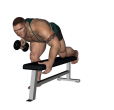 Triceps Kickback - Dumbbell Inwards
Triceps Kickback - Dumbbell Inwards
Benefits: This exercise works all heads of the triceps.
Purpose: This exercise is used to target the triceps muscle to develop size, definition, strength, endurance and power.
Beginner Triceps Strength Dumbbell Flat Bench Push Gym
General Info: The triceps muscles are straight muscles with three heads. All three heads straighten the elbow while the long head, crossing the shoulder joint also adducts the shoulder (pulls it down from the side) and extends the shoulder (pulls it down from the front).
 Triceps Kickback - Resistance Tube
Triceps Kickback - Resistance Tube
Benefits: This exercise works all heads of the triceps.
Purpose: This exercise is used to target the triceps muscle to develop size, definition, strength, endurance and power.
Beginner Triceps Strength Resistance Tube Push Gym
General Info: The triceps muscles are straight muscles with three heads. All three heads straighten the elbow while the long head, crossing the shoulder joint also adducts the shoulder (pulls it down from the side) and extends the shoulder (pulls it down from the front).
 Triceps Kickback - Resistance Tube Reverse
Triceps Kickback - Resistance Tube Reverse
Benefits: This exercise works all heads of the triceps.
Purpose: This exercise is used to target the triceps muscle to develop size, definition, strength, endurance and power.
Beginner Triceps Strength Resistance Tube Push Gym
General Info: The triceps muscles are straight muscles with three heads. All three heads straighten the elbow while the long head, crossing the shoulder joint also adducts the shoulder (pulls it down from the side) and extends the shoulder (pulls it down from the front).
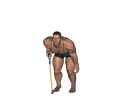 Triceps Kickback - Resistance Tube Single
Triceps Kickback - Resistance Tube Single
Benefits: This exercise works all heads of the triceps.
Purpose: This exercise is used to target the triceps muscle to develop size, definition, strength, endurance and power.
Beginner Triceps Strength Resistance Tube Push Gym
General Info: The triceps muscles are straight muscles with three heads. All three heads straighten the elbow while the long head, crossing the shoulder joint also adducts the shoulder (pulls it down from the side) and extends the shoulder (pulls it down from the front).
 Triceps Kickback - Resistance Tube Single Reverse
Triceps Kickback - Resistance Tube Single Reverse
Benefits: This exercise works all heads of the triceps.
Purpose: This exercise is used to target the triceps muscle to develop size, definition, strength, endurance and power.
Beginner Triceps Strength Resistance Tube Push Gym
General Info: The triceps muscles are straight muscles with three heads. All three heads straighten the elbow while the long head, crossing the shoulder joint also adducts the shoulder (pulls it down from the side) and extends the shoulder (pulls it down from the front).
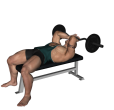 Triceps Press - Lying
Triceps Press - Lying
Benefits: This exercise works all heads of the triceps.
Purpose: This exercise is used to target the triceps muscle to develop size, definition, strength, endurance and power.
Beginner Triceps Strength EZ Bar Flat Bench Push Gym
General Info: The triceps muscles are straight muscles with three heads. All three heads straighten the elbow while the long head, crossing the shoulder joint also adducts the shoulder (pulls it down from the side) and extends the shoulder (pulls it down from the front).
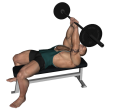 Triceps Press - Lying Close Grip Barbell To Chin
Triceps Press - Lying Close Grip Barbell To Chin
Benefits: This exercise works all heads of the triceps with a heavier weight than can typically be done with dumbbells.
Purpose: This exercise is used to target the triceps muscle to develop size, definition, strength, endurance and power.
Beginner Triceps Chest Strength Barbell Flat Bench Push Gym
General Info: Typically a bench press is considered to be a chest exercise. However, when the hands are placed in a close grip, it works the triceps muscles more. The closer the grip, the more the triceps are worked.
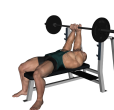 Triceps Press - Reverse Lying
Triceps Press - Reverse Lying
Benefits: This exercise works all heads of the triceps.
Purpose: This exercise is used to target the triceps muscle to develop size, definition, strength, endurance and power.
Beginner Triceps Strength Barbell Flat Bench Push Gym
General Info: The triceps muscles are straight muscles with three heads. All three heads straighten the elbow while the long head, crossing the shoulder joint also adducts the shoulder (pulls it down from the side) and extends the shoulder (pulls it down from the front).
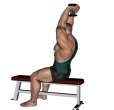 Triceps Press - Seated Dumbbell
Triceps Press - Seated Dumbbell
Benefits: The exercise eliminates isolates the triceps.
Purpose: This exercise works primarily the triceps.
Beginner Triceps Lats Strength Dumbbell Flat Bench Pull Gym
General Info: The triceps is a straight muscle with three heads. The long head straightens the elbow, adducts the shoulder (brings it from a side position to the body) and extends the shoulder (brings the arm from a front position down to the body). The lateral head (outer head) straightens the elbow. The medial head also straightens the elbow.
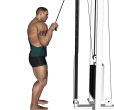 Triceps Push Down - Basic
Triceps Push Down - Basic
Benefits: This exercise works the inner heads of the triceps.
Purpose: This exercise is used to target the triceps muscle to develop size, definition, strength, endurance and power.
Beginner Triceps Lats Abdominals Strength Lat Pulldown Push Gym
General Info: The triceps muscles are straight muscles with three heads. All three heads straighten the elbow while the long head, crossing the shoulder joint also adducts the shoulder (pulls it down from the side) and extends the shoulder (pulls it down from the front).
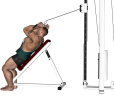 Triceps Push Down - Cable Incline
Triceps Push Down - Cable Incline
Benefits: This exercise works the inner heads of the triceps.
Purpose: This exercise is used to target the triceps muscle to develop size, definition, strength, endurance and power.
Beginner Triceps Lats Abdominals Strength High Low Cable Machine Incline Bench Push Gym
General Info: The triceps muscles are straight muscles with three heads. All three heads straighten the elbow while the long head, crossing the shoulder joint also adducts the shoulder (pulls it down from the side) and extends the shoulder (pulls it down from the front).
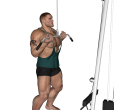 Triceps Push Down - Cable Reverse
Triceps Push Down - Cable Reverse
Benefits: This exercise works all heads of the triceps, but focusing on the lateral head.
Purpose: This exercise is used to target the triceps muscle to develop size, definition, strength, endurance and power.
Beginner Triceps Lats Abdominals Strength High Low Cable Machine Pull Gym
General Info: The triceps is a straight muscle with three heads. The long head straightens the elbow, adducts the shoulder (brings it from a side position to the body) and extends the shoulder (brings the arm from a front position down to the body). The lateral head (outer head) straightens the elbow. The medial head also straightens the elbow.
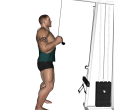 Triceps Push Down - Rope Attachment
Triceps Push Down - Rope Attachment
Benefits: This exercise works the outer heads of the triceps.
Purpose: This exercise is used to target the triceps muscle to develop size, definition, strength, endurance and power.
Beginner Triceps Lats Abdominals Strength High Low Cable Machine Cable Rope Attachment Push Gym
General Info: The triceps muscle group are straight muscles with three heads. All three heads straighten the elbow while the long head, crossing the shoulder joint also adducts the shoulder (pulls it down from the side) and extends the shoulder (pulls it down from the front).
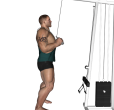 Triceps Push Down - V Bar Attachment
Triceps Push Down - V Bar Attachment
Benefits: This exercise works the outer heads of the triceps.
Purpose: This exercise is used to target the triceps muscle to develop size, definition, strength, endurance and power.
Beginner Triceps Lats Abdominals Strength High Low Cable Machine V-Bar Handle Push Gym
General Info: The triceps muscle group are straight muscles with three heads. All three heads straighten the elbow while the long head, crossing the shoulder joint also adducts the shoulder (pulls it down from the side) and extends the shoulder (pulls it down from the front).
Could not find your favorite exercise in the list? Please start a discussion and post the name and the list of steps. We will try to add it as soon as we can.